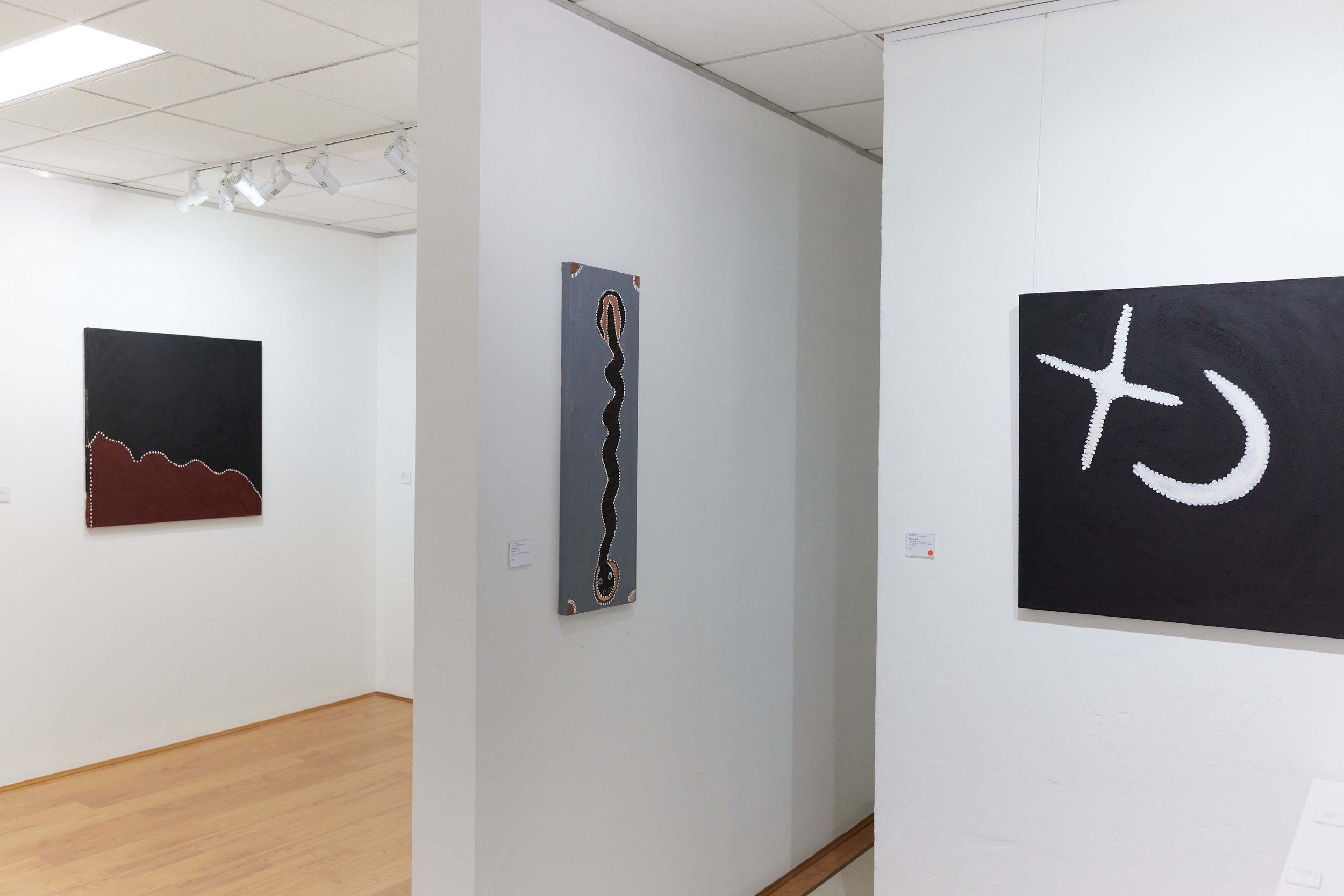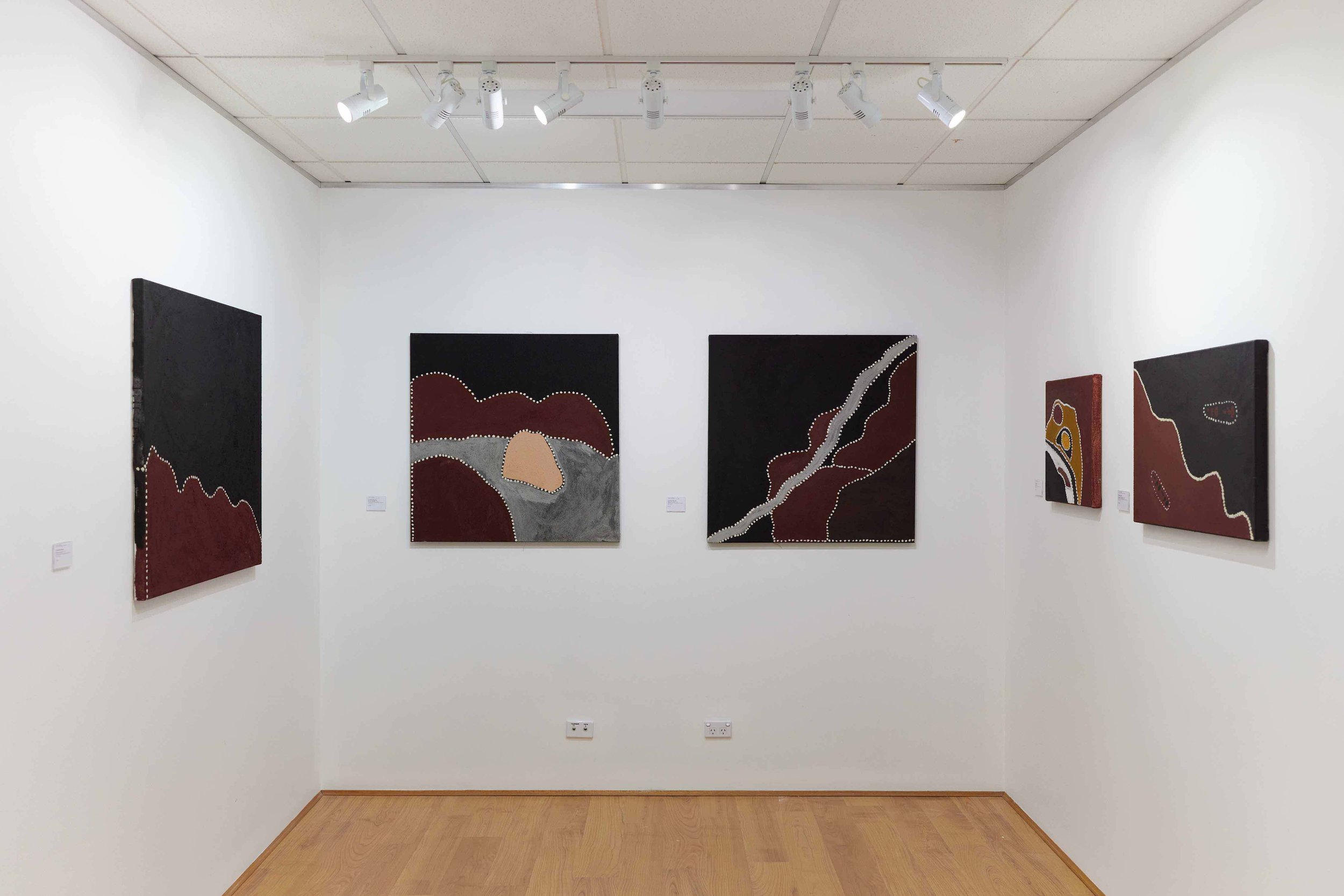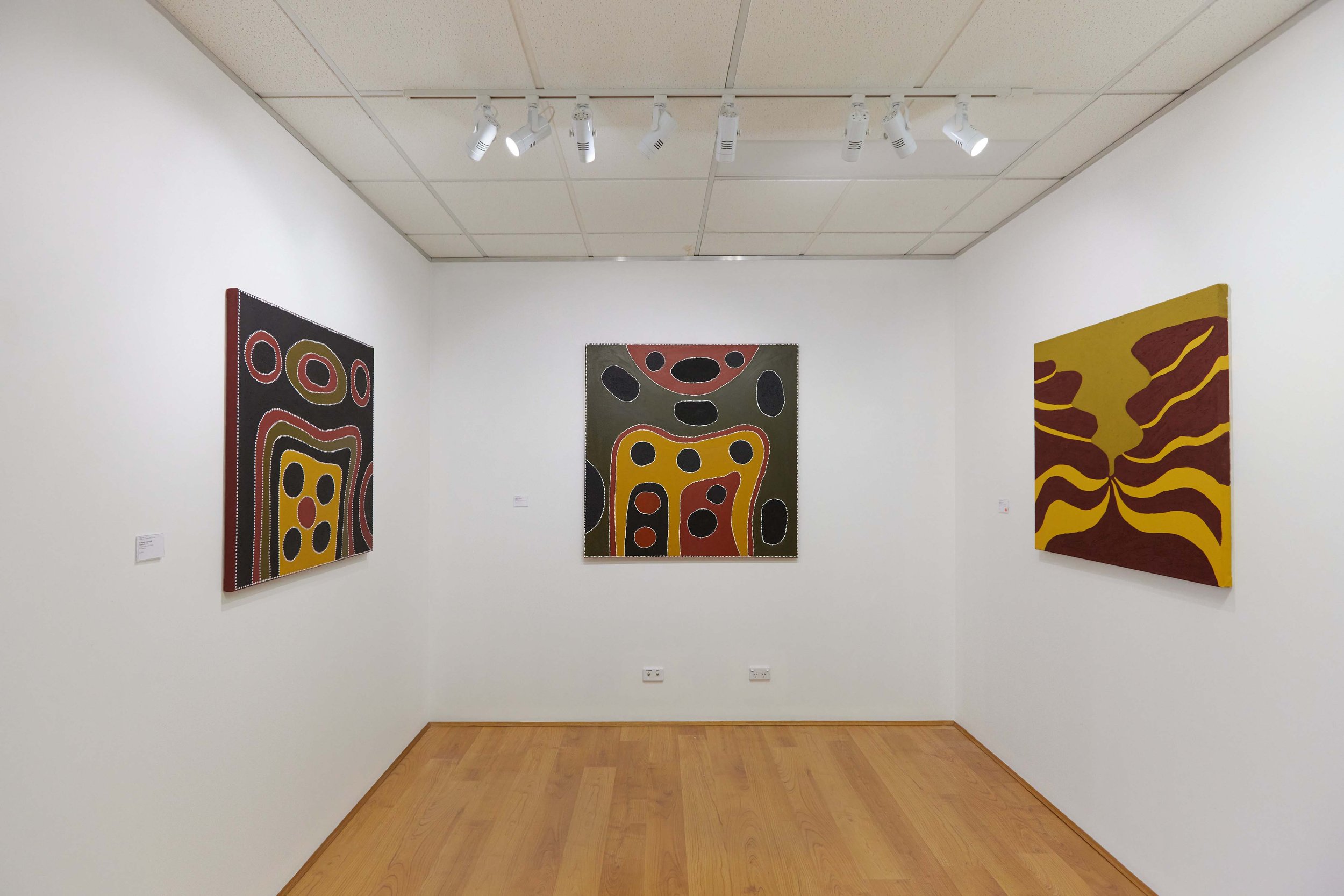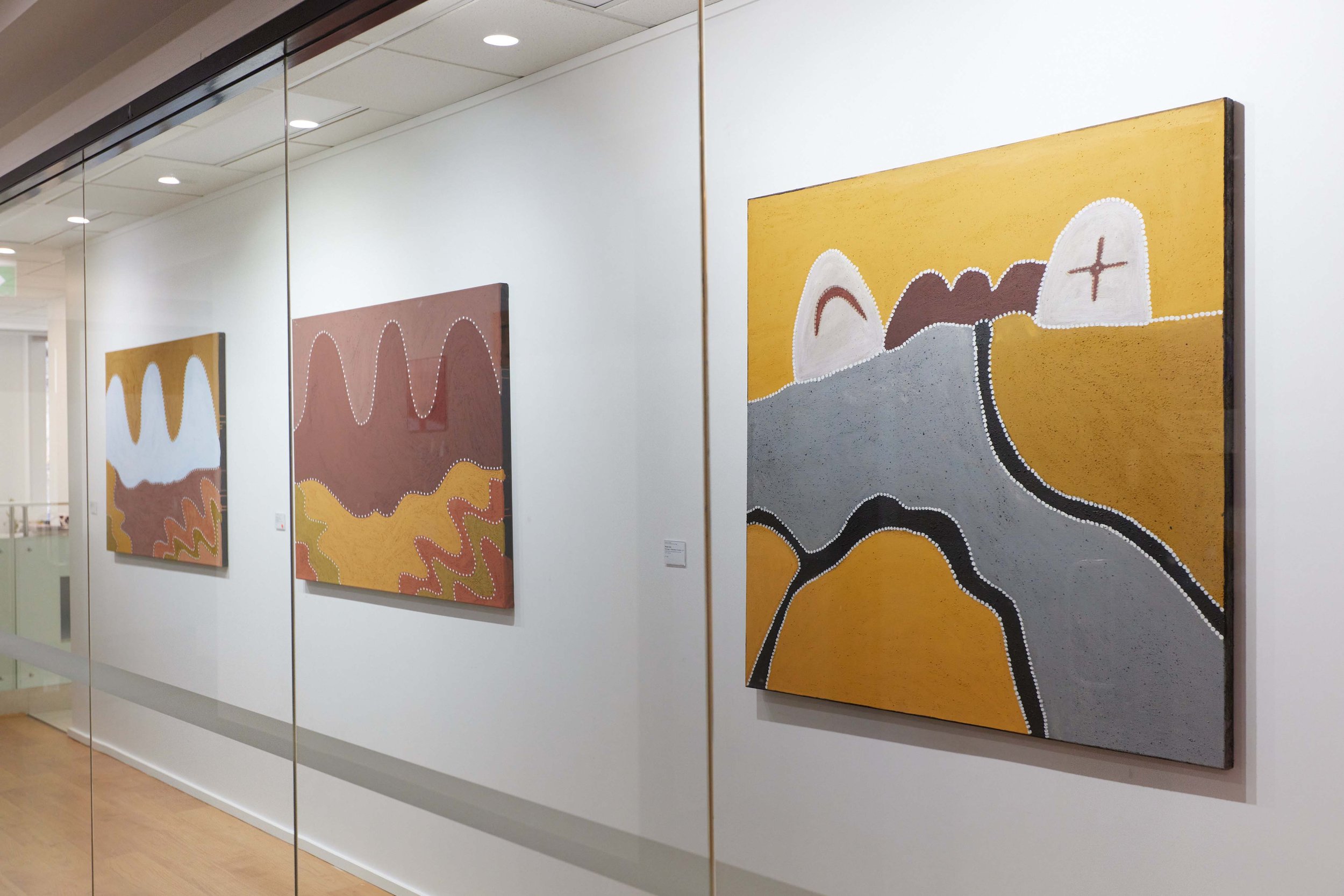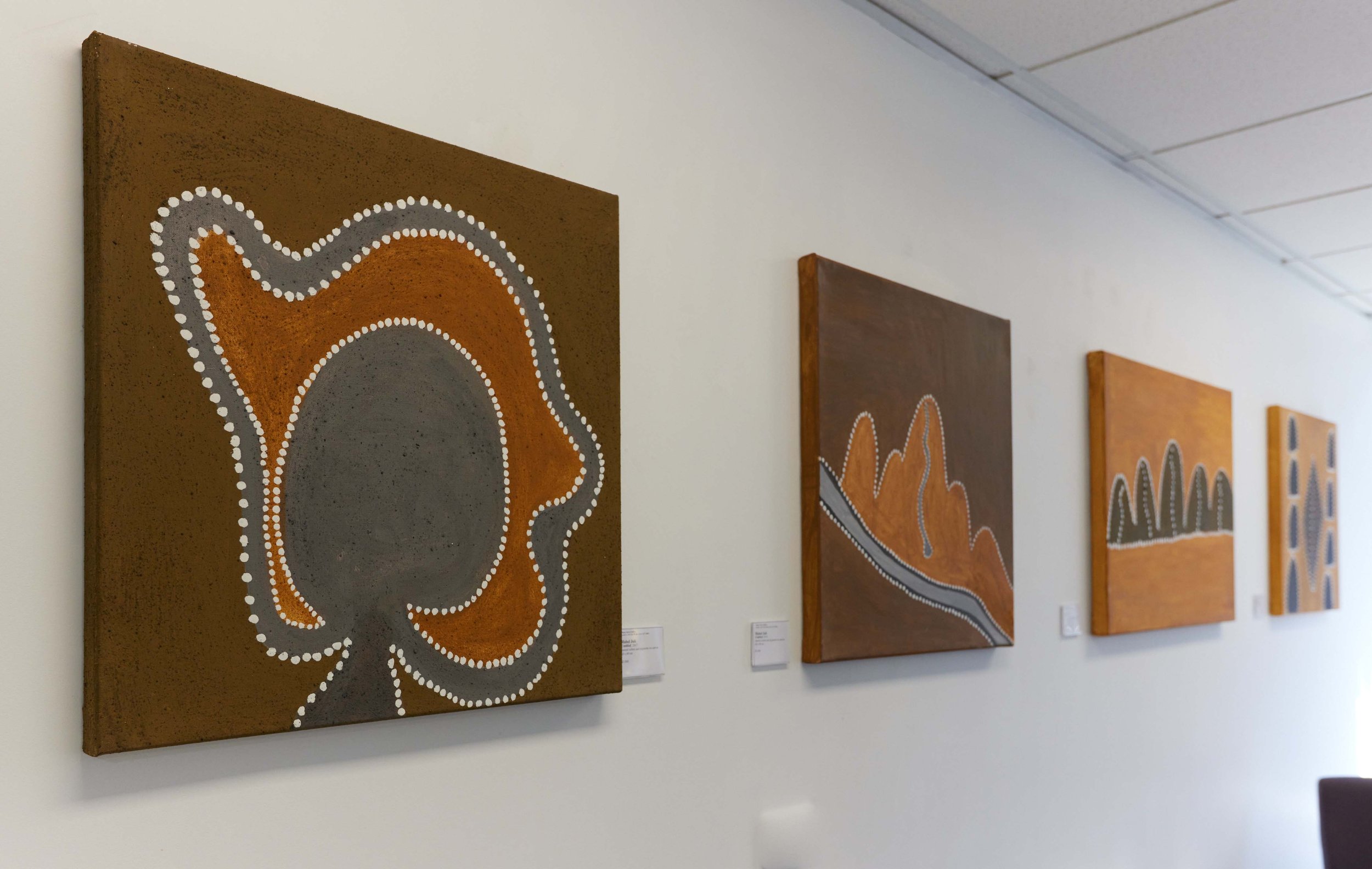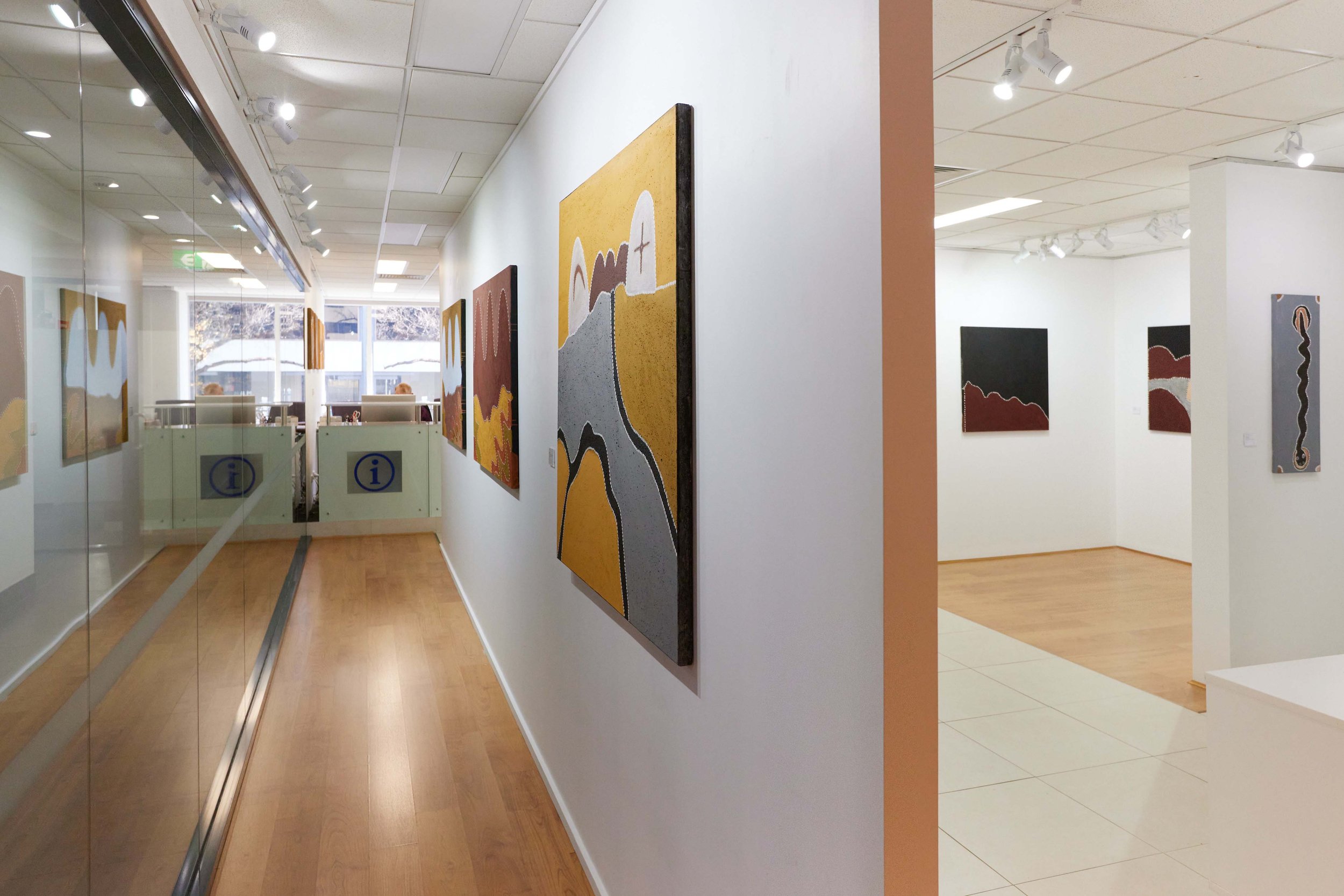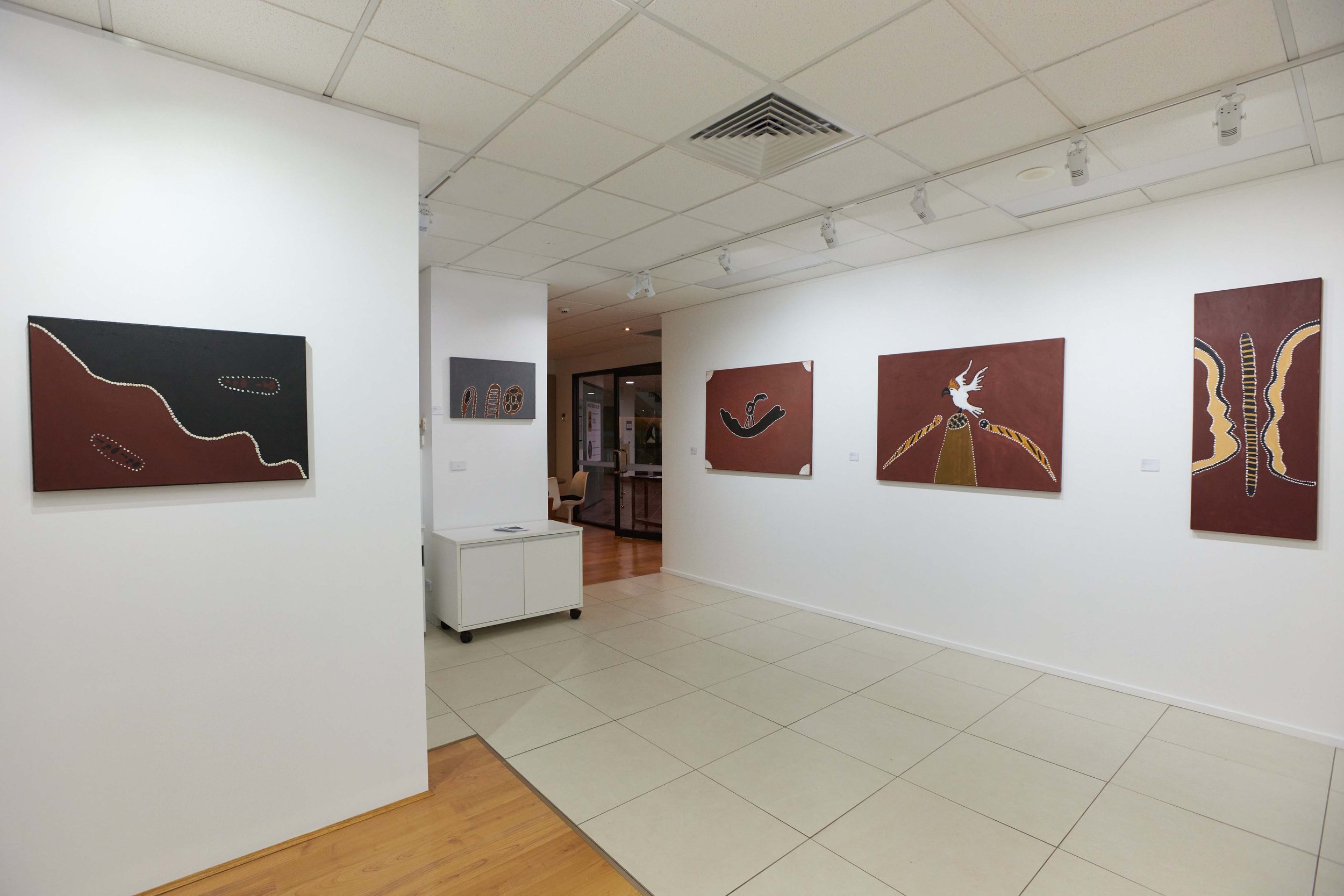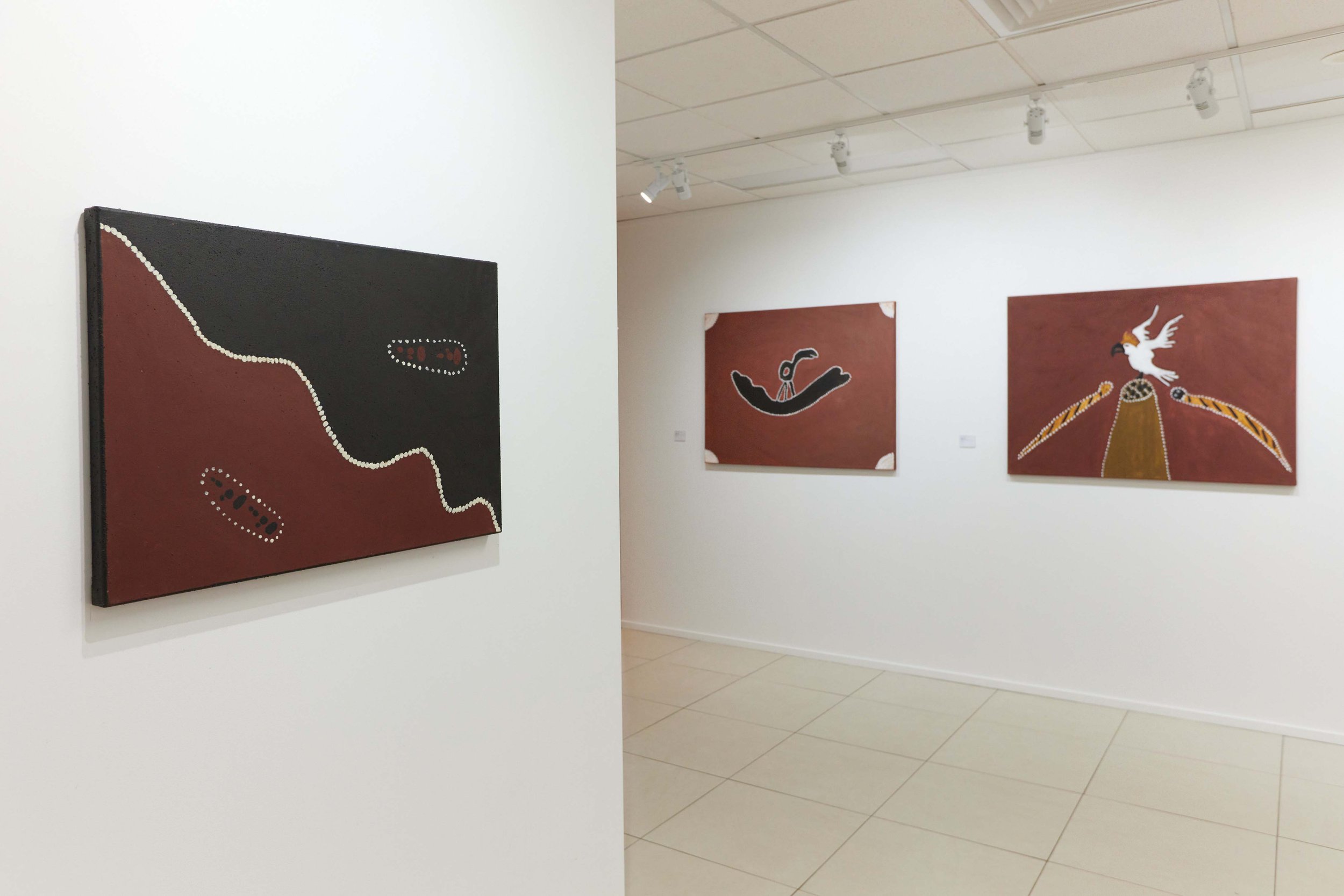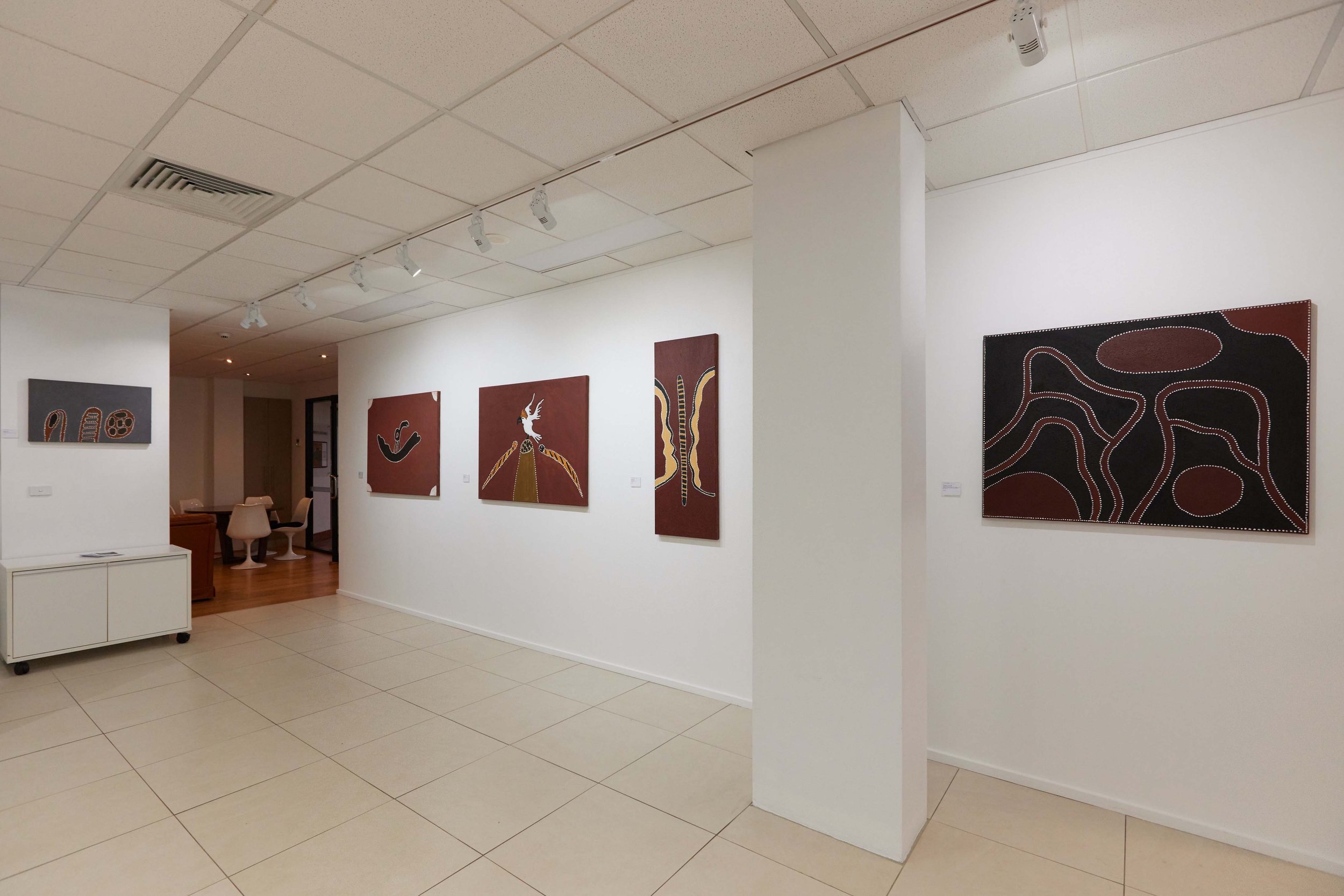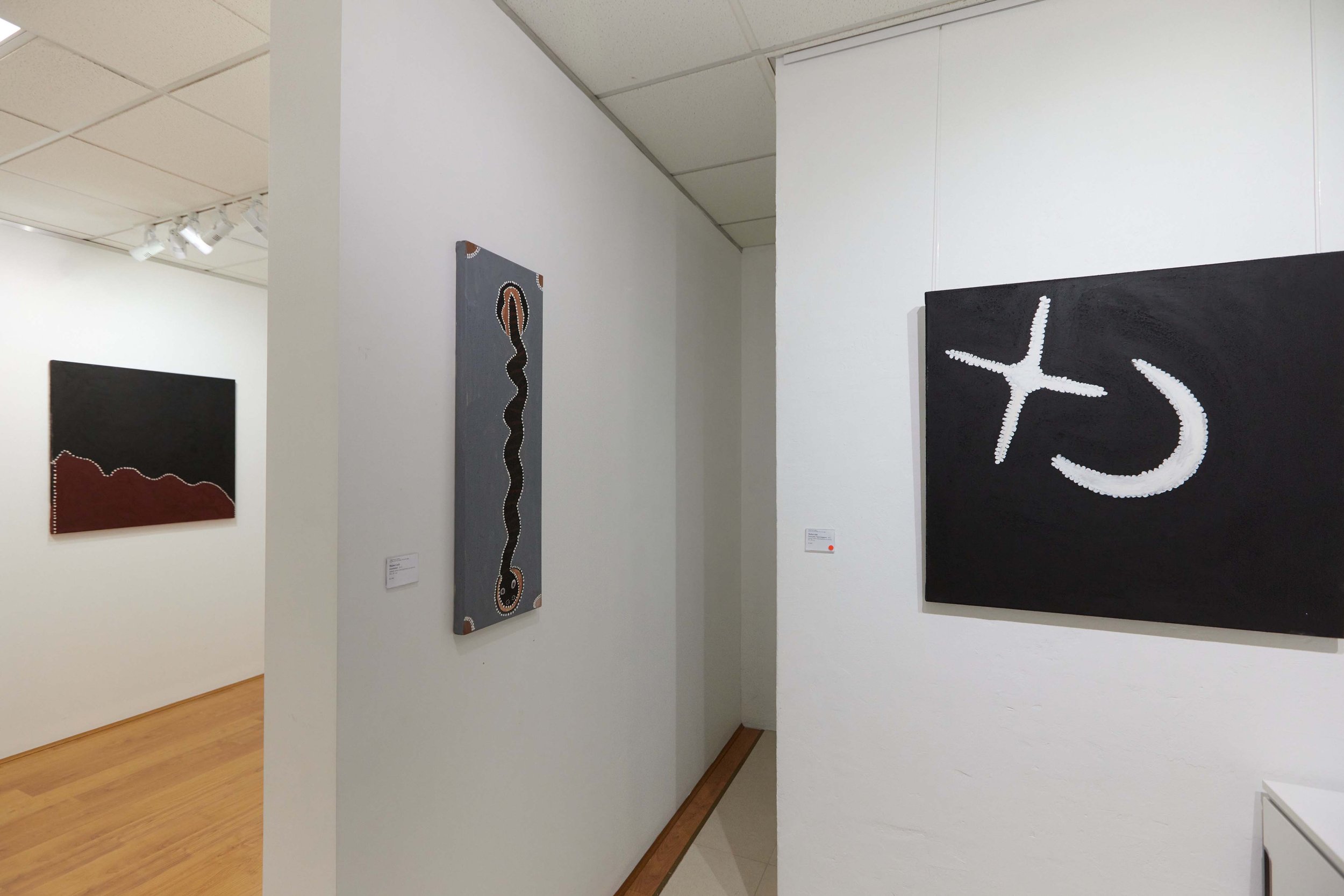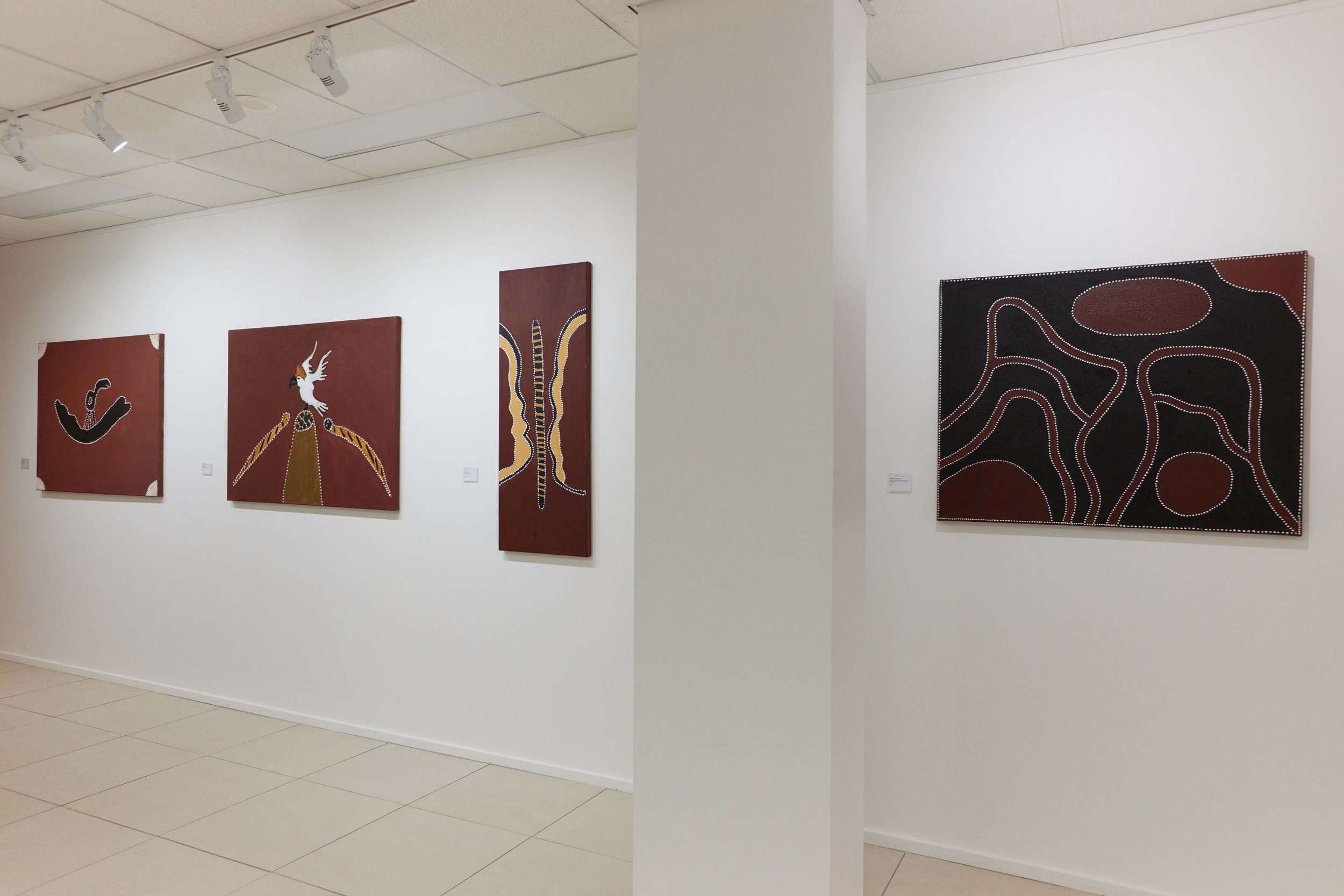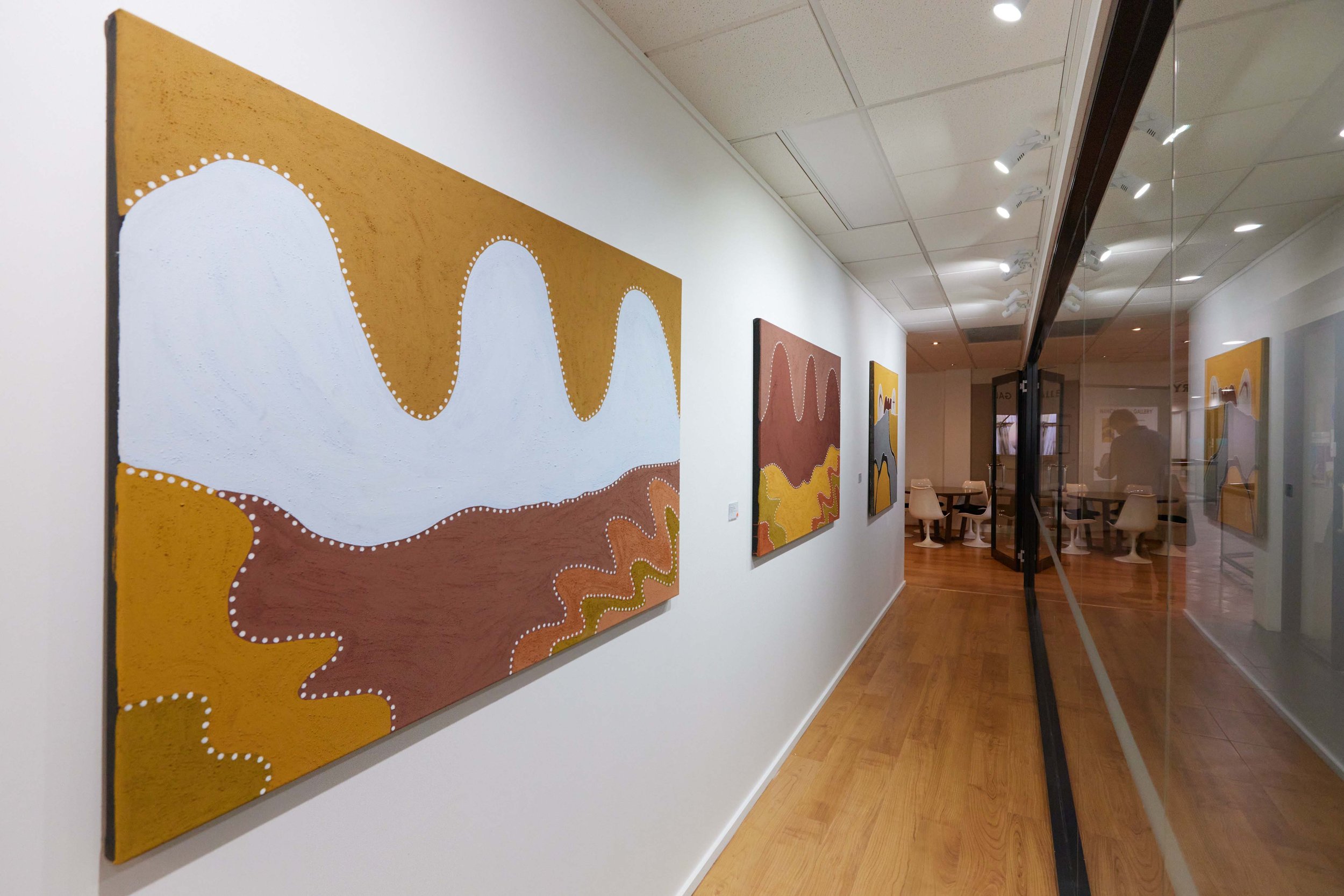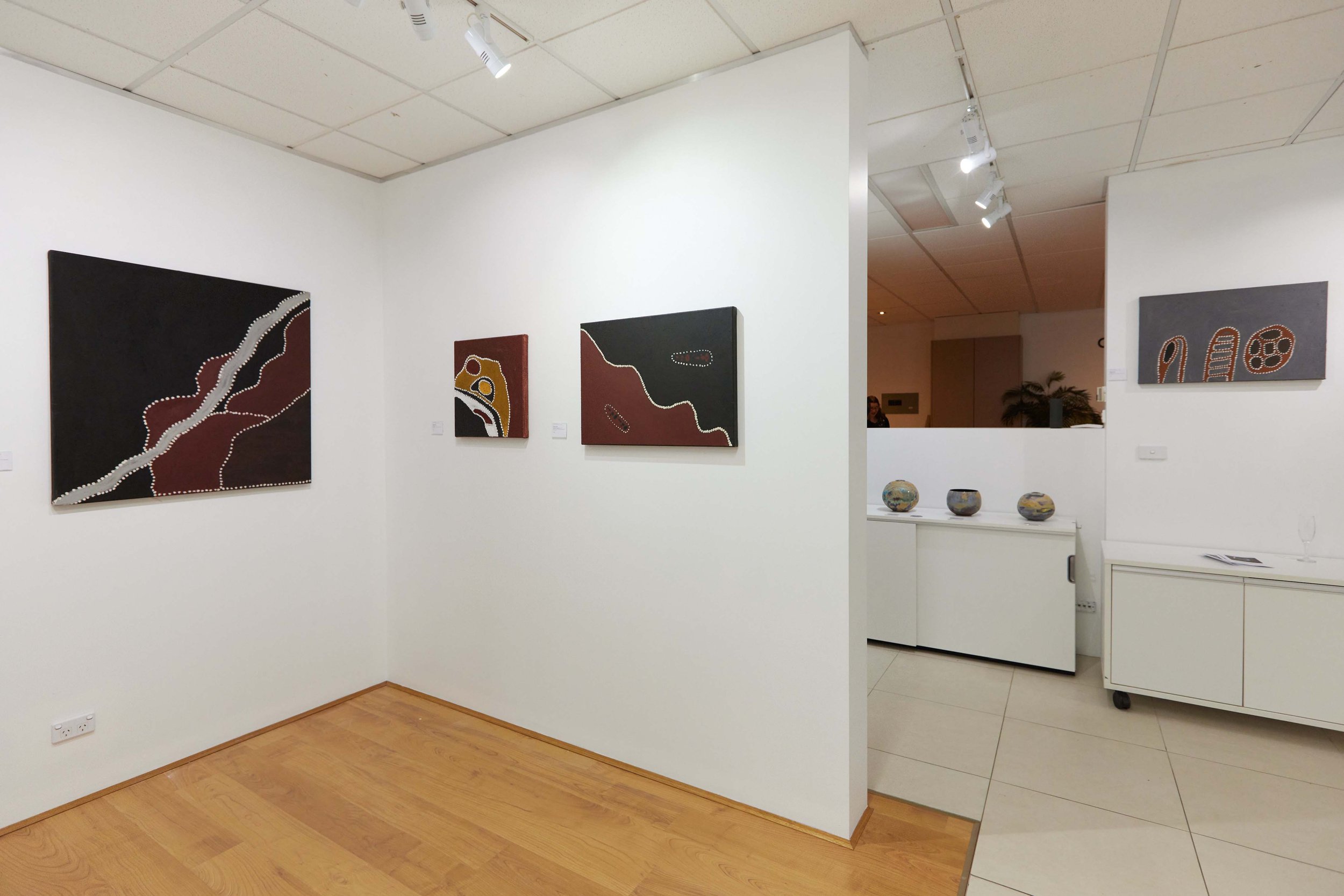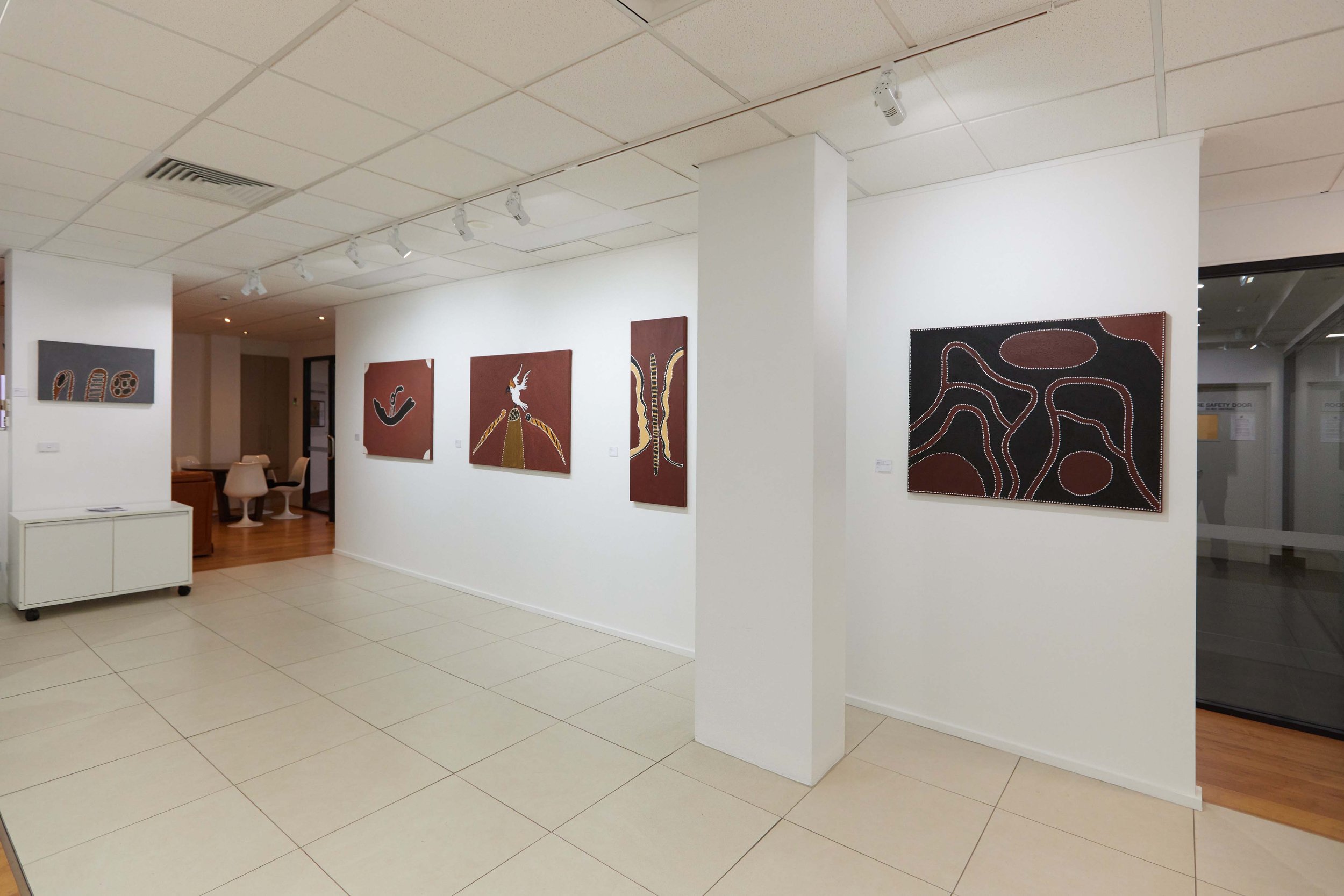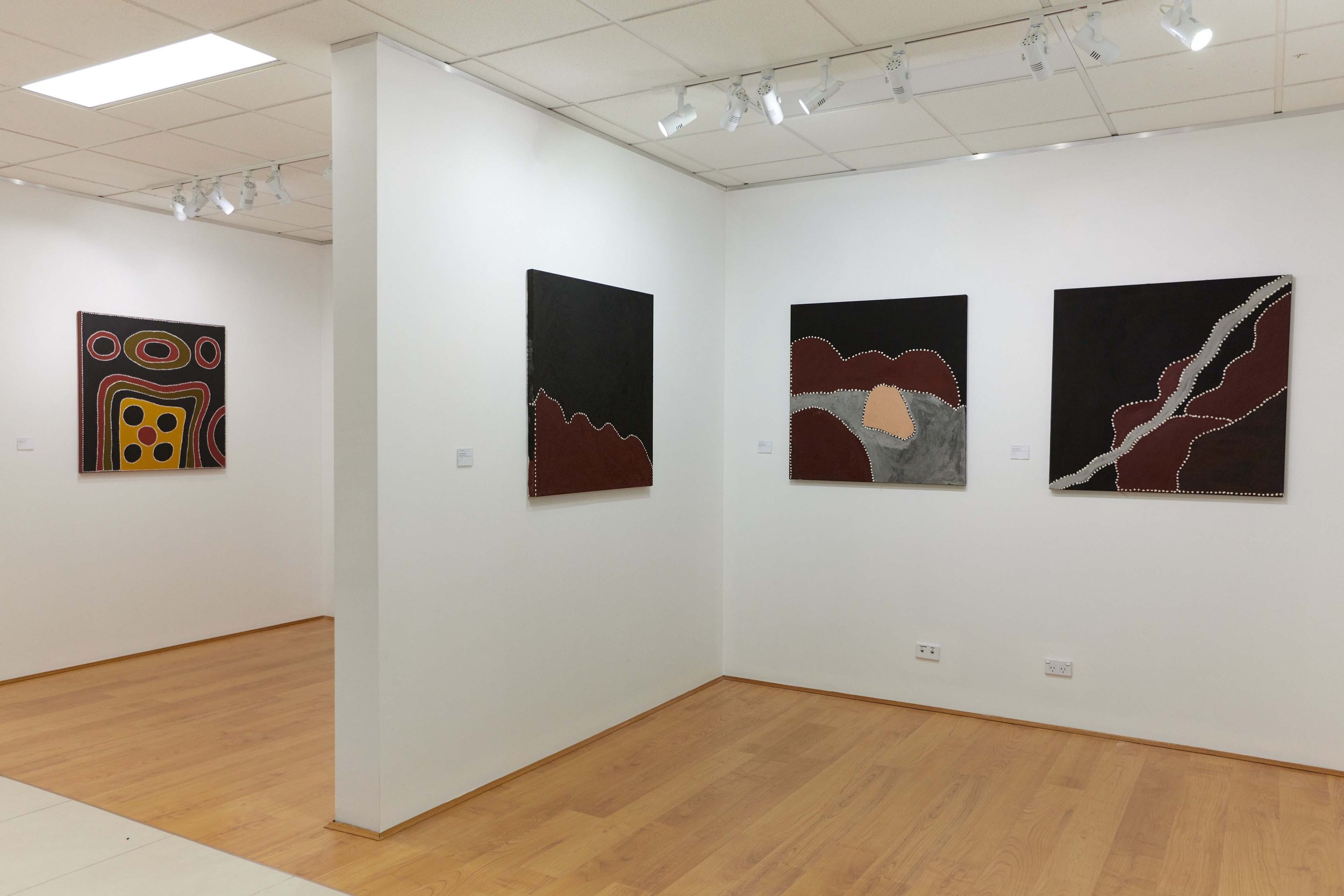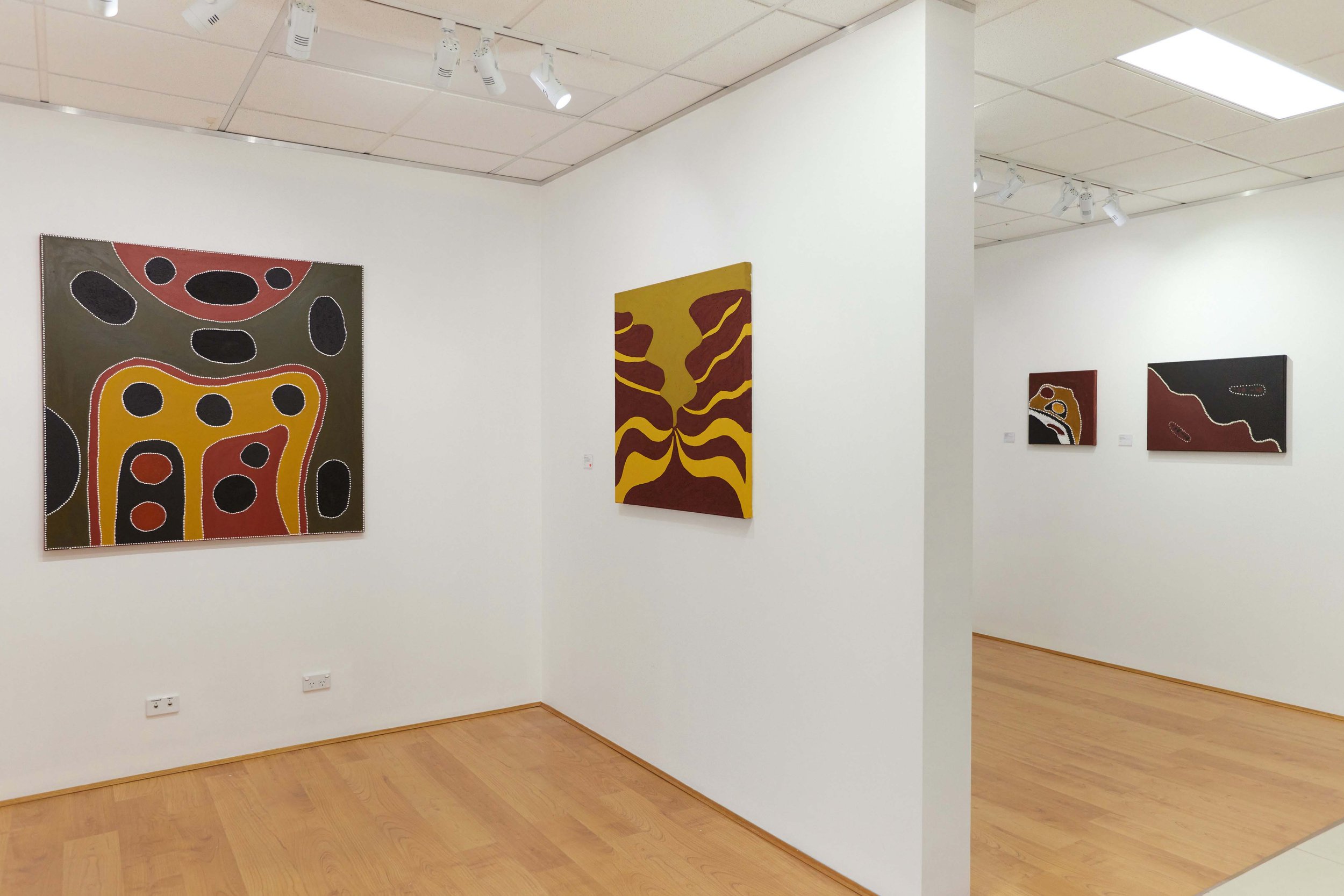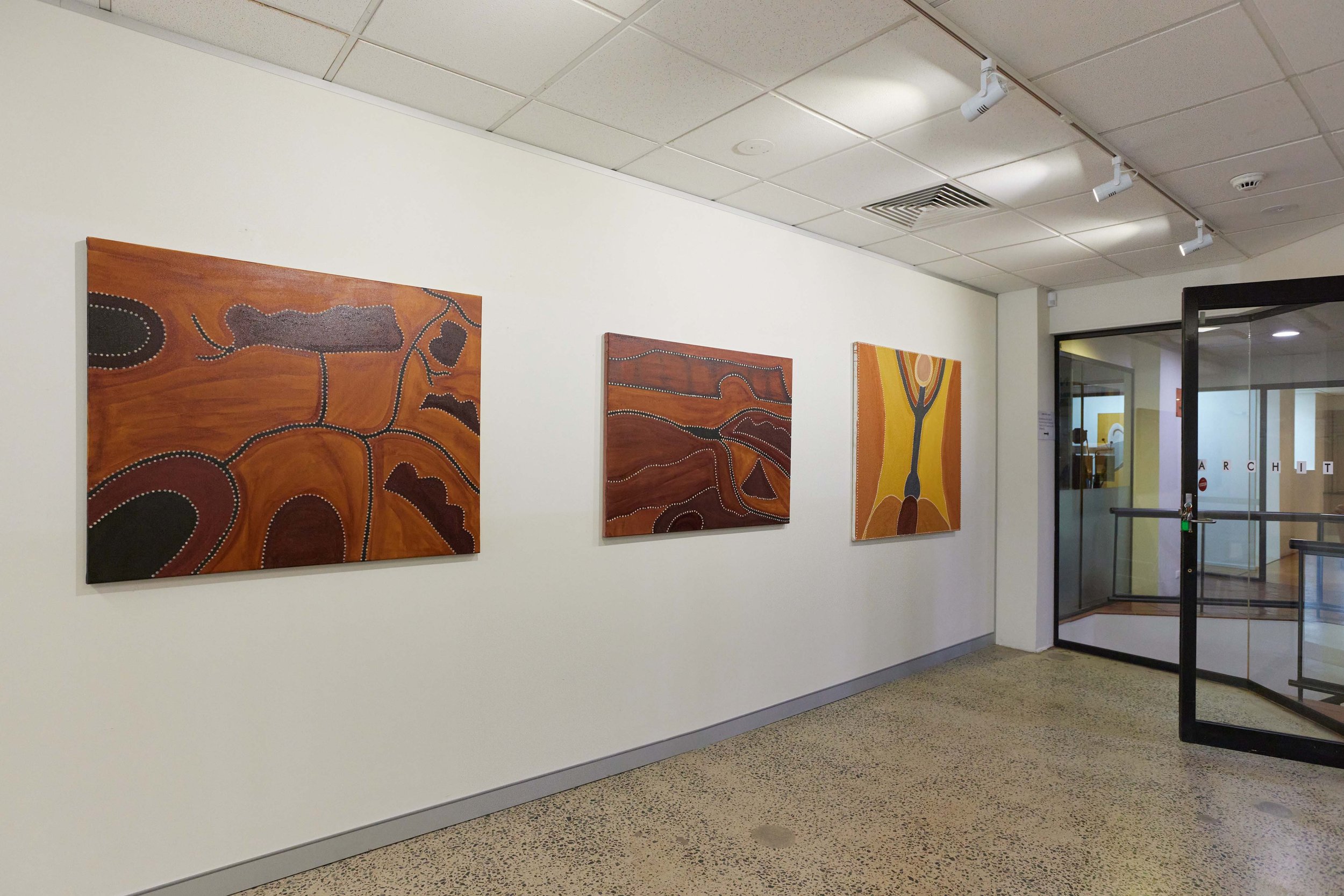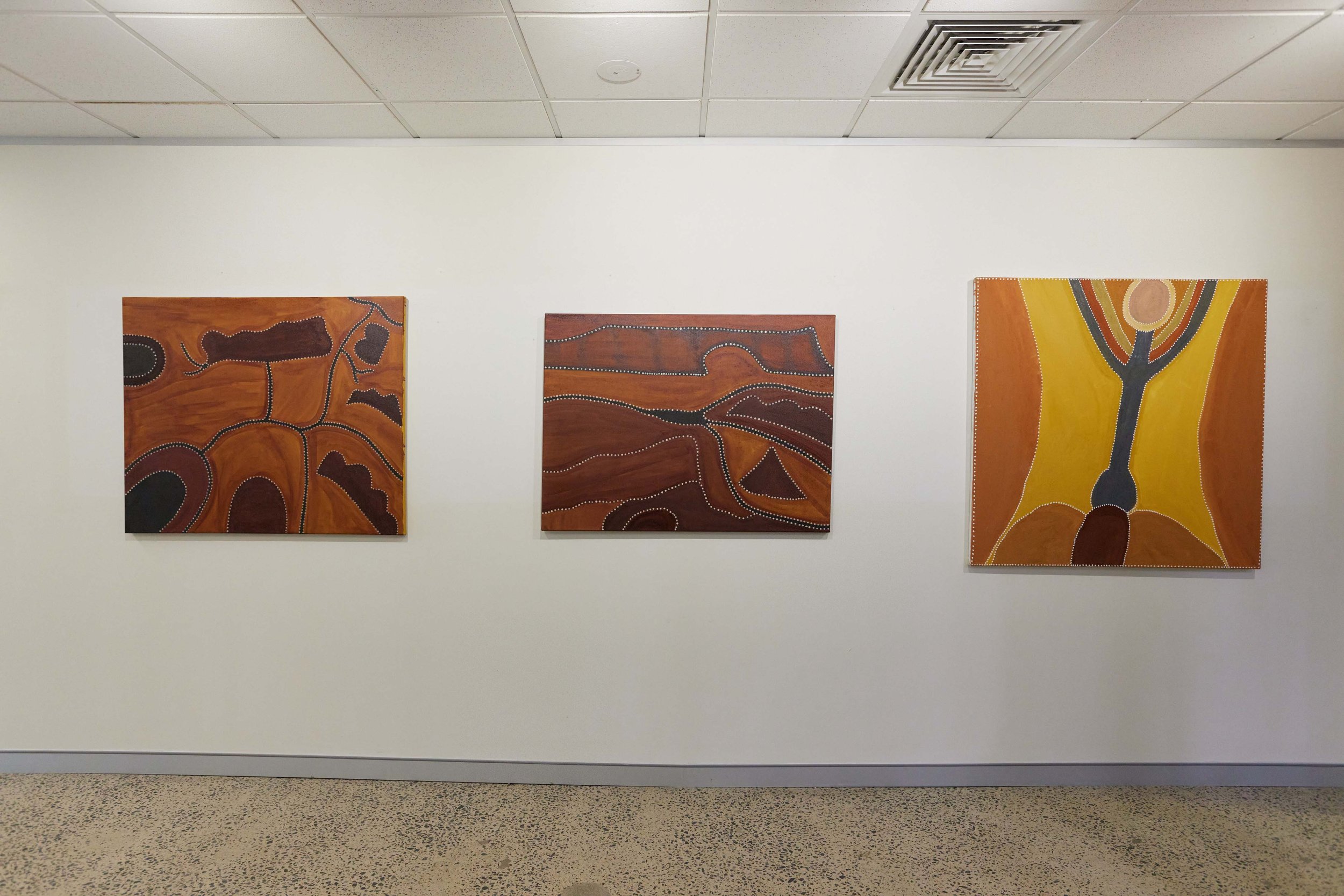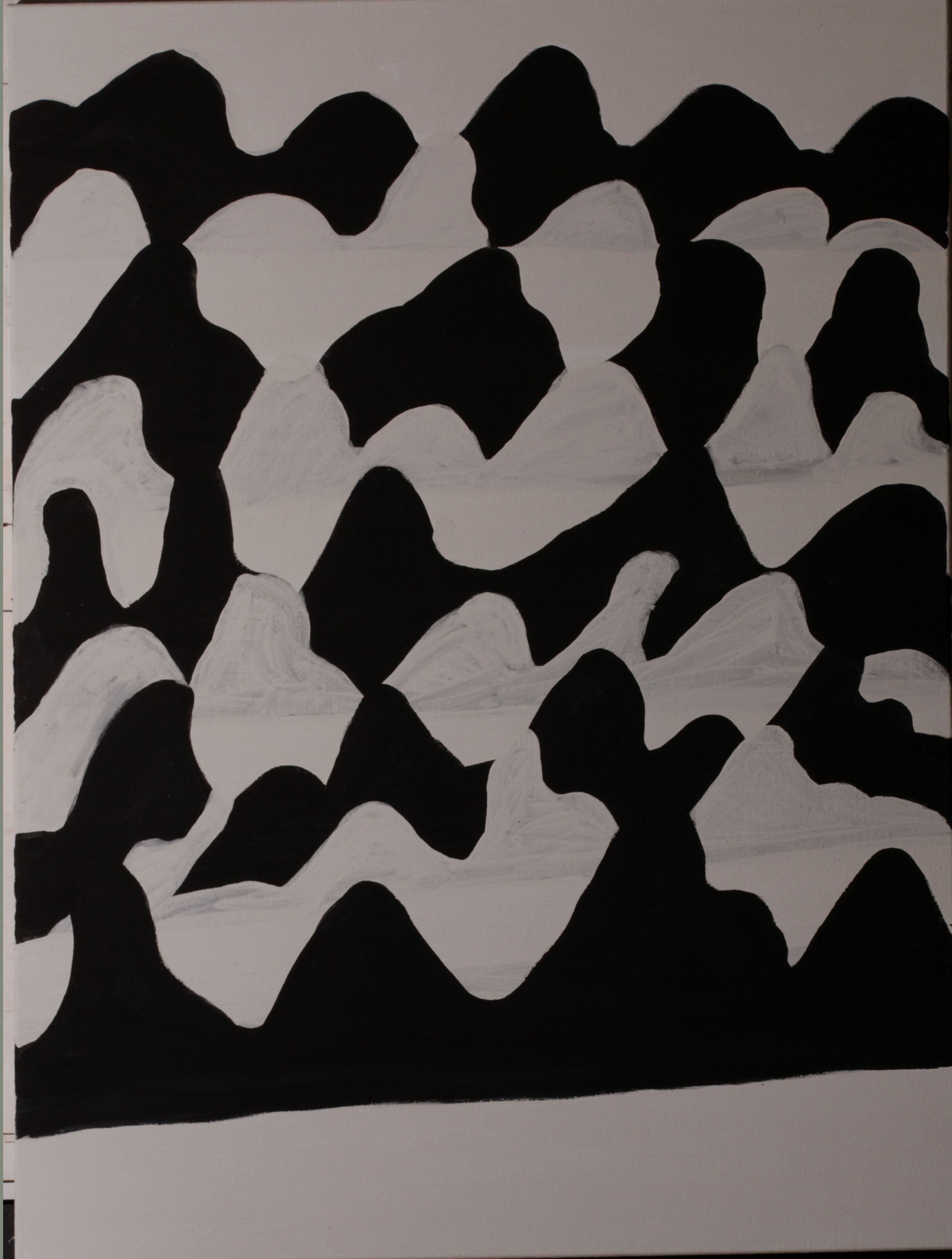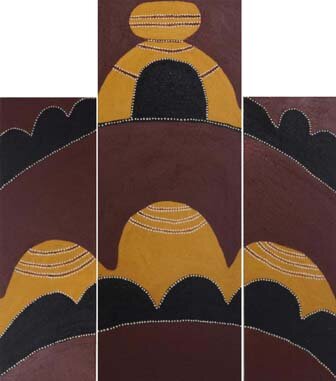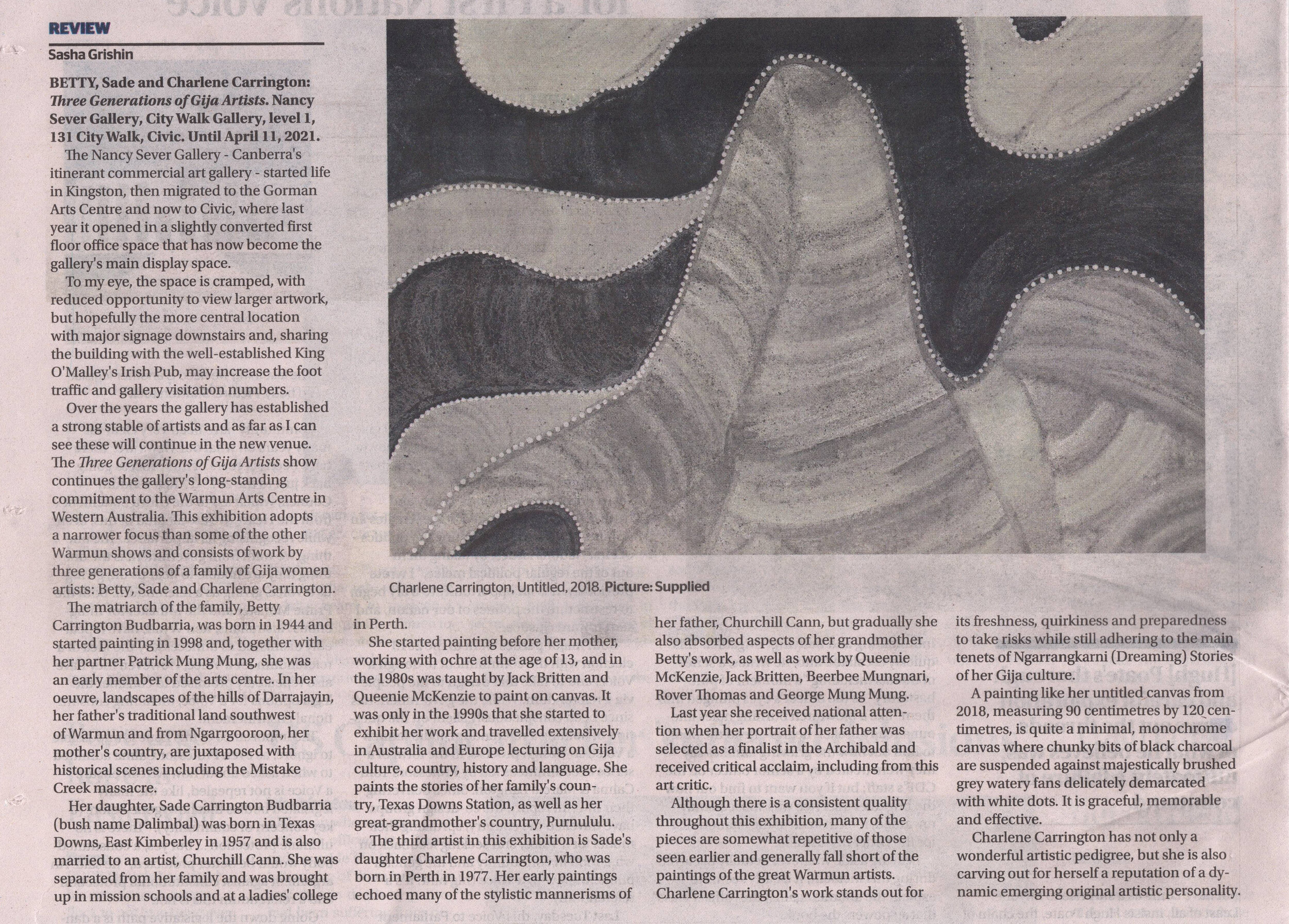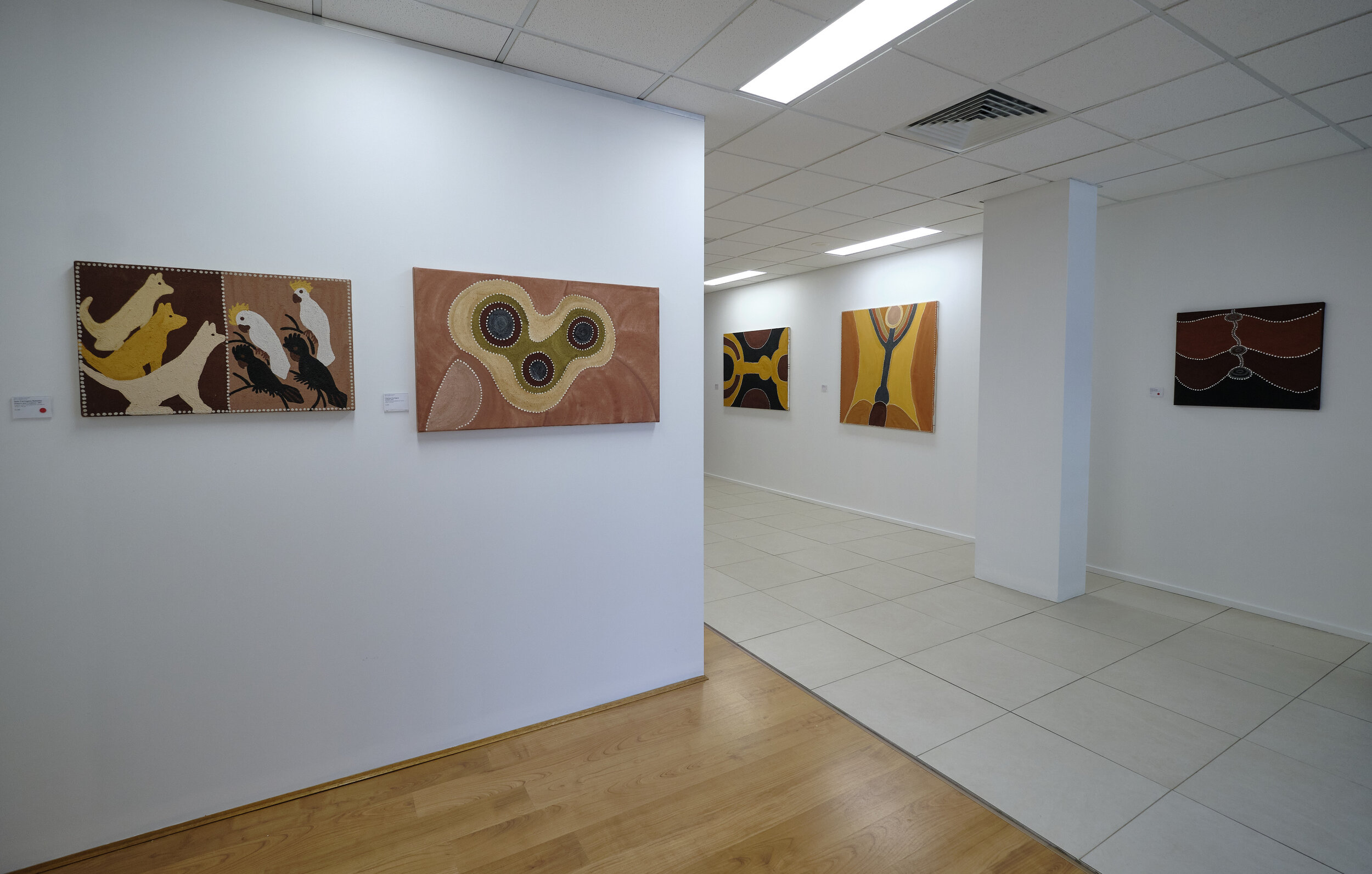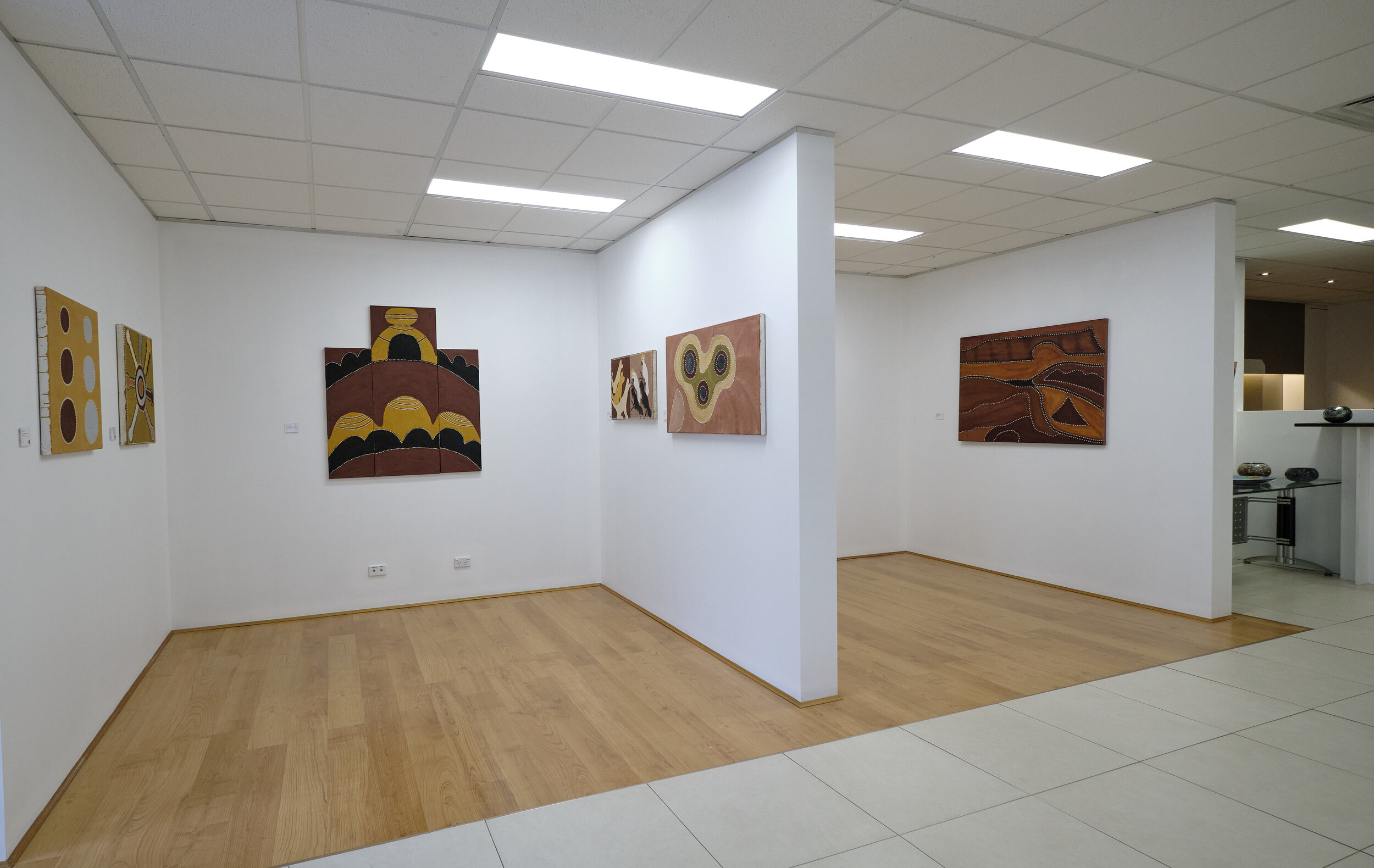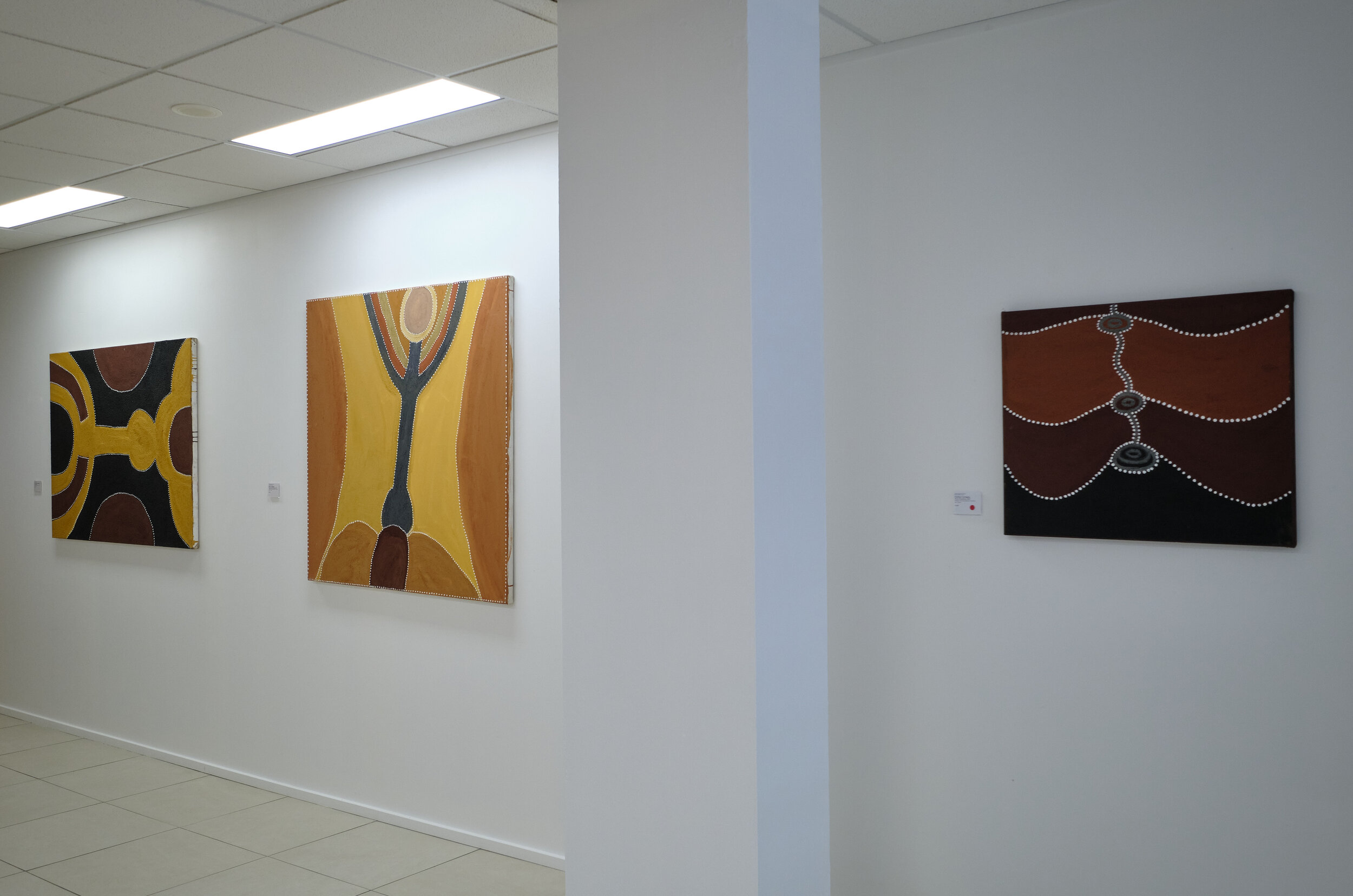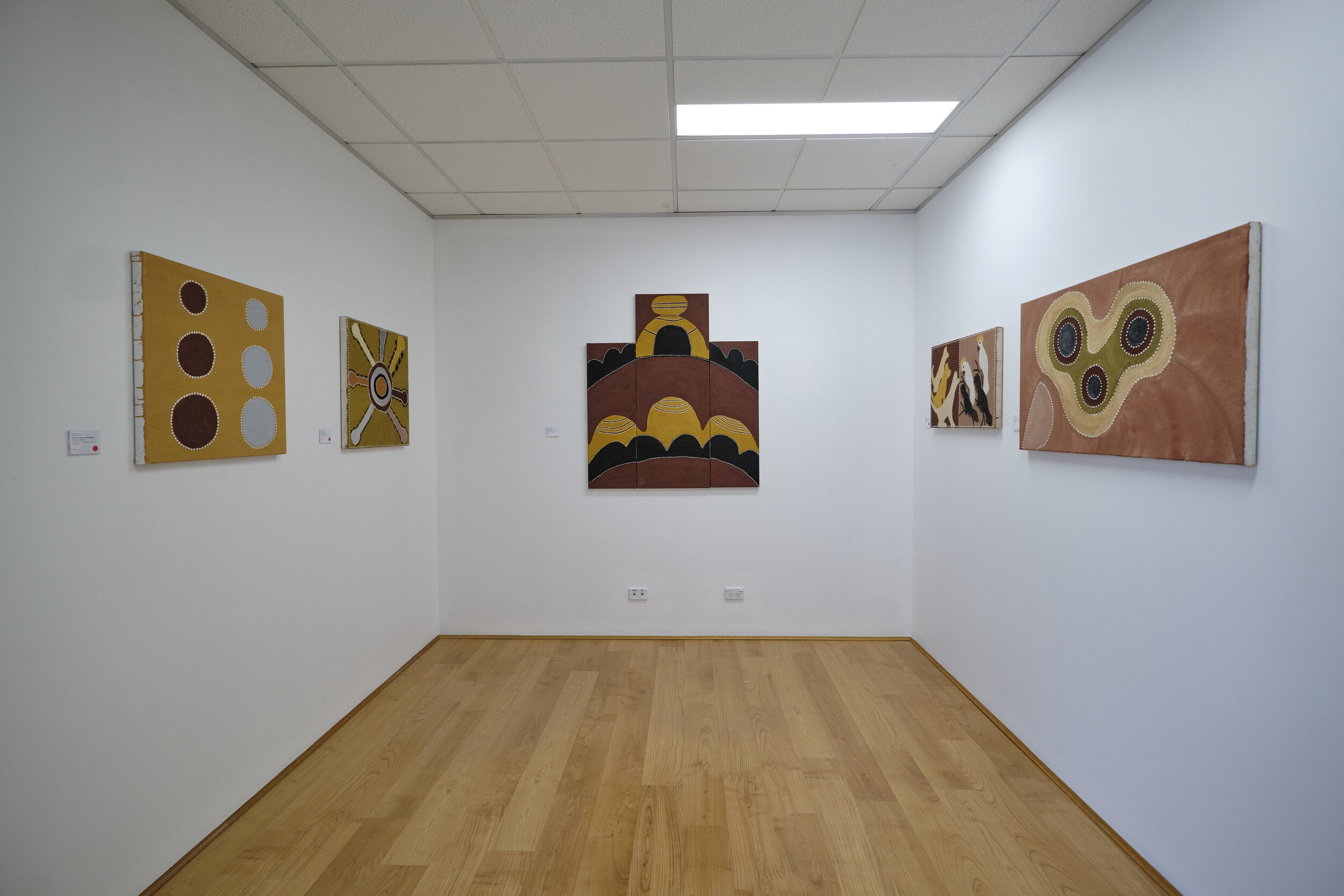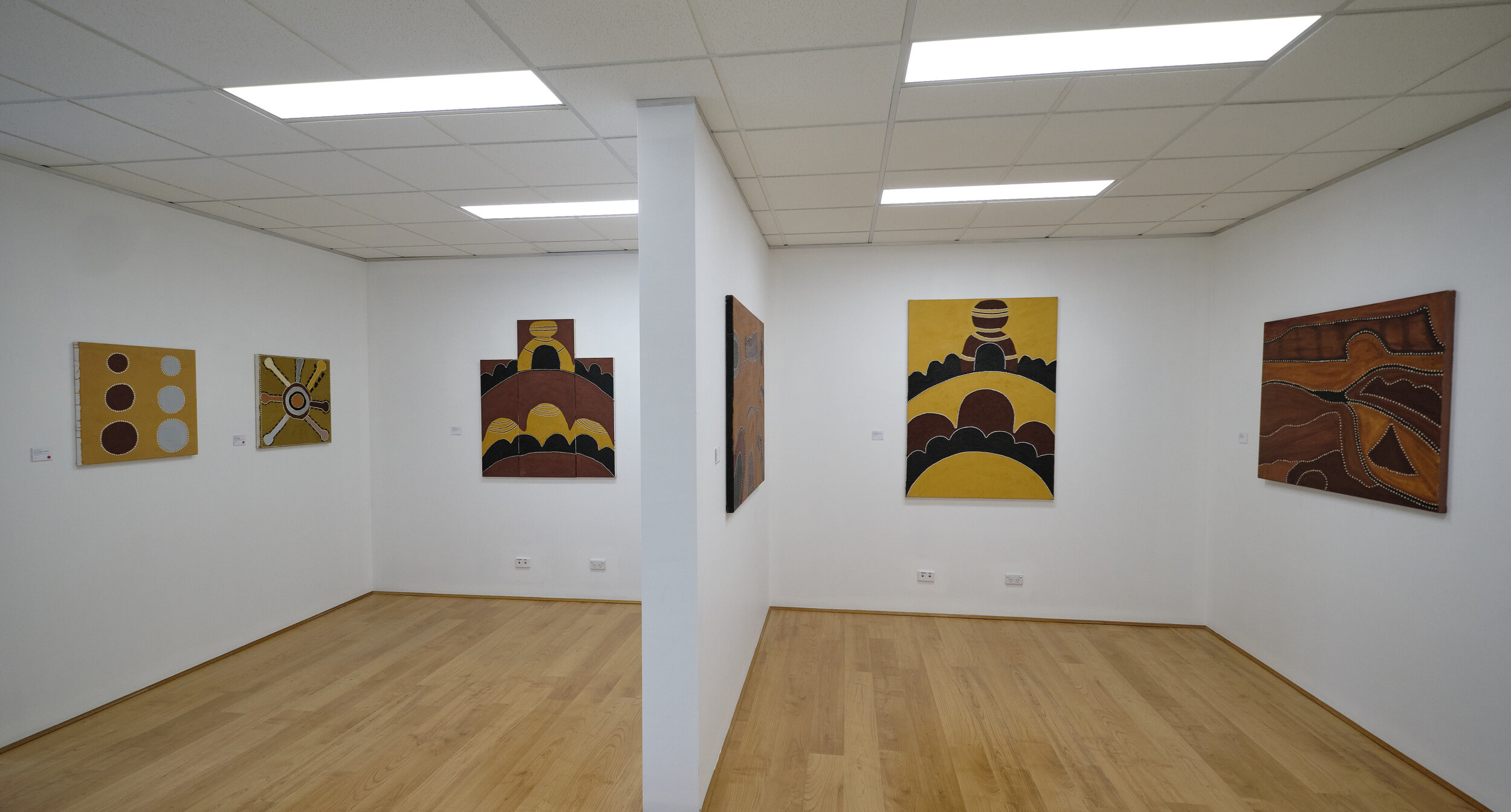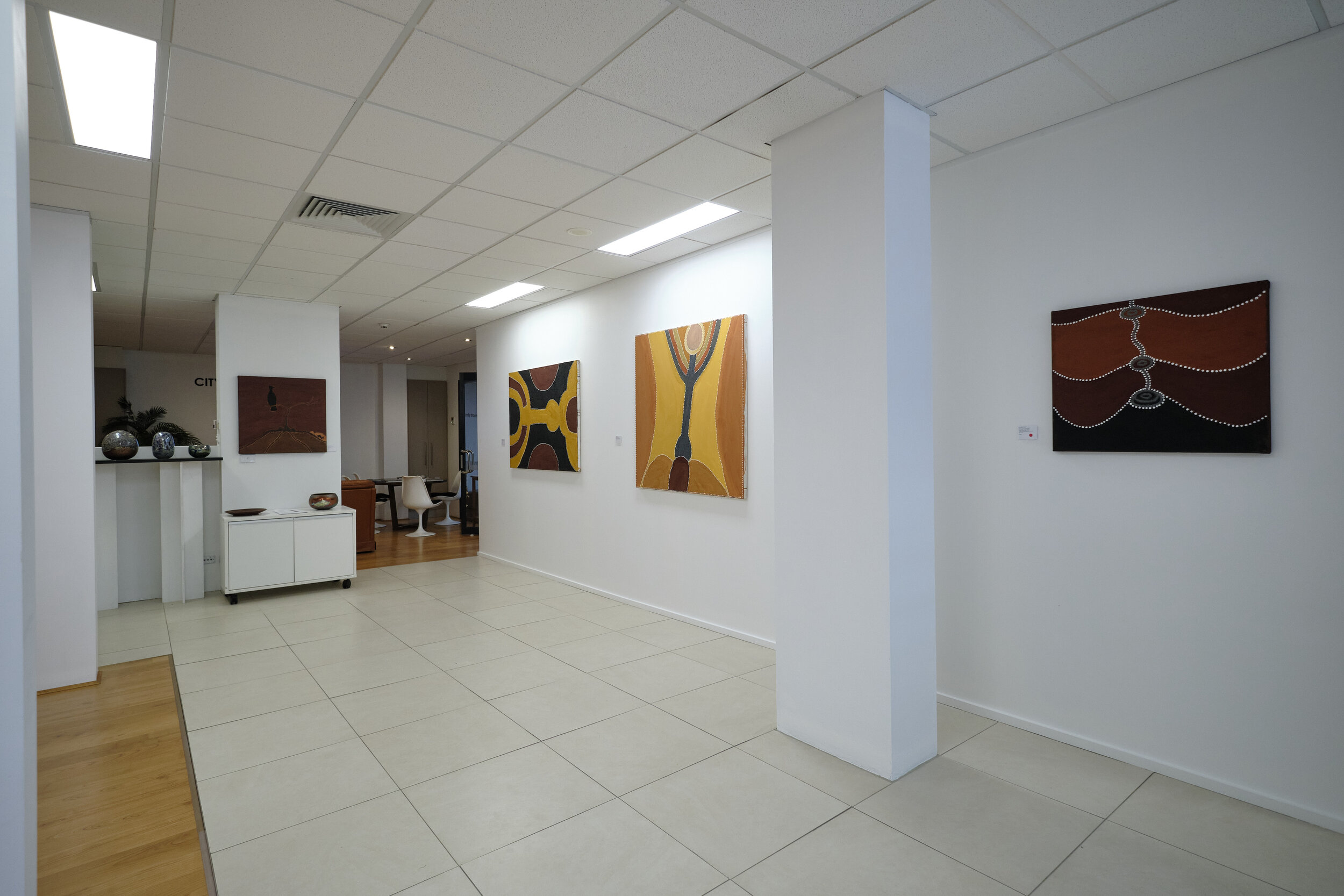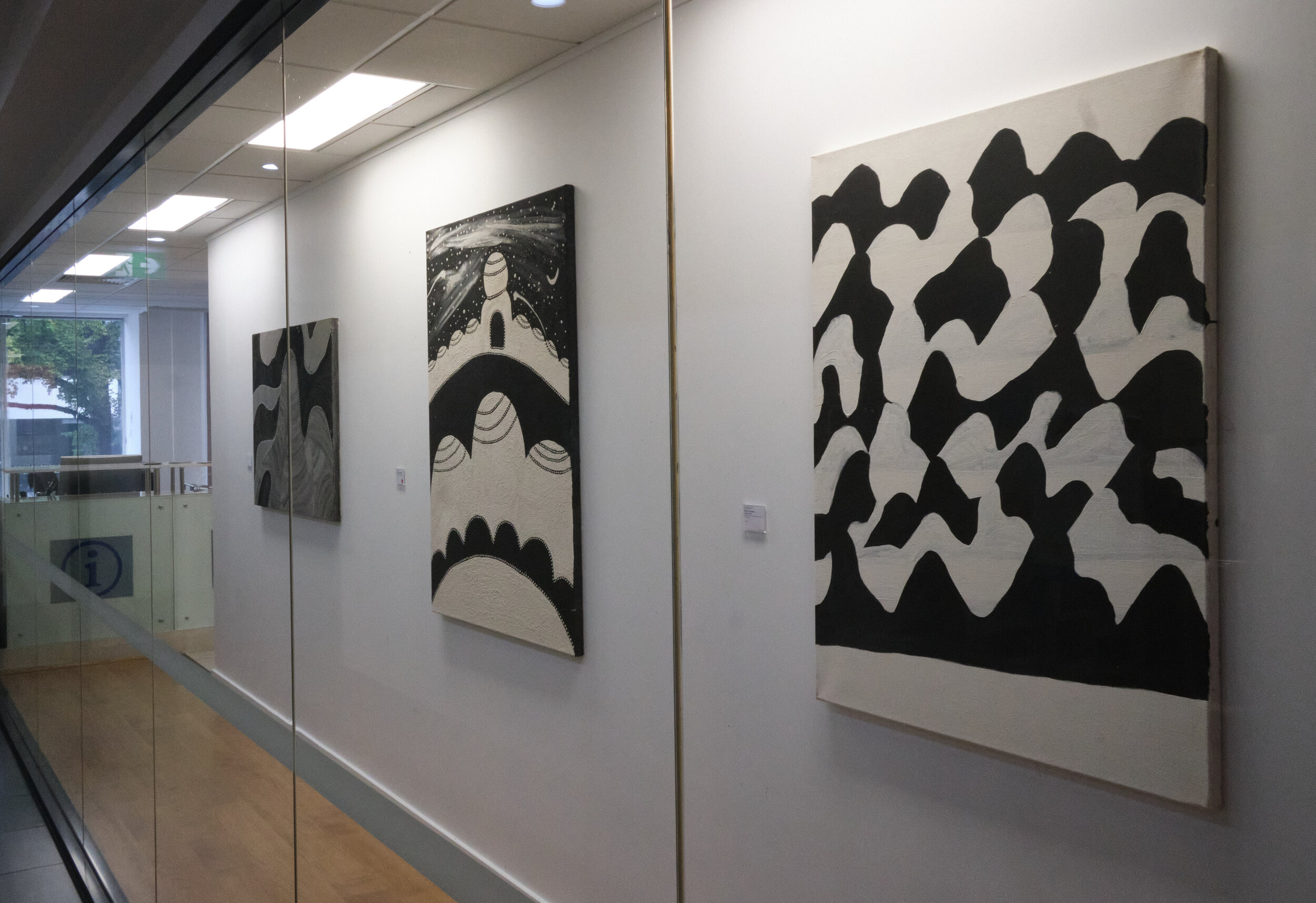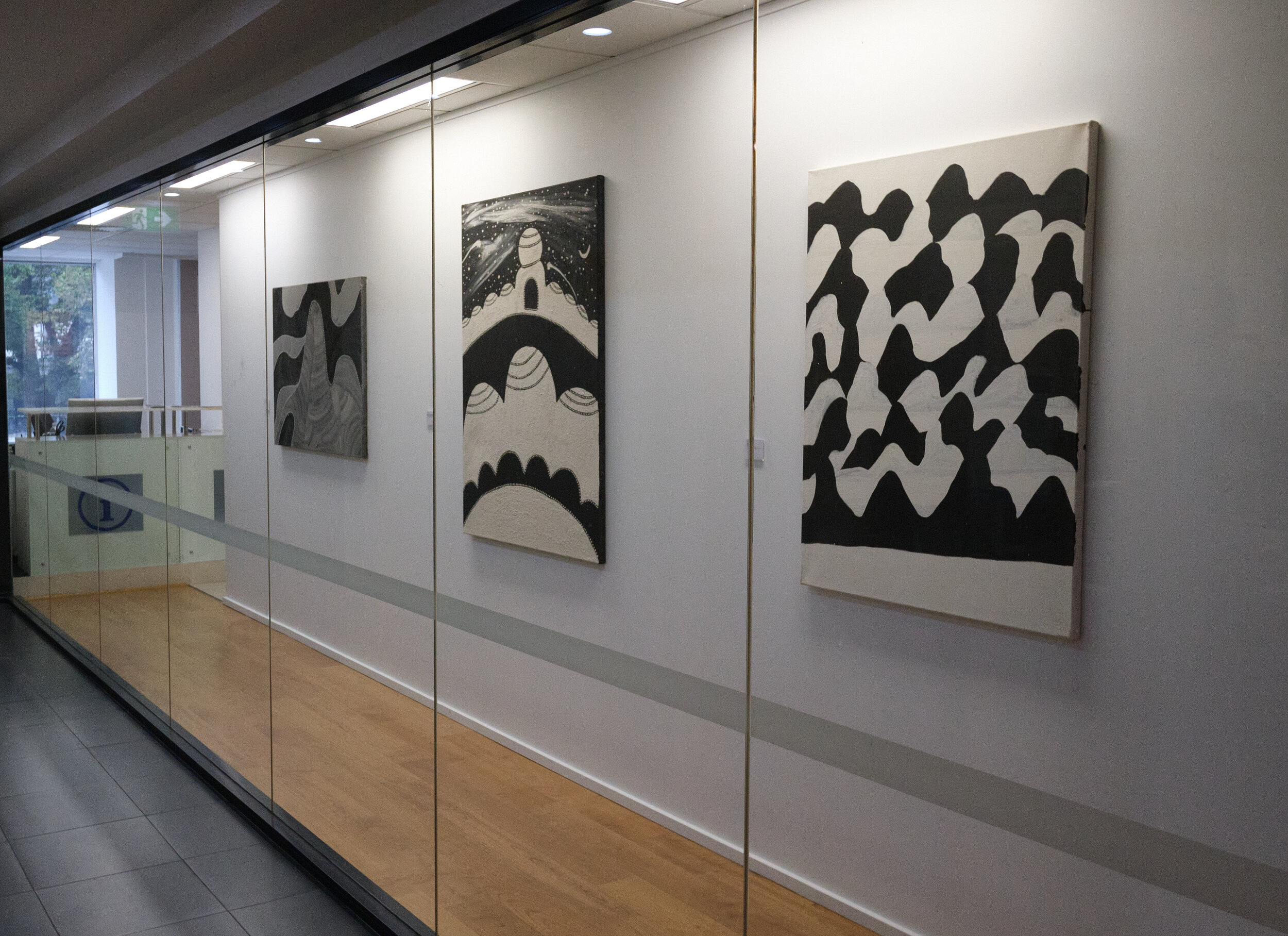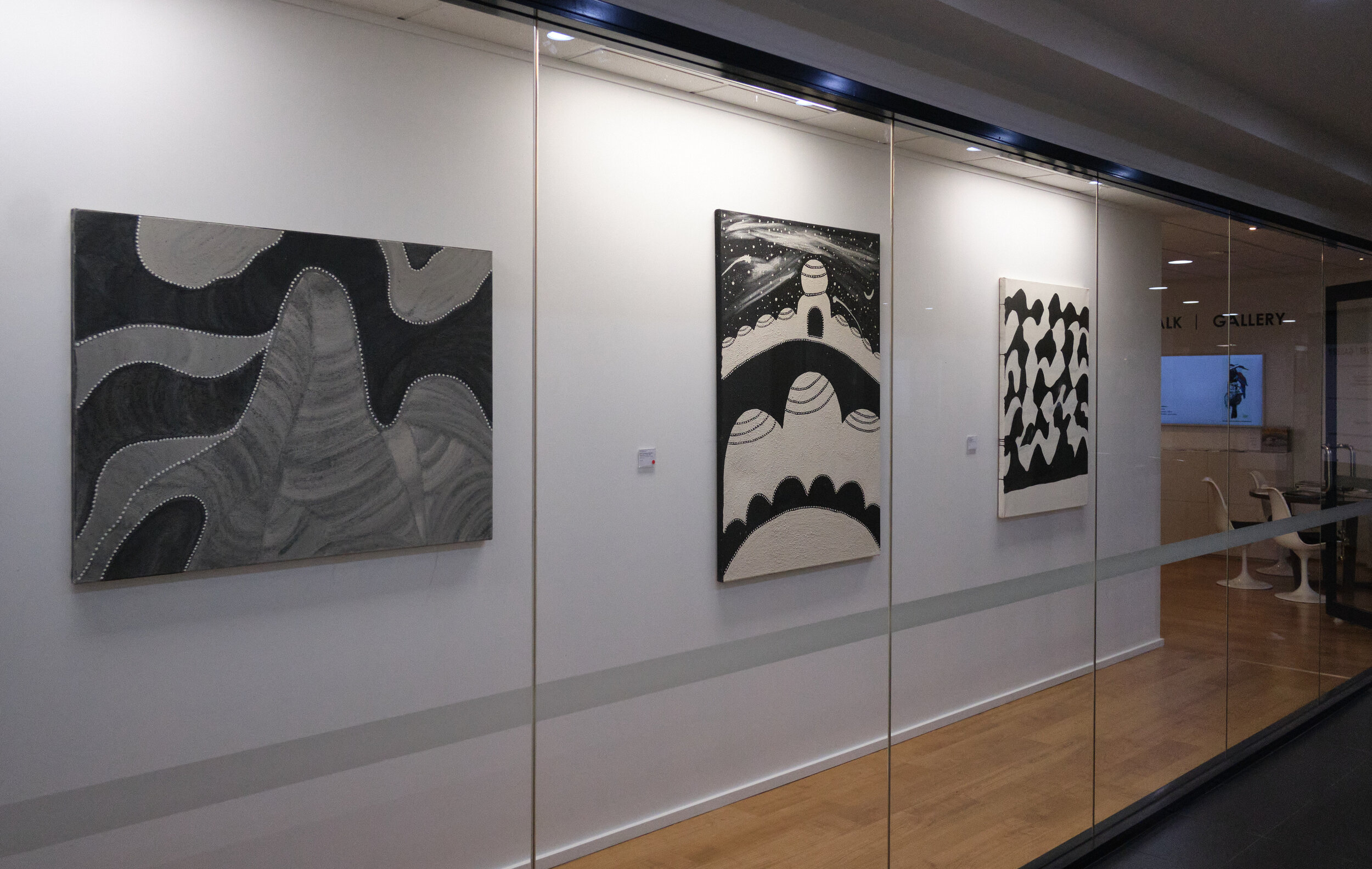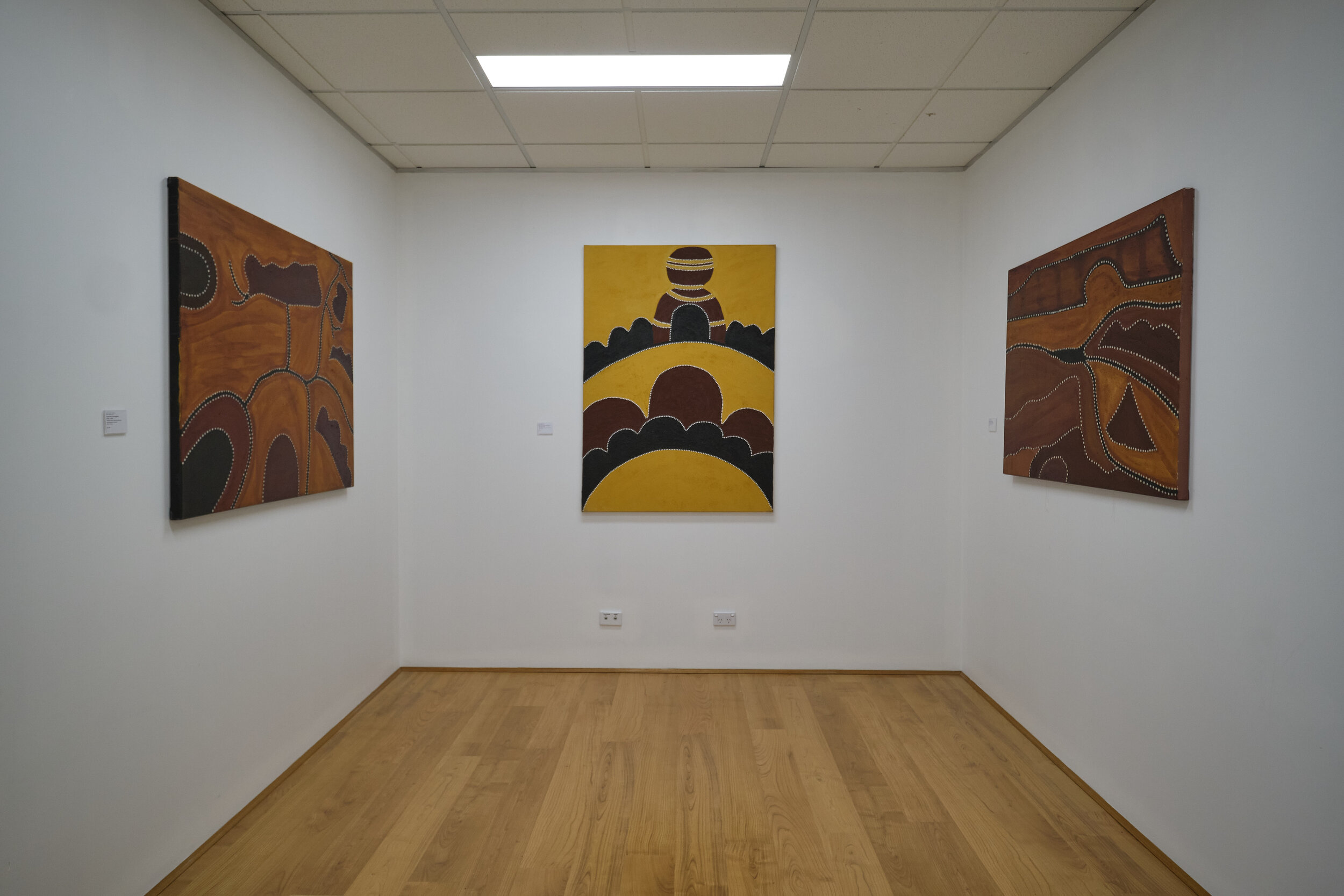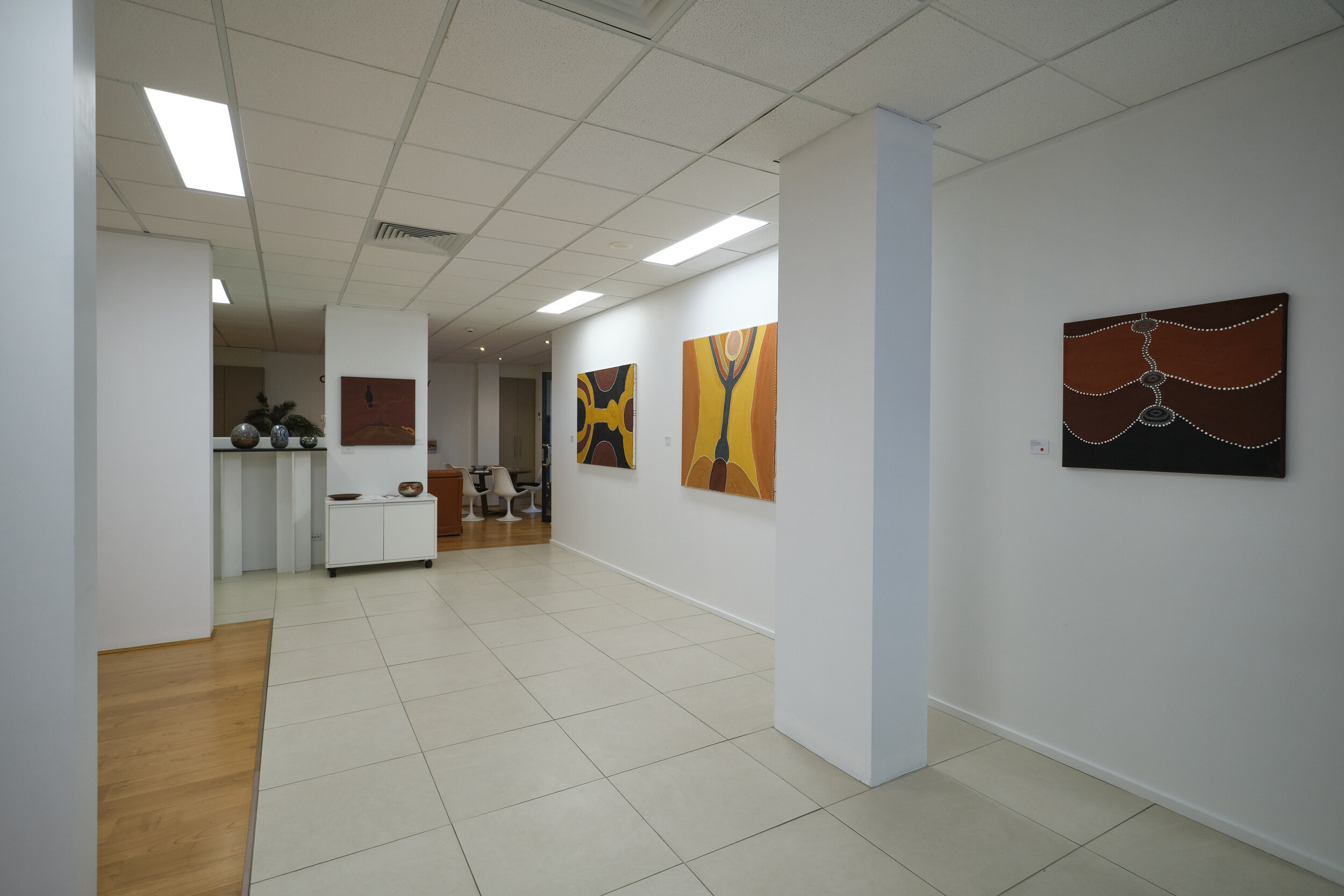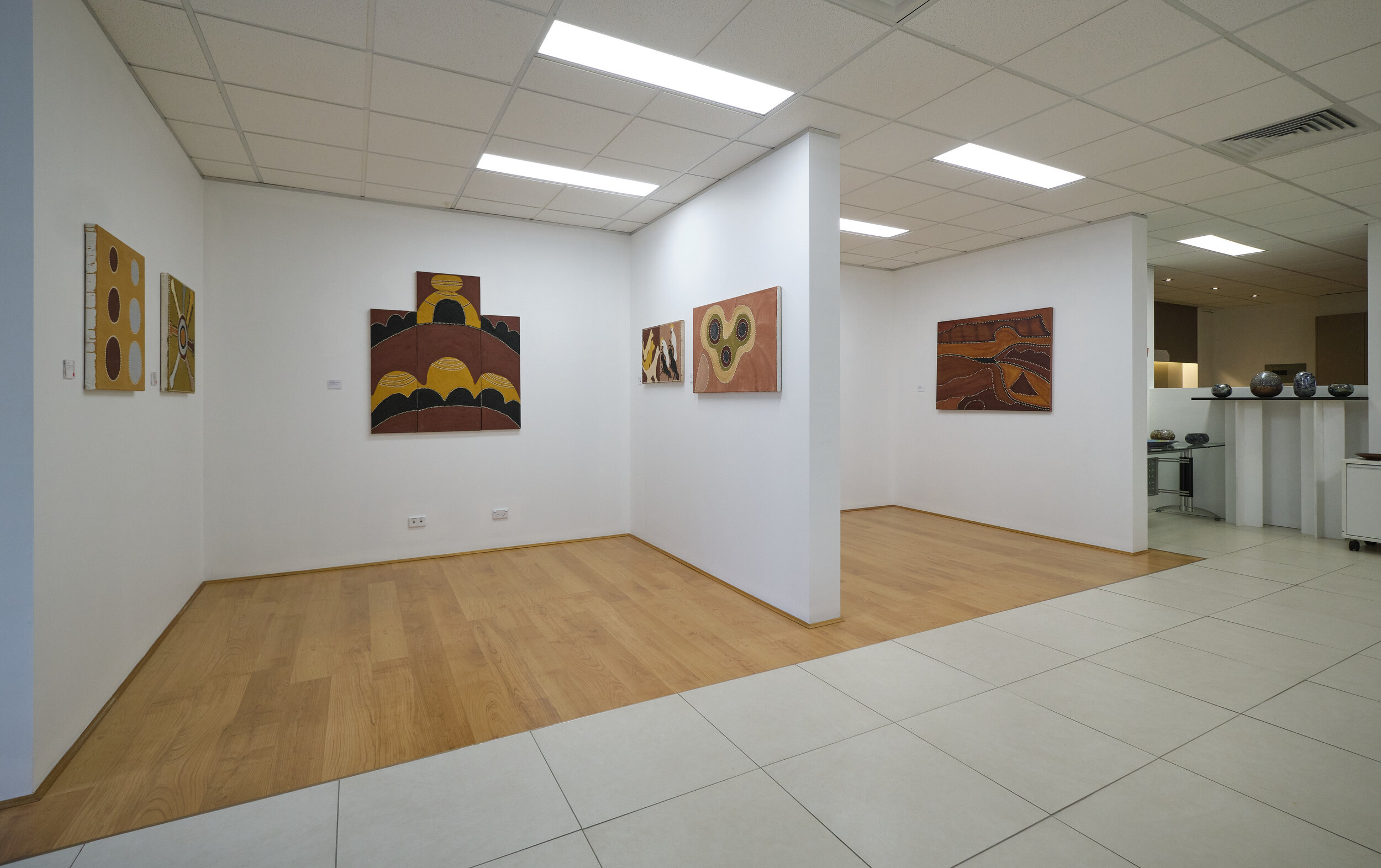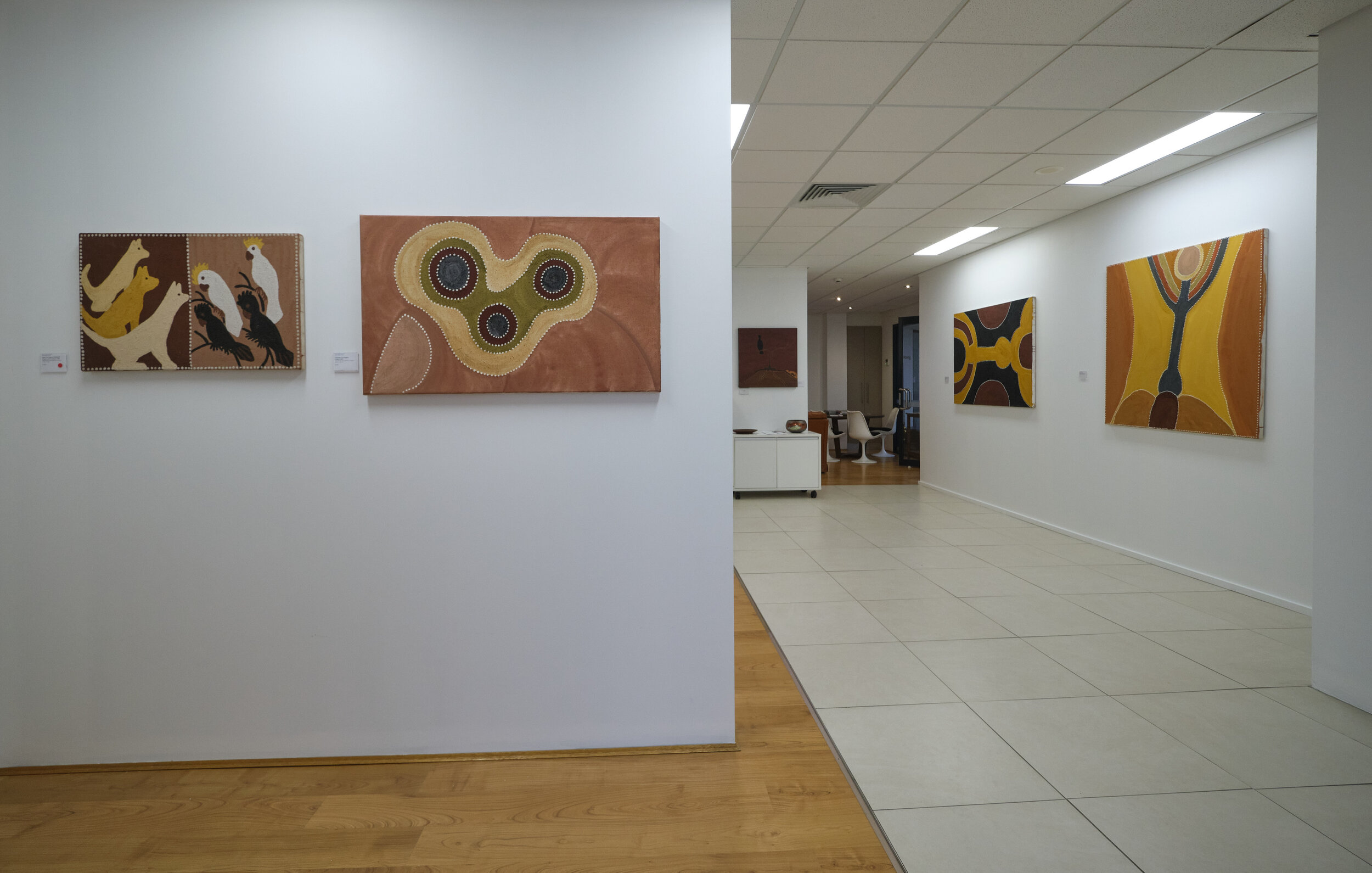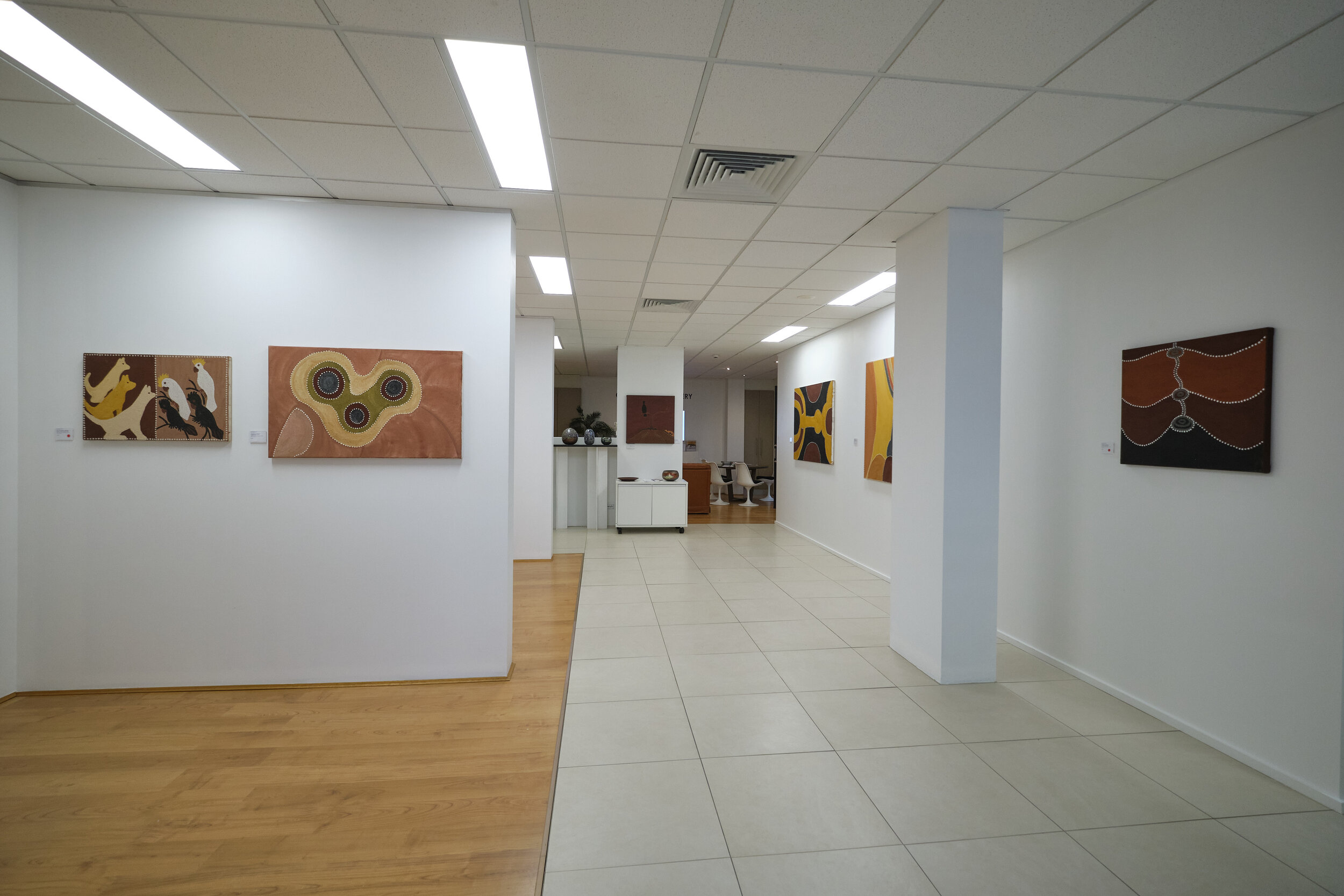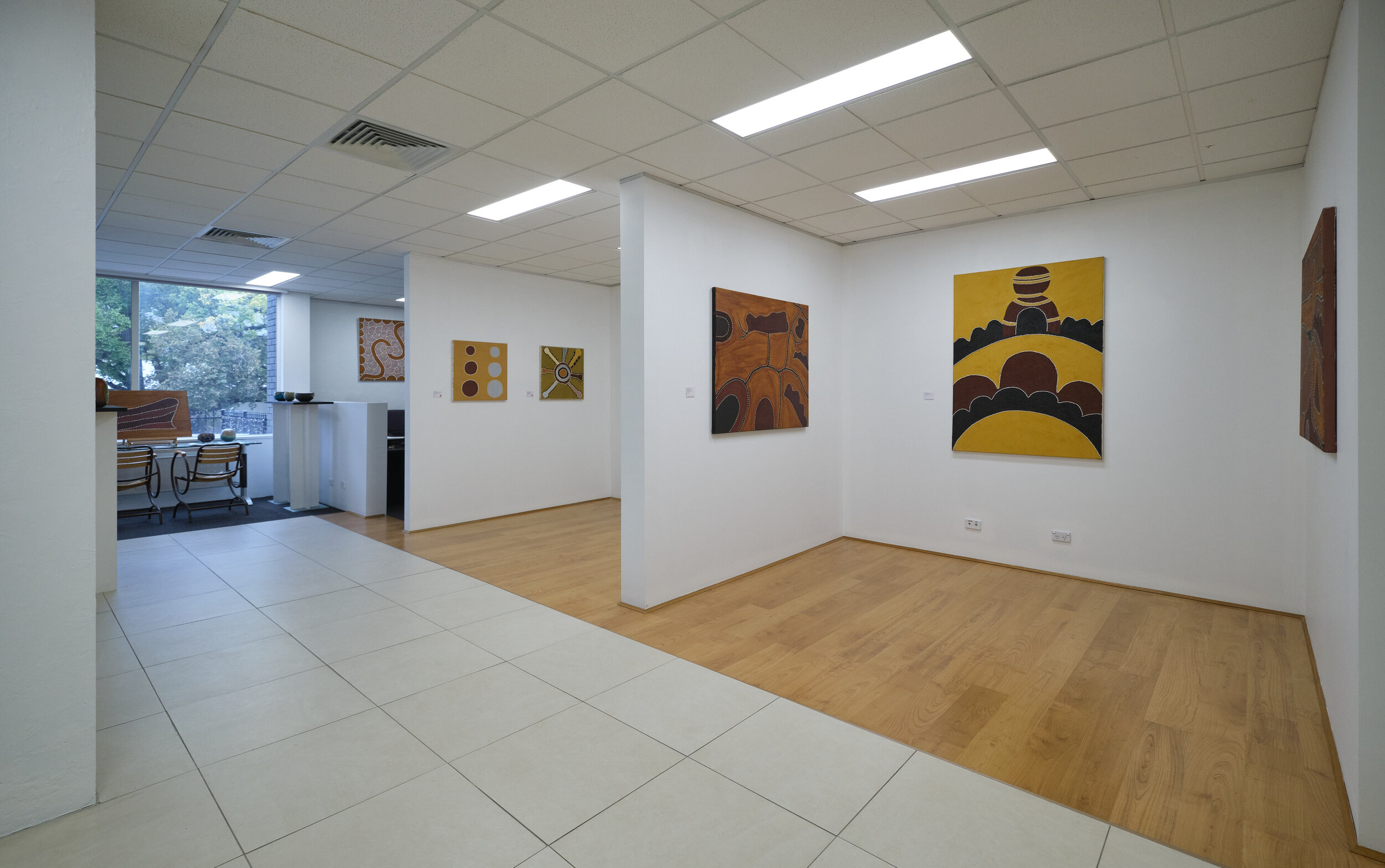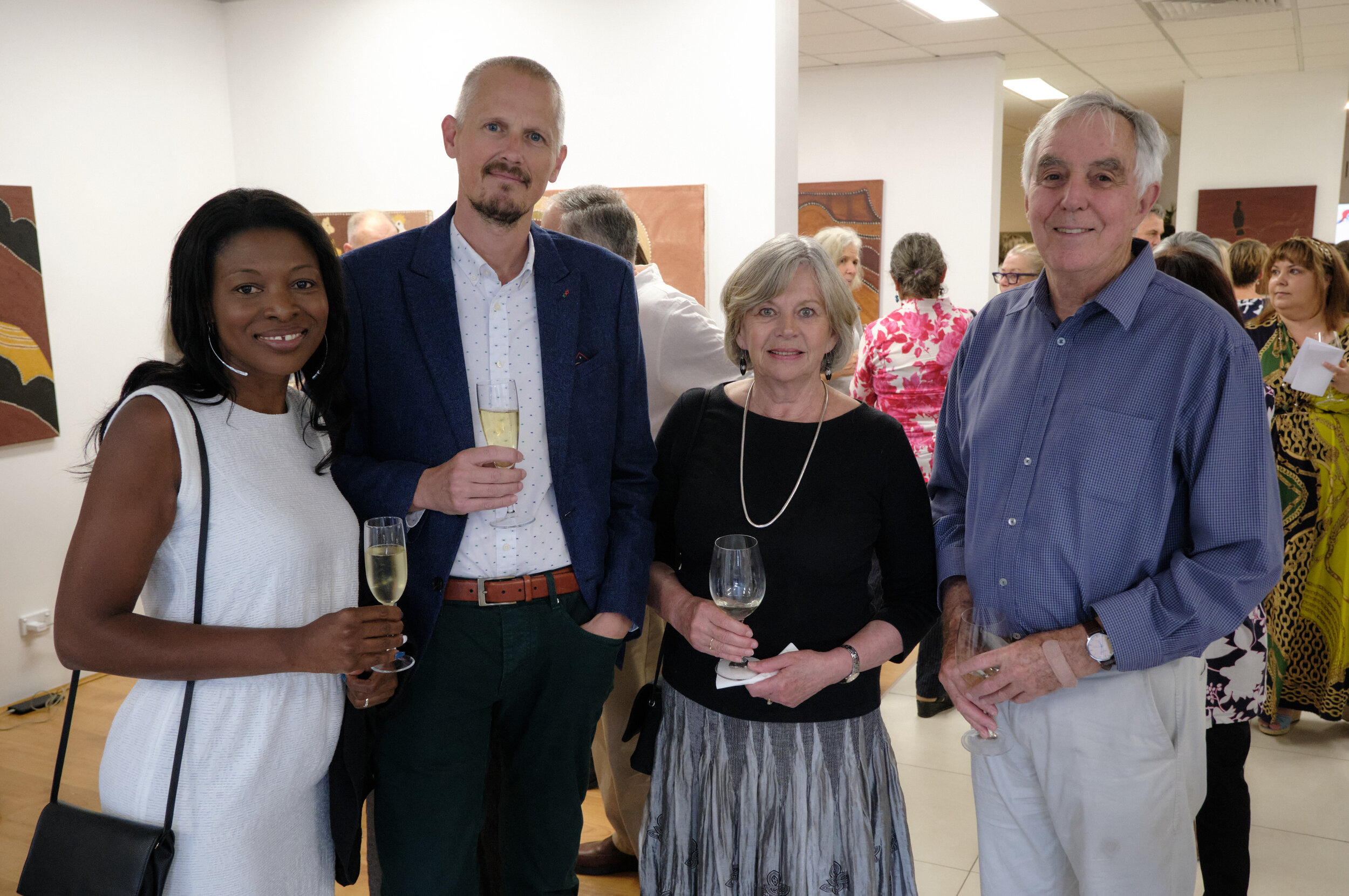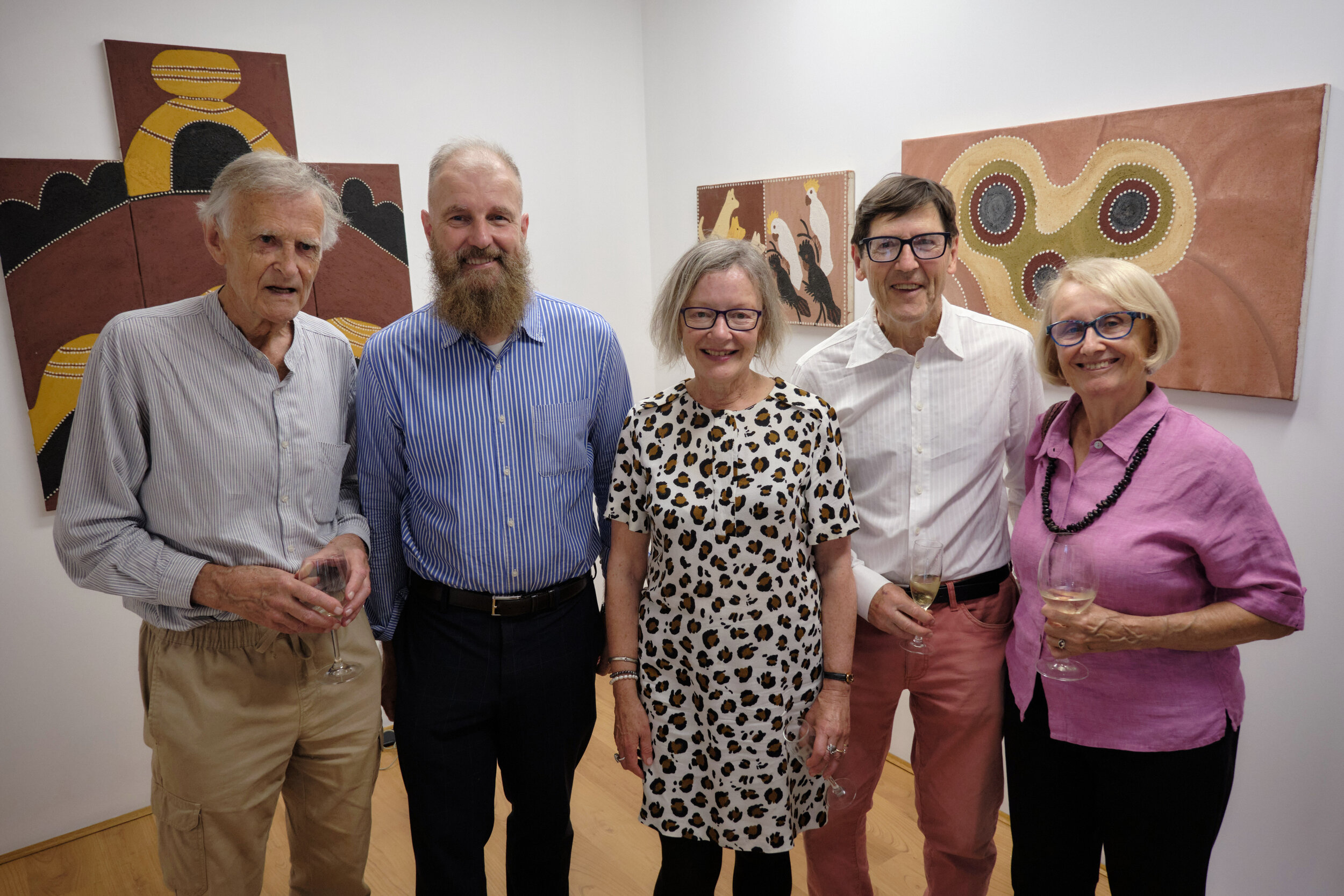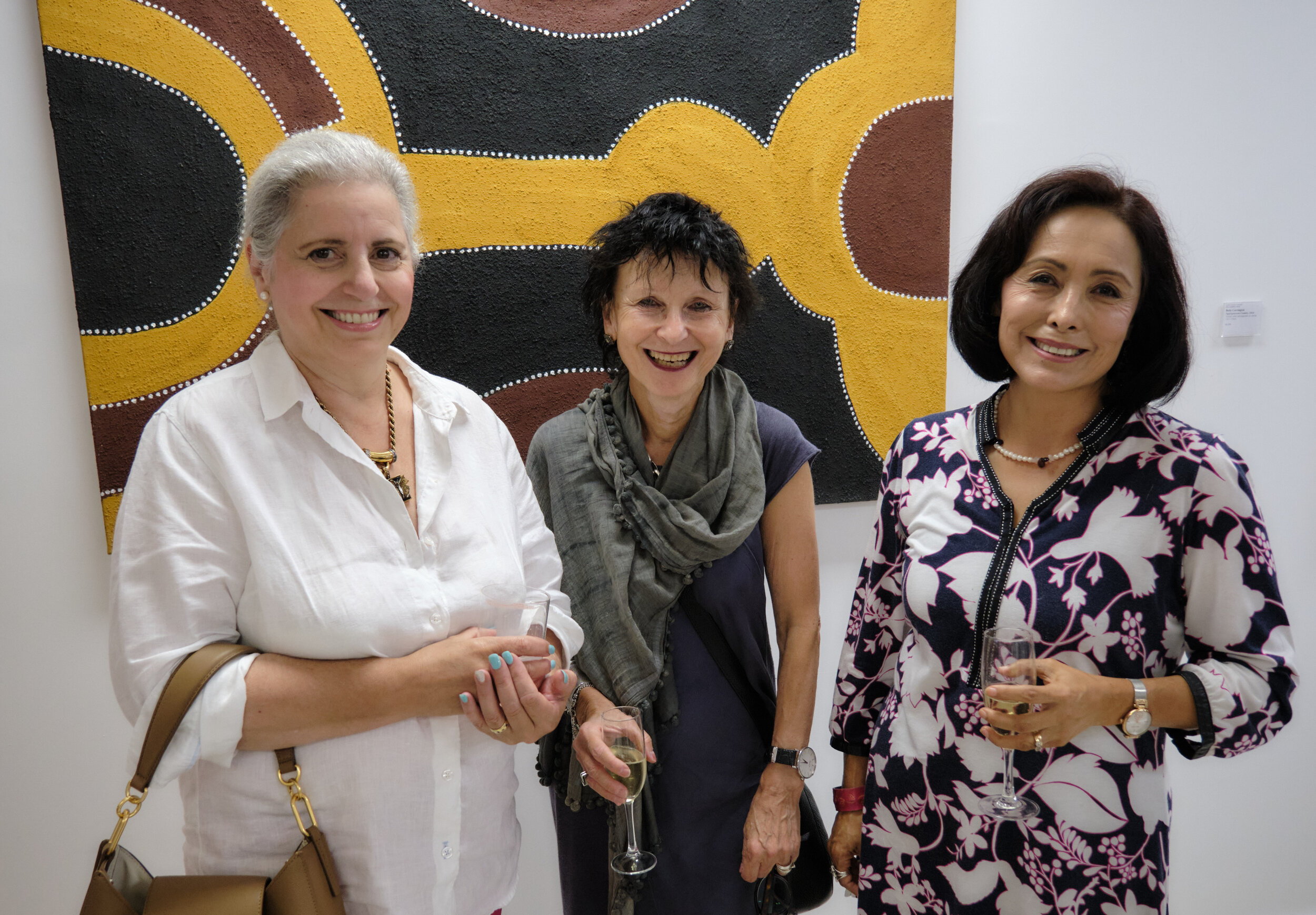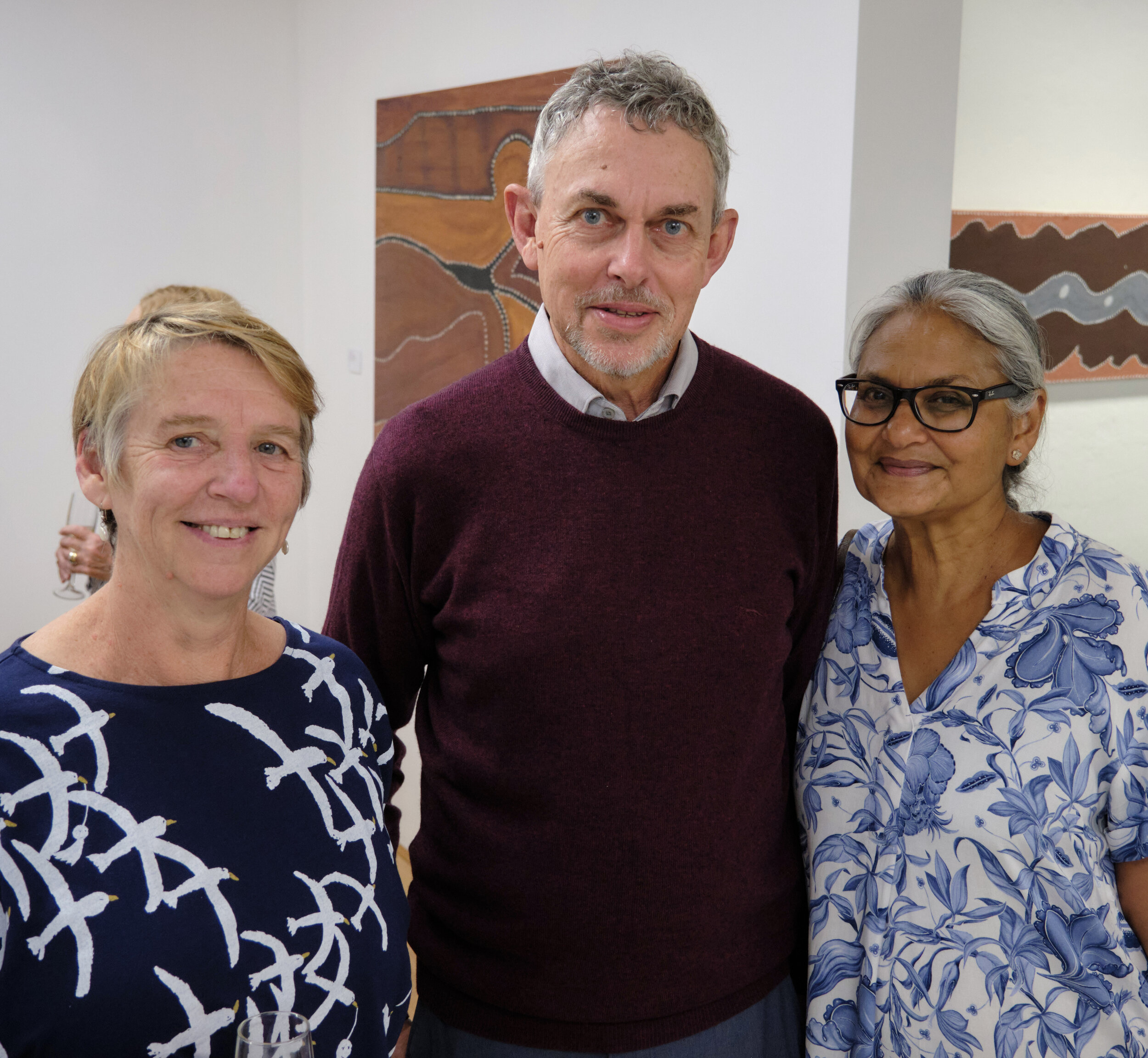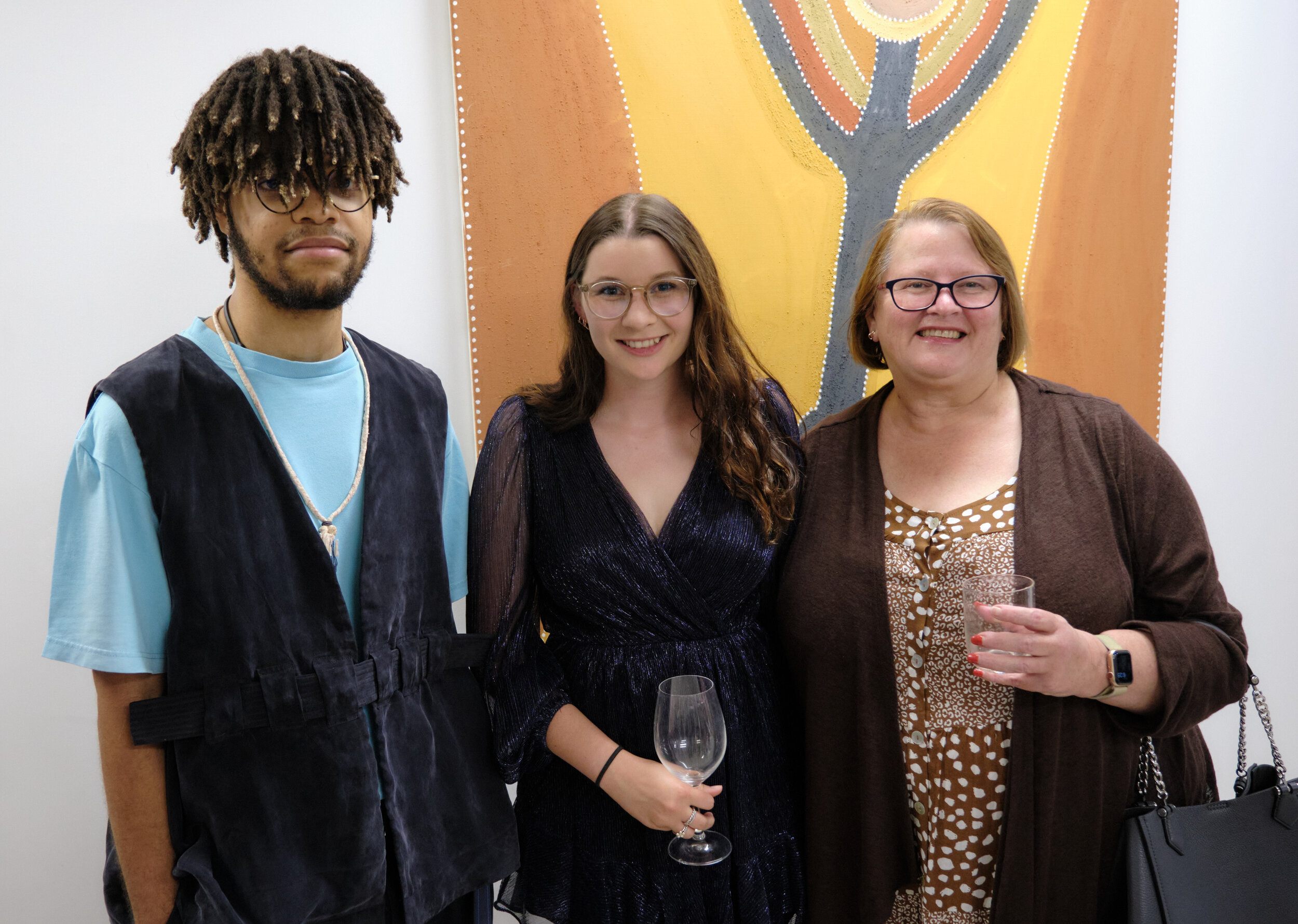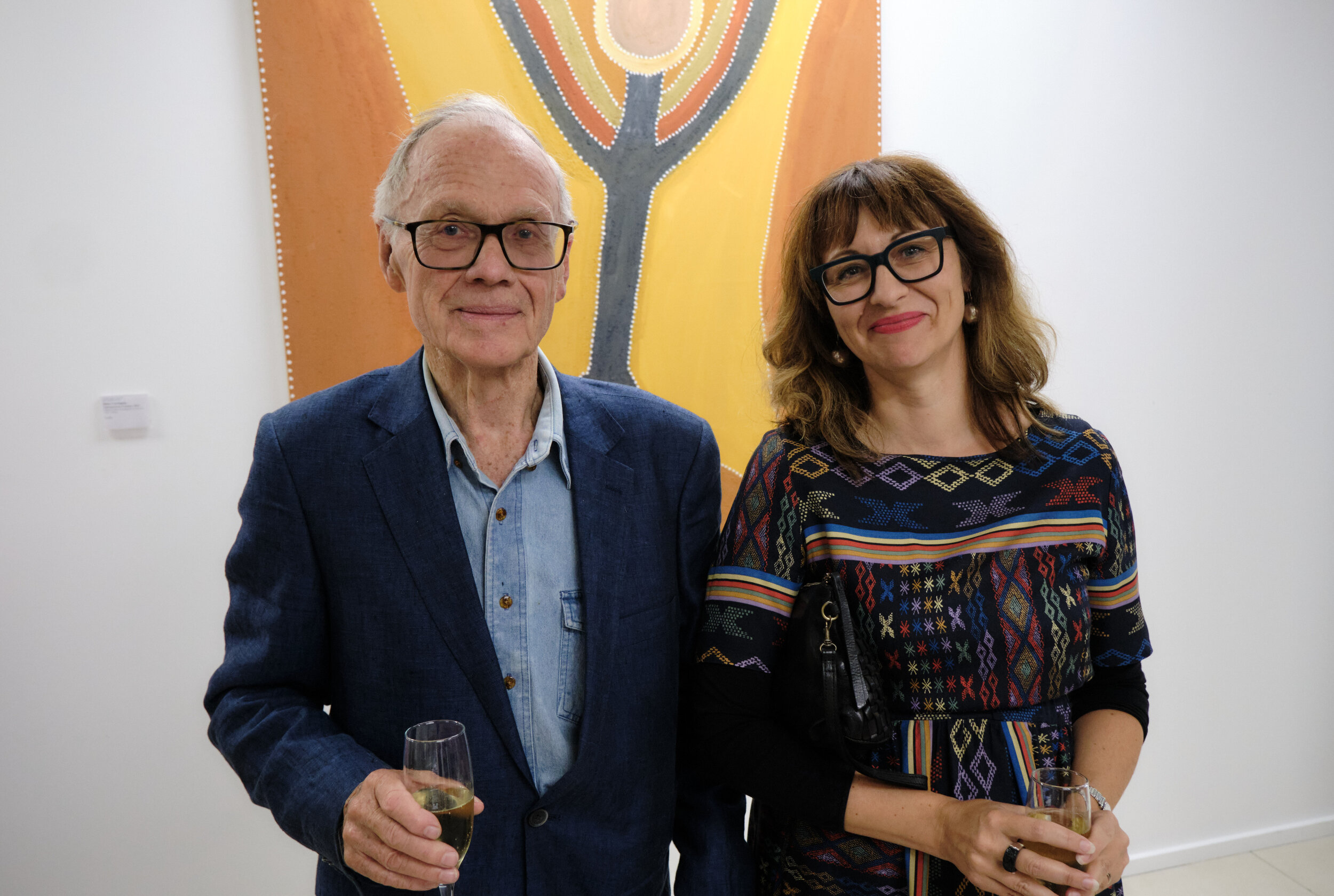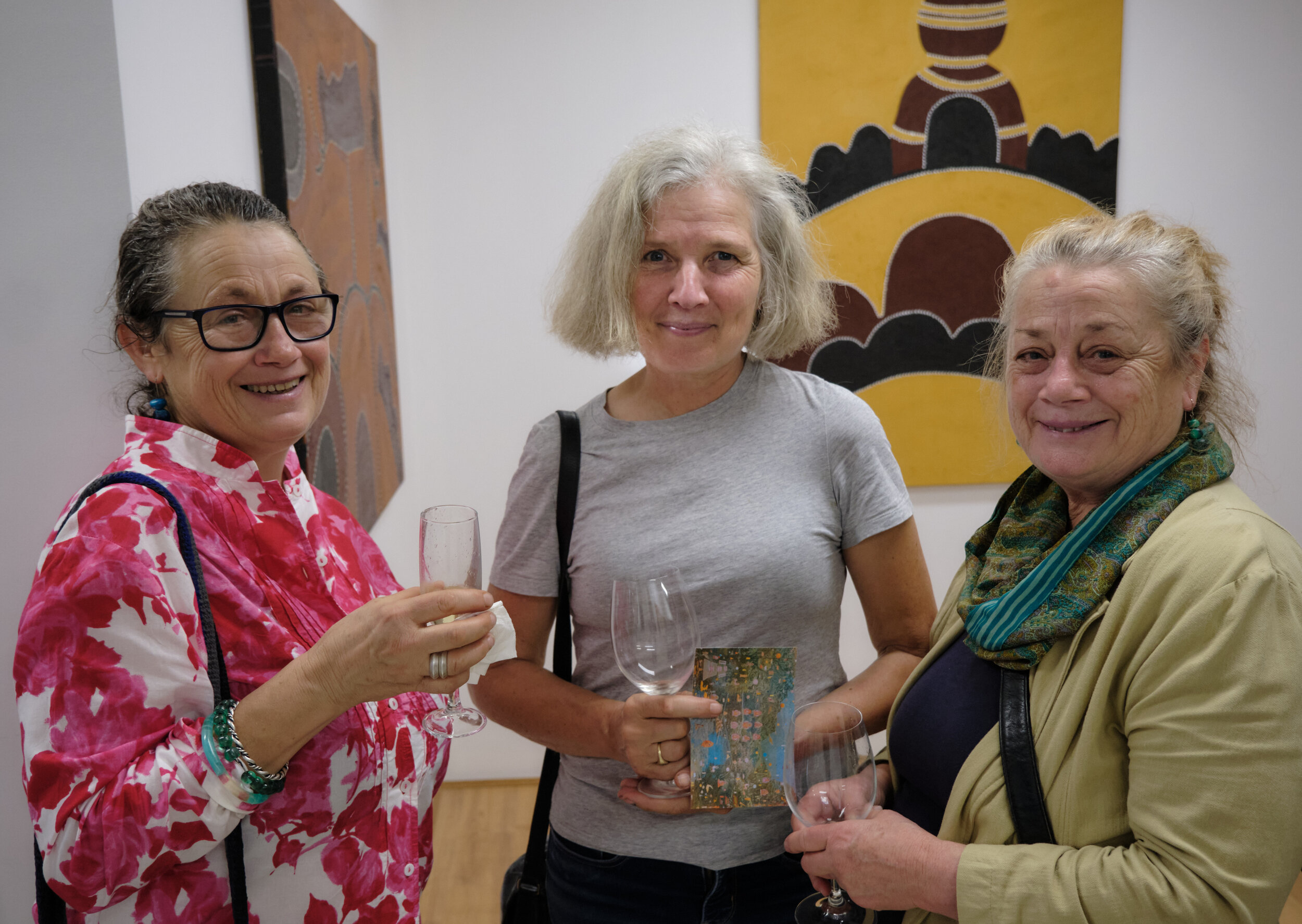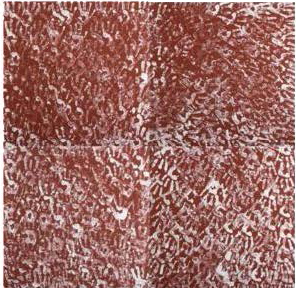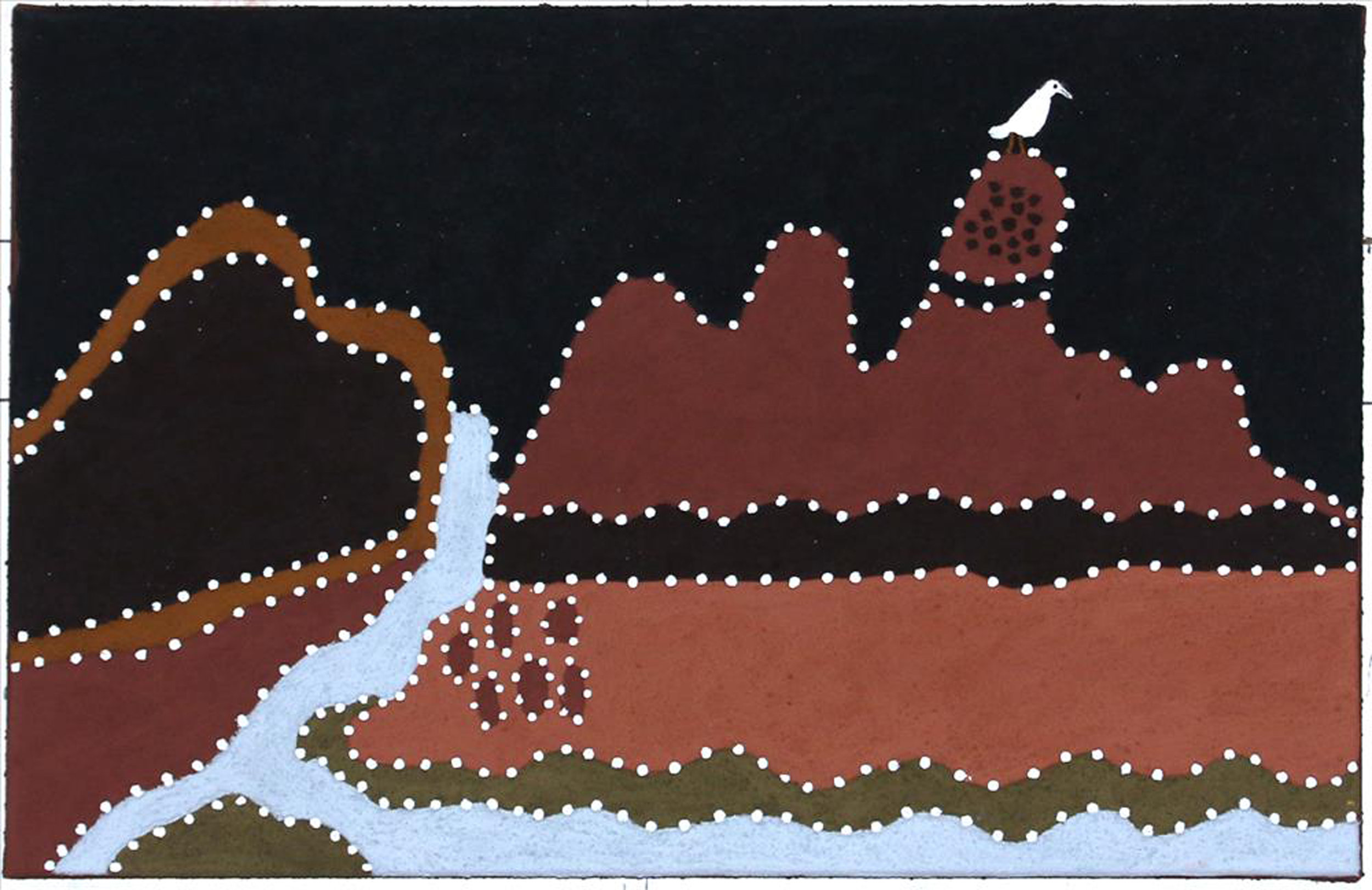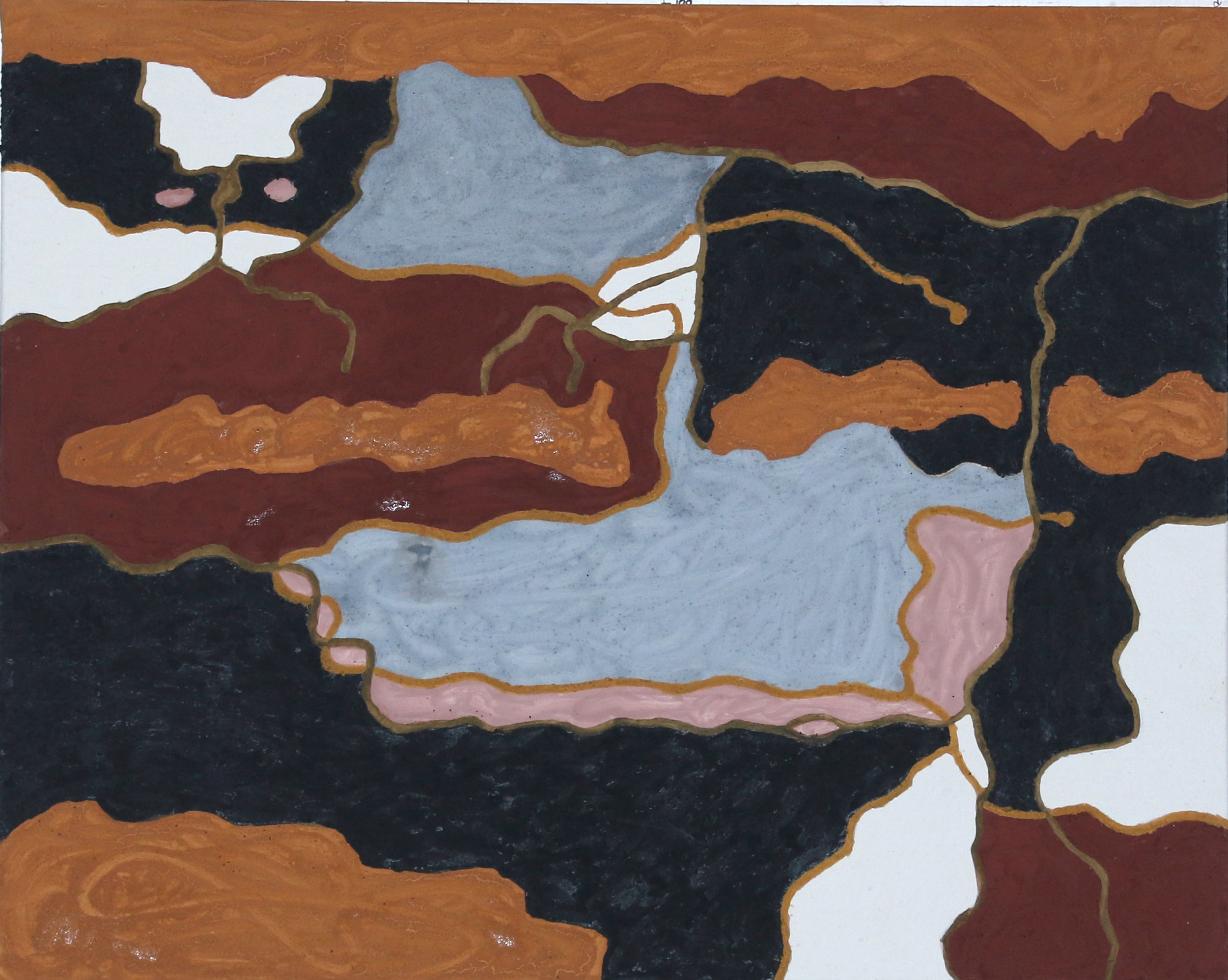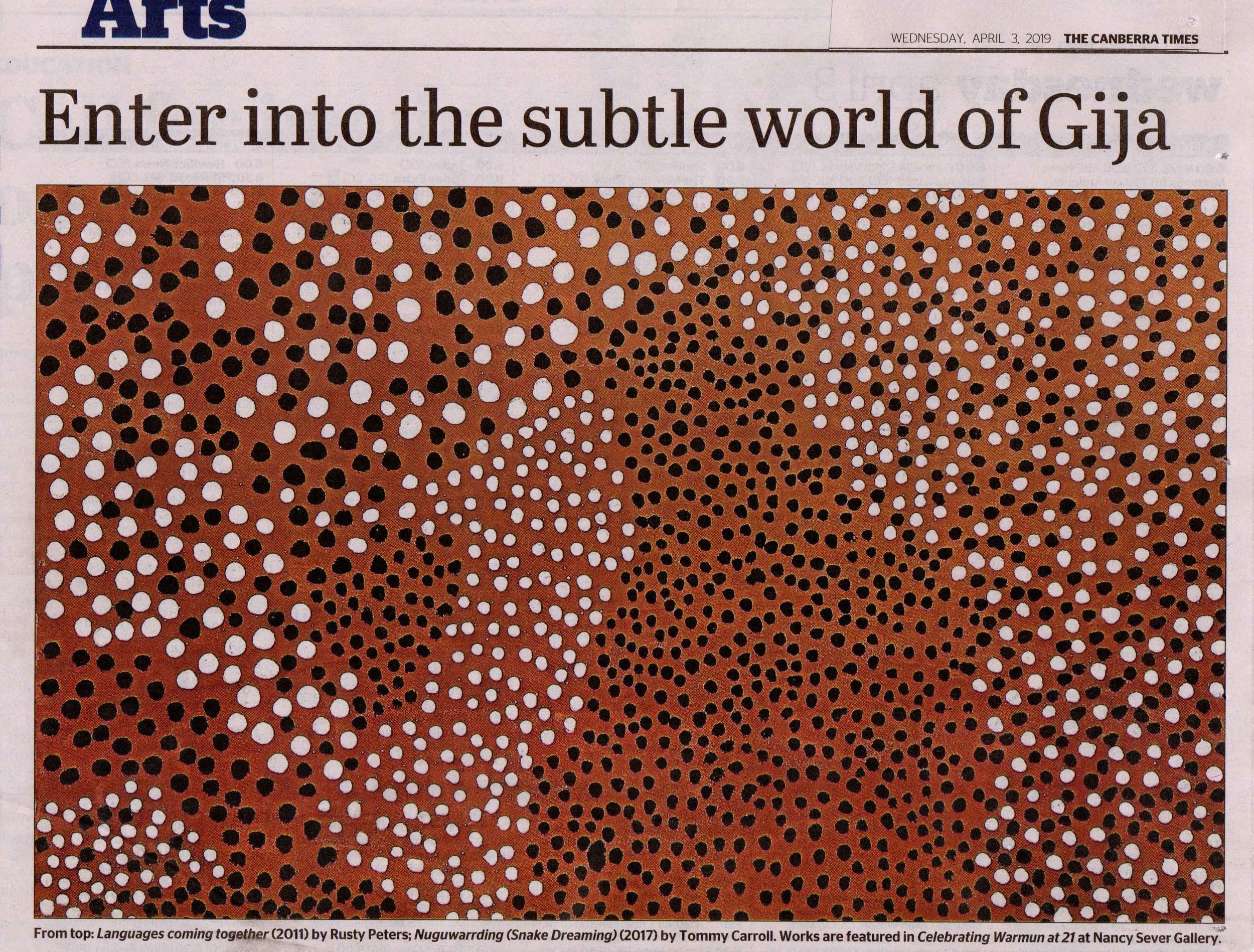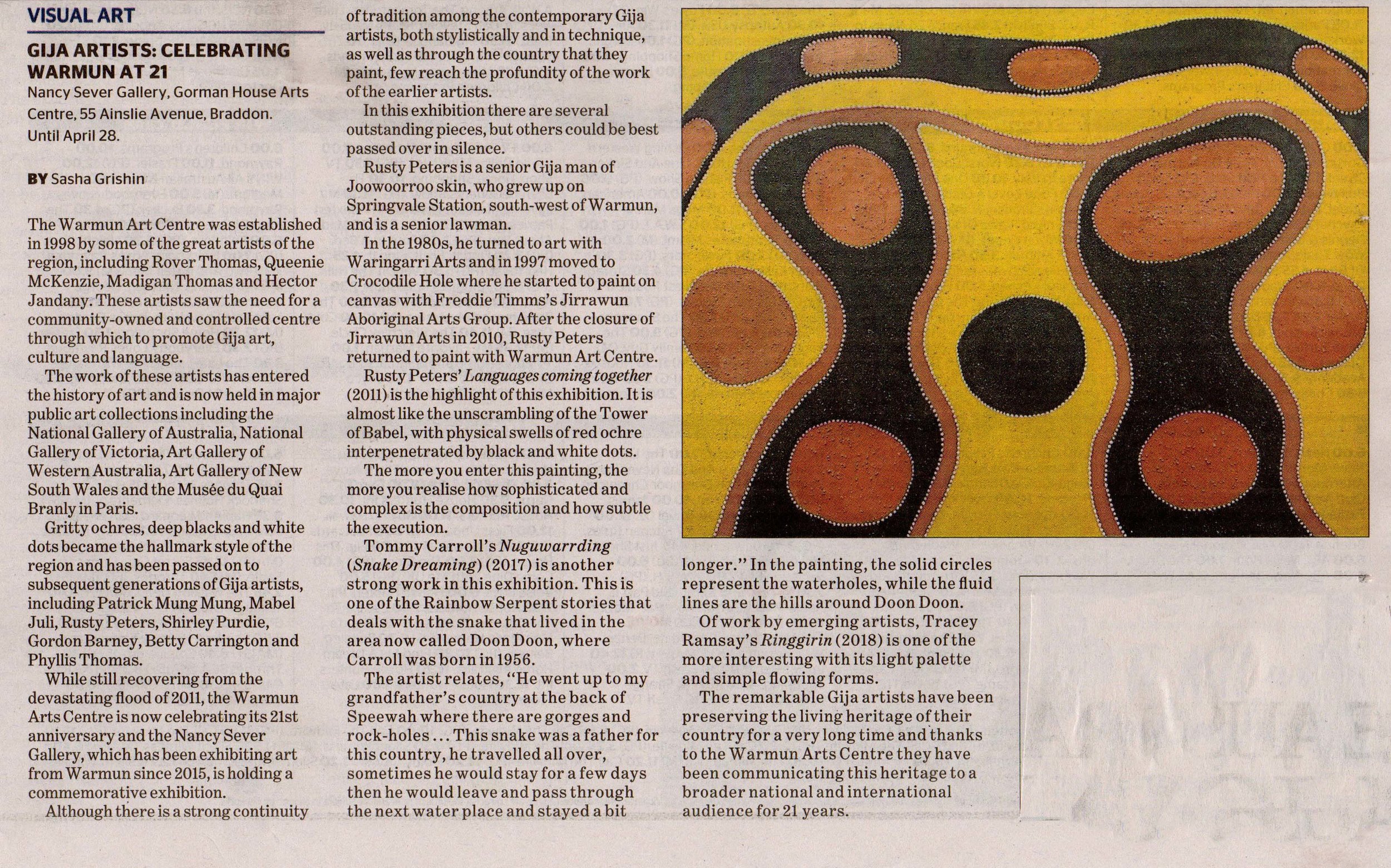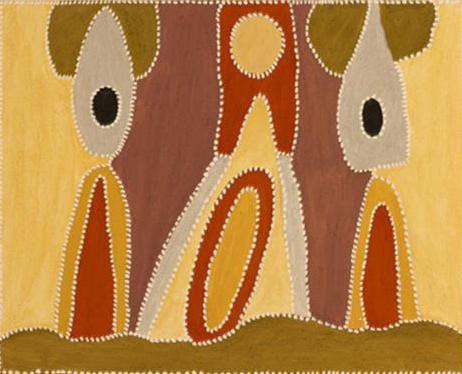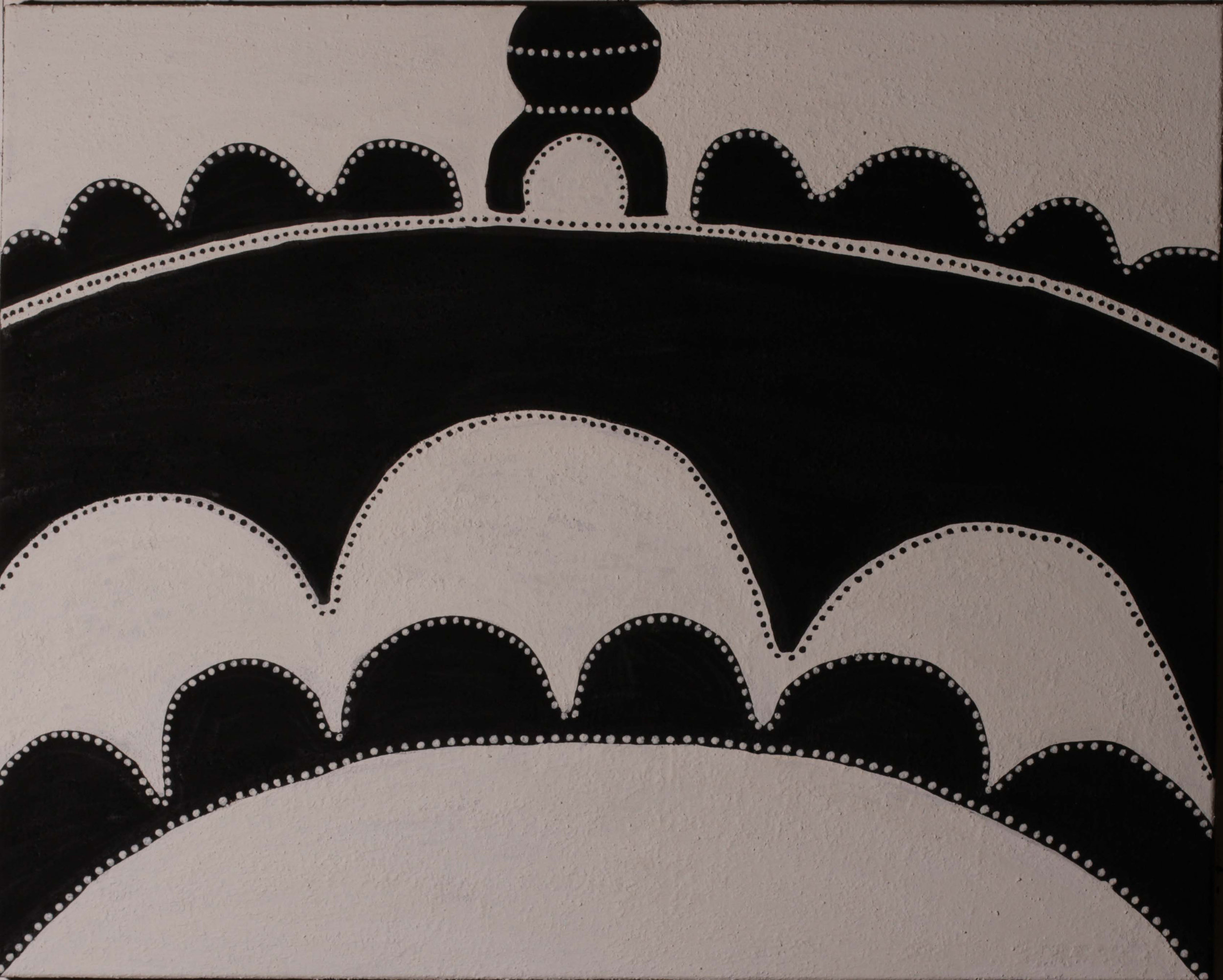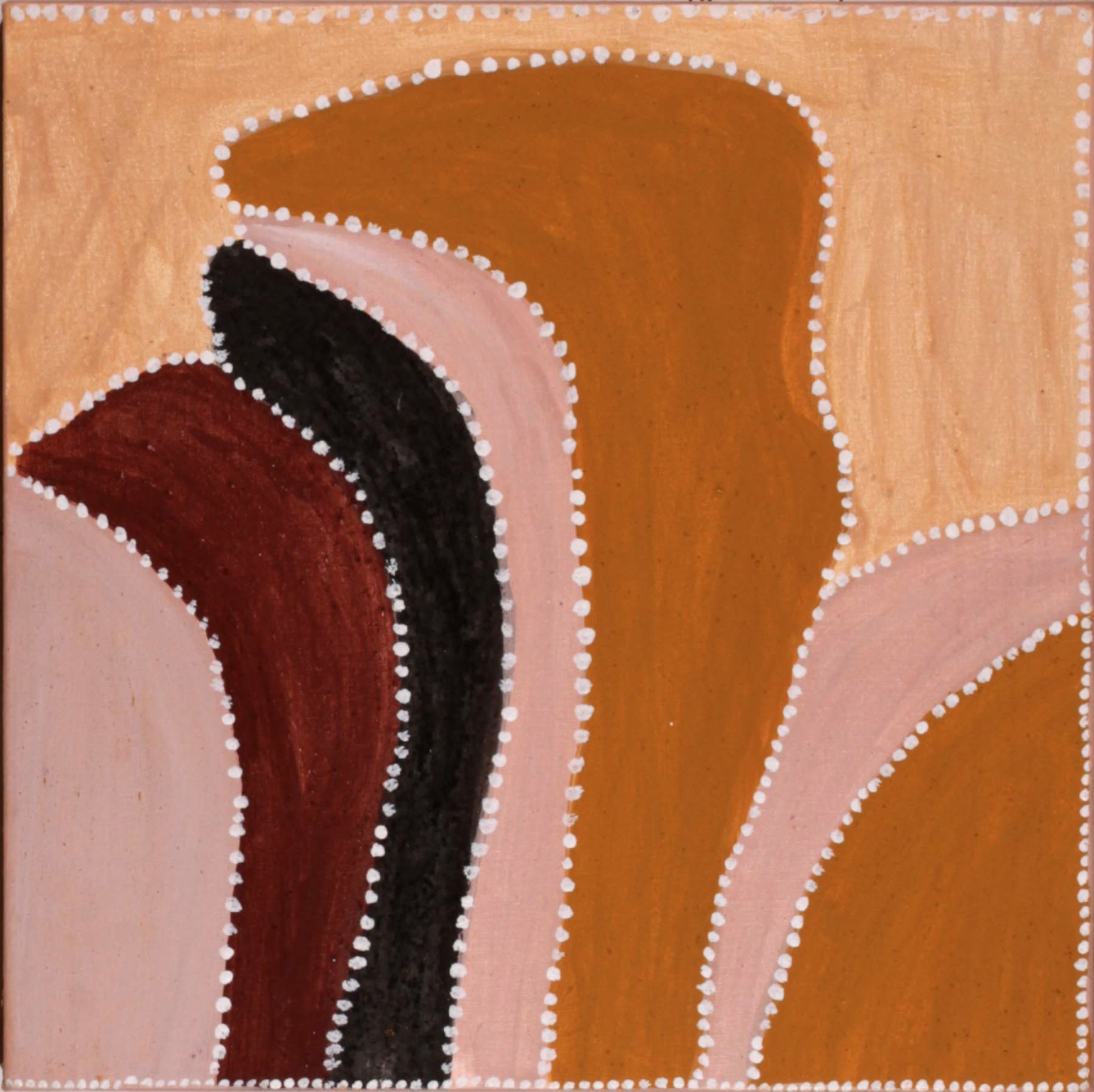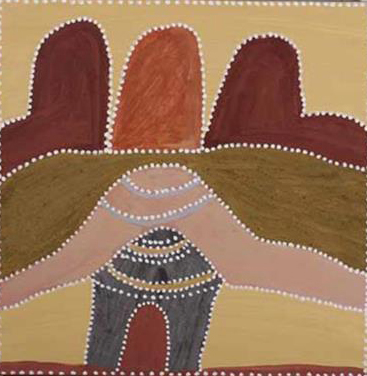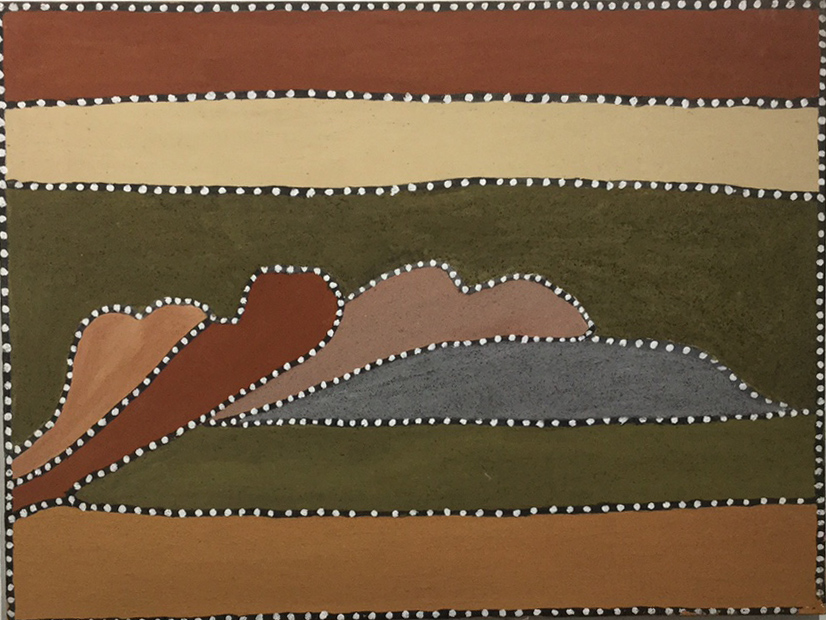THE ART OF THE GIJA PEOPLE | PAINTINGS
RUSTY PETERS, BERBEE MUNGNARI, PHYLLIS THOMAS, BETTY CARRINGTON
SADE CARRINGTON, PEGGY PATRICK, KATHY RAMSAY, GORDON BARNEY
MARLENE JULI, MABEL JULI, NANCY NODEA, SHIRLEY PURDIE, LORRAINE DAYLIGHT & DAVID COX
10 MAY - 4 JUNE 2017
Artworks included in the exhibition:
(for details of the works, please click and hold cursor over the image)
Views of the exhibition

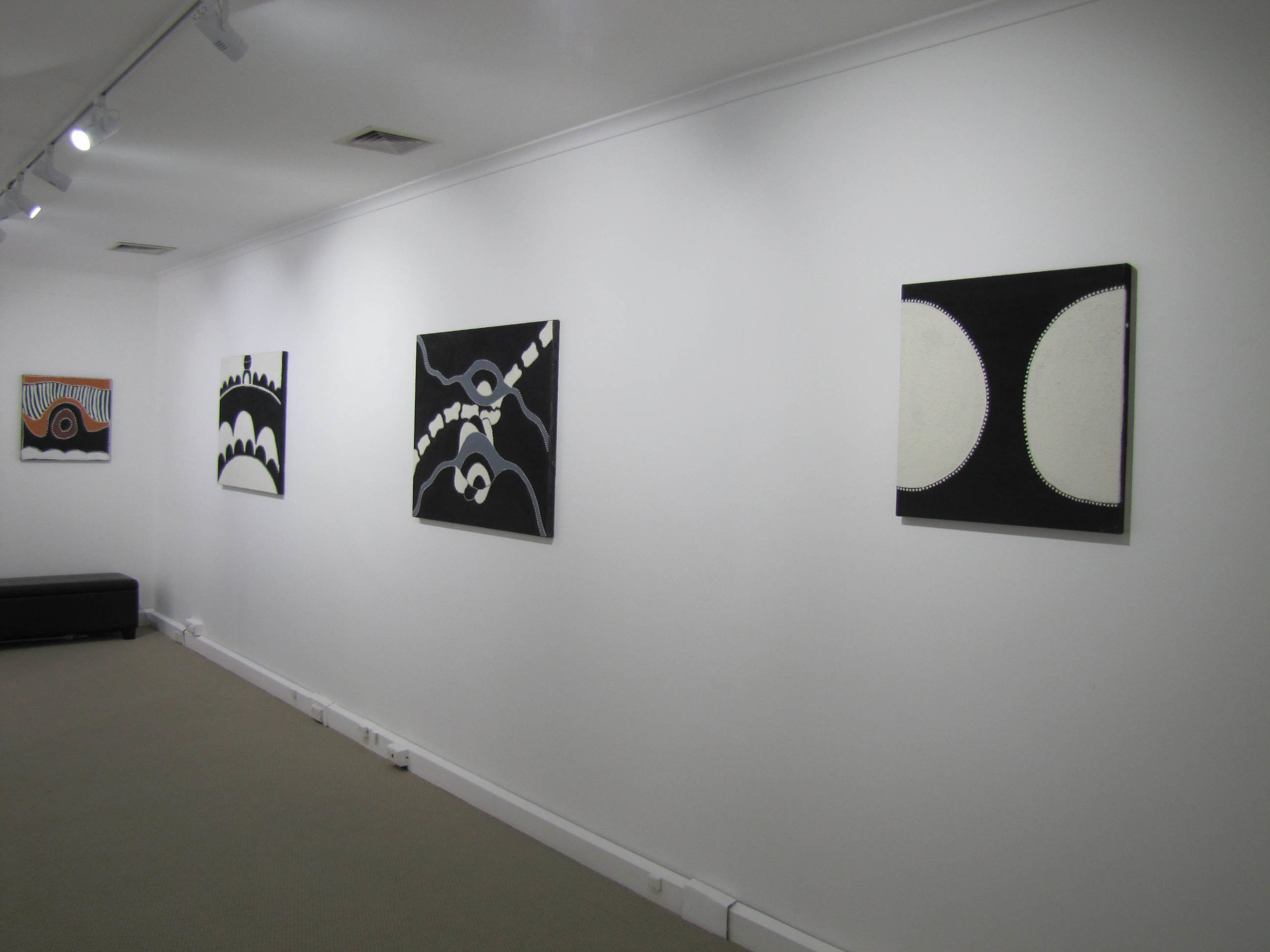
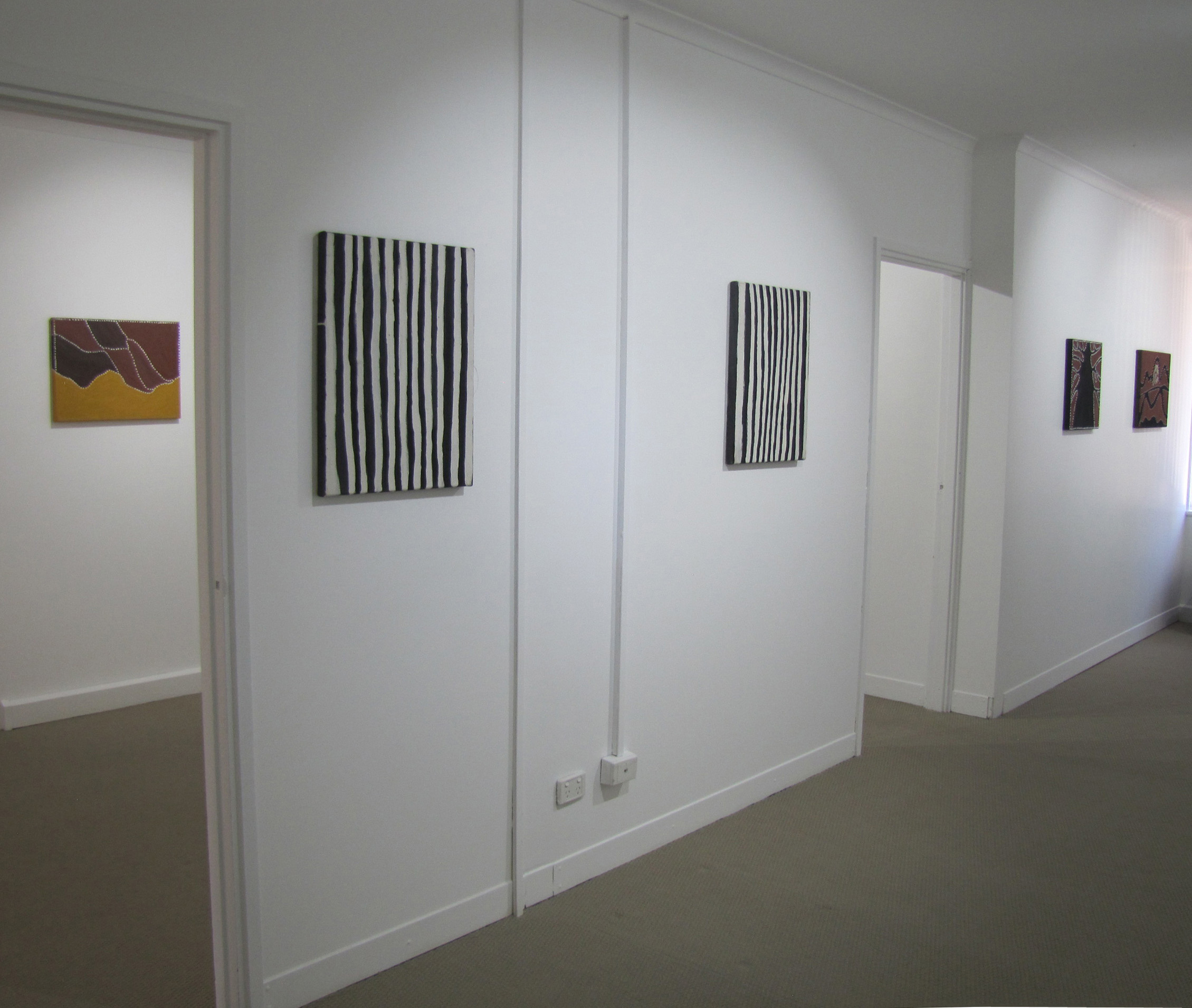
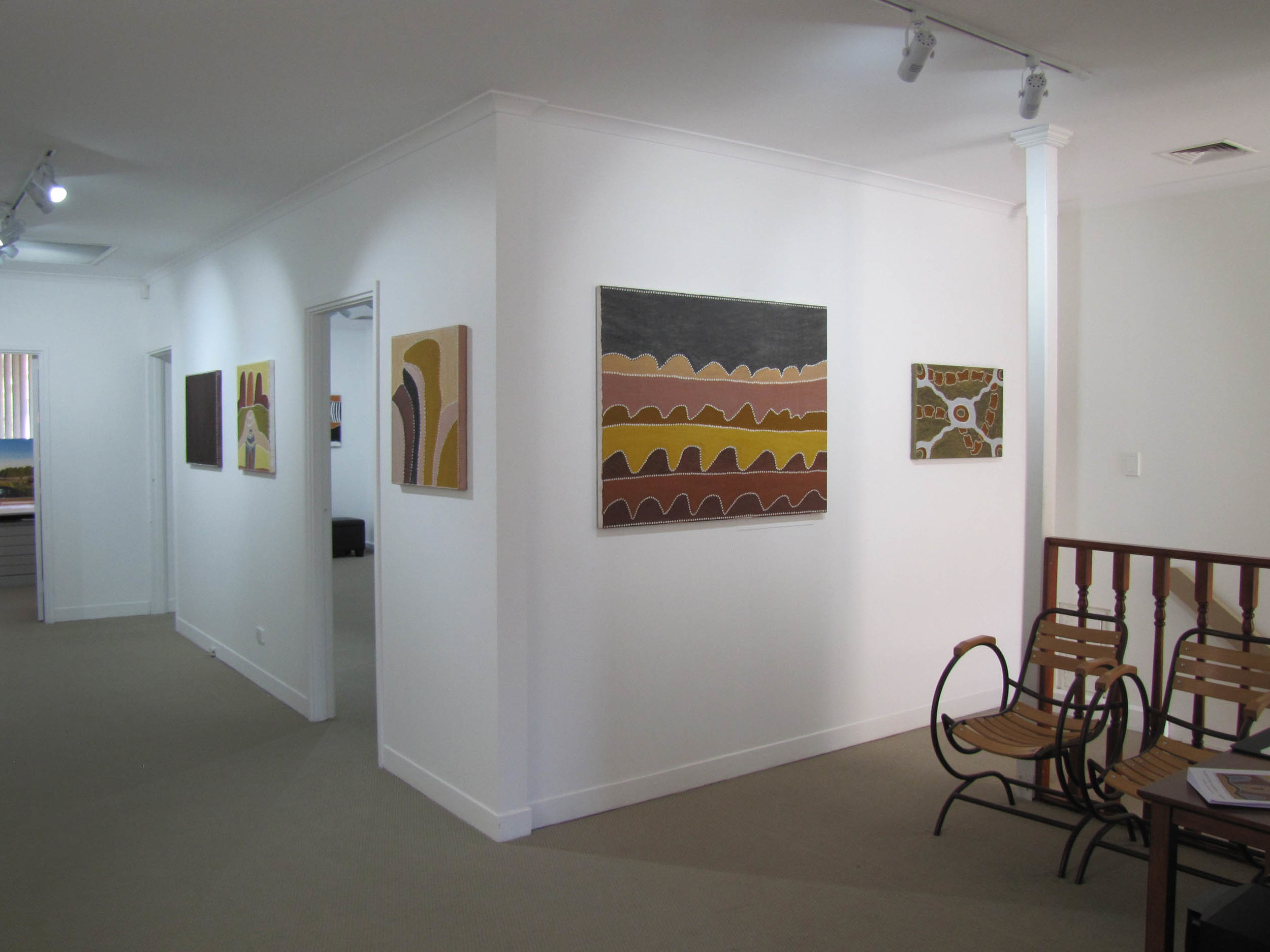
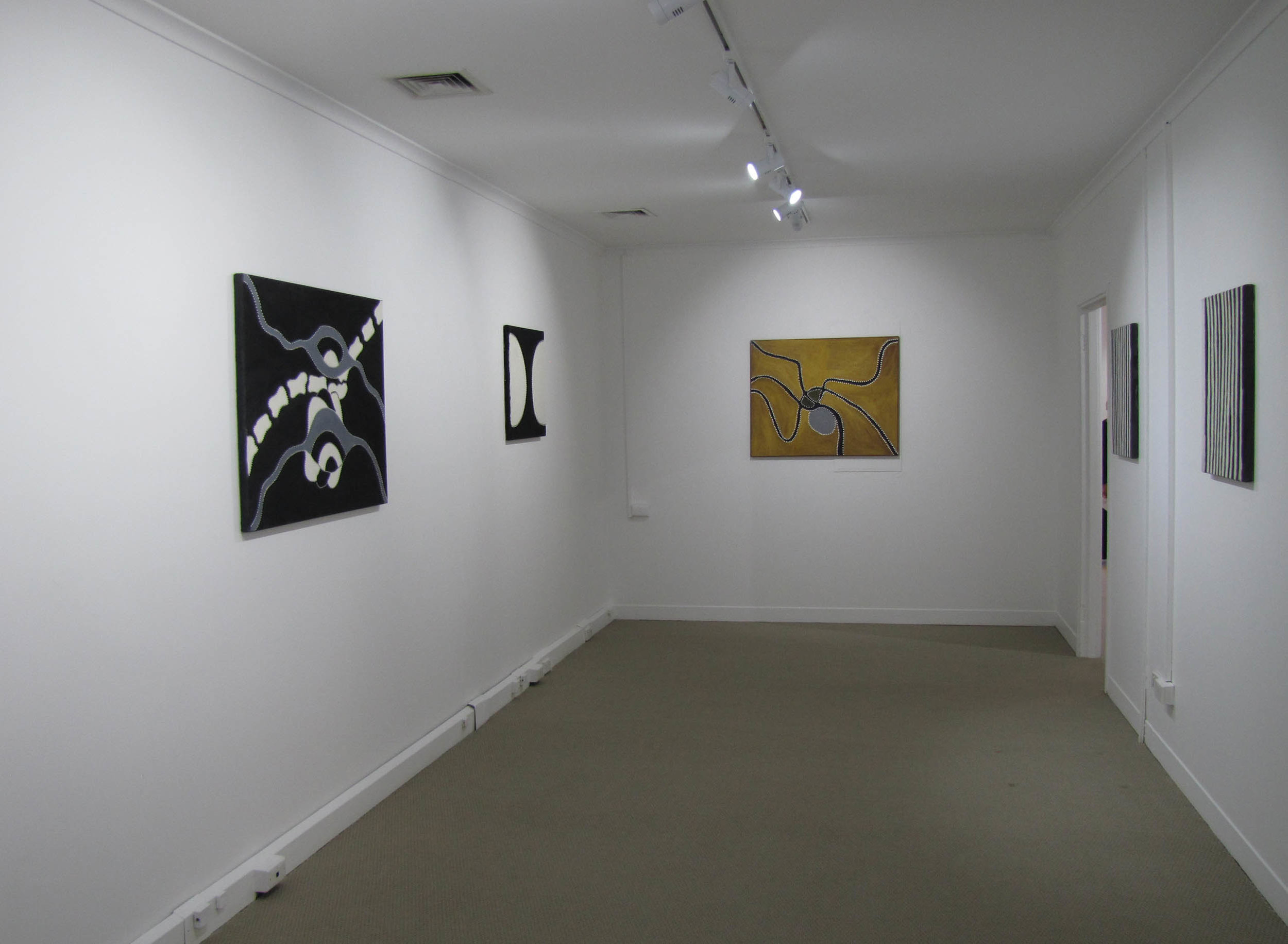
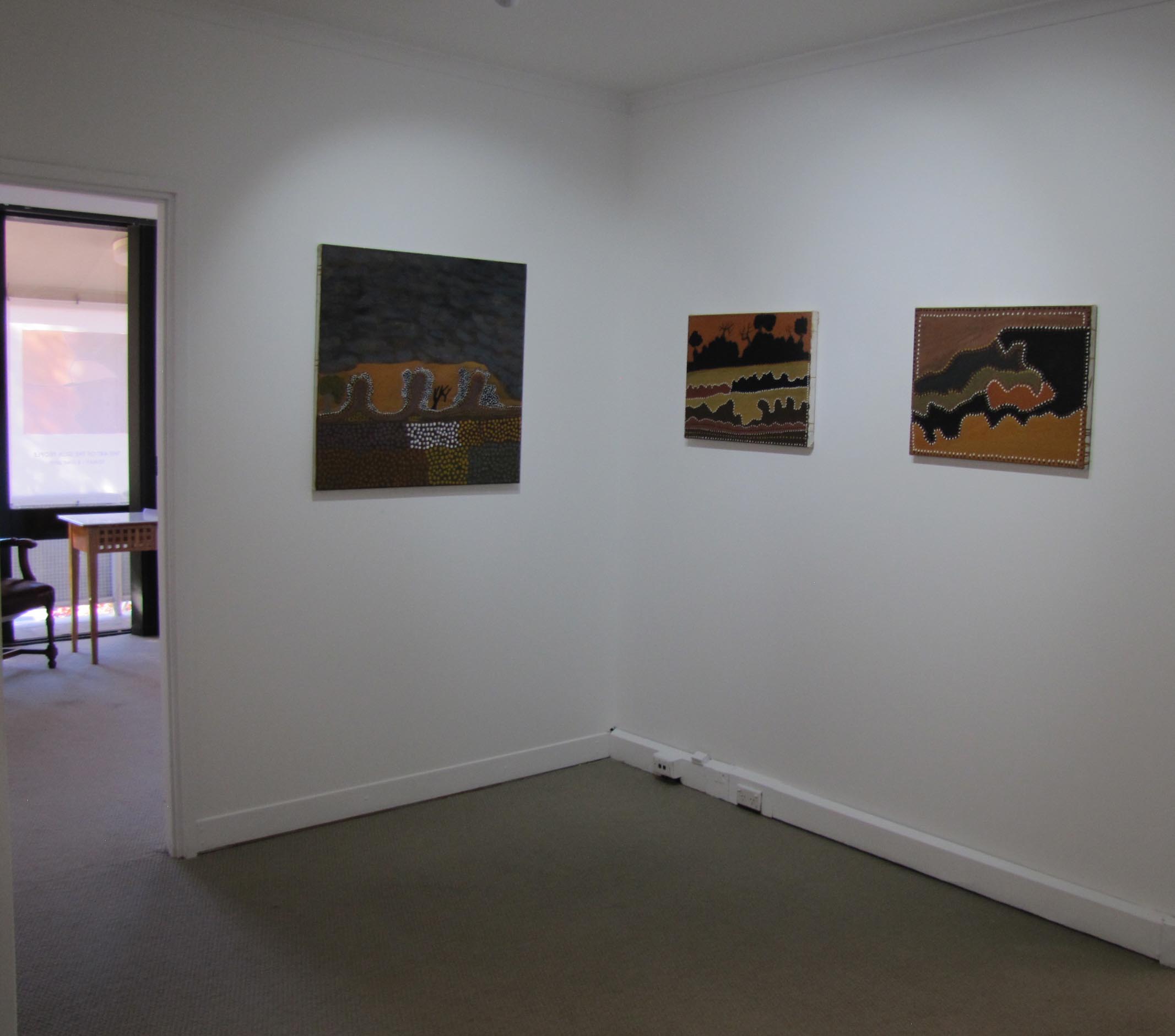
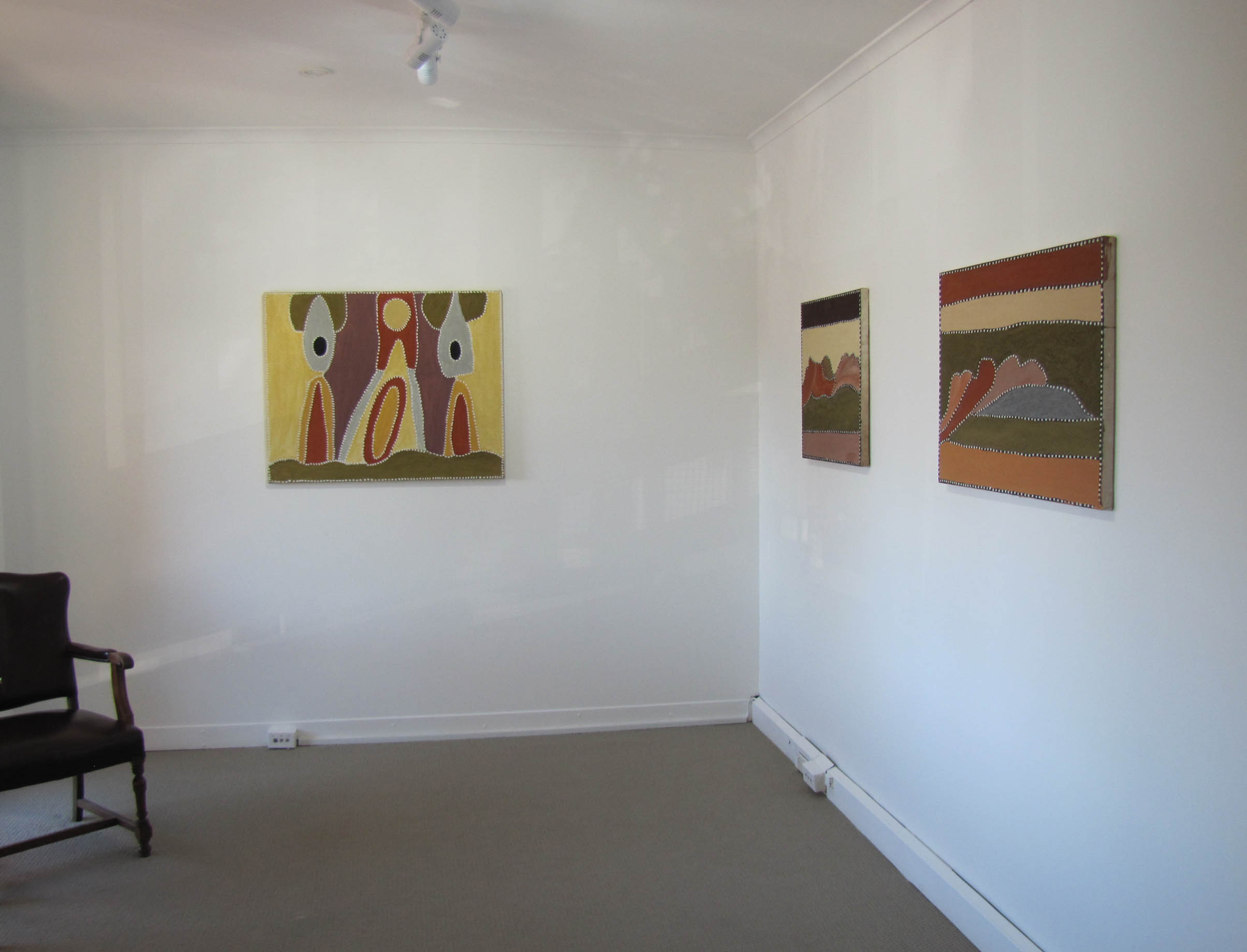
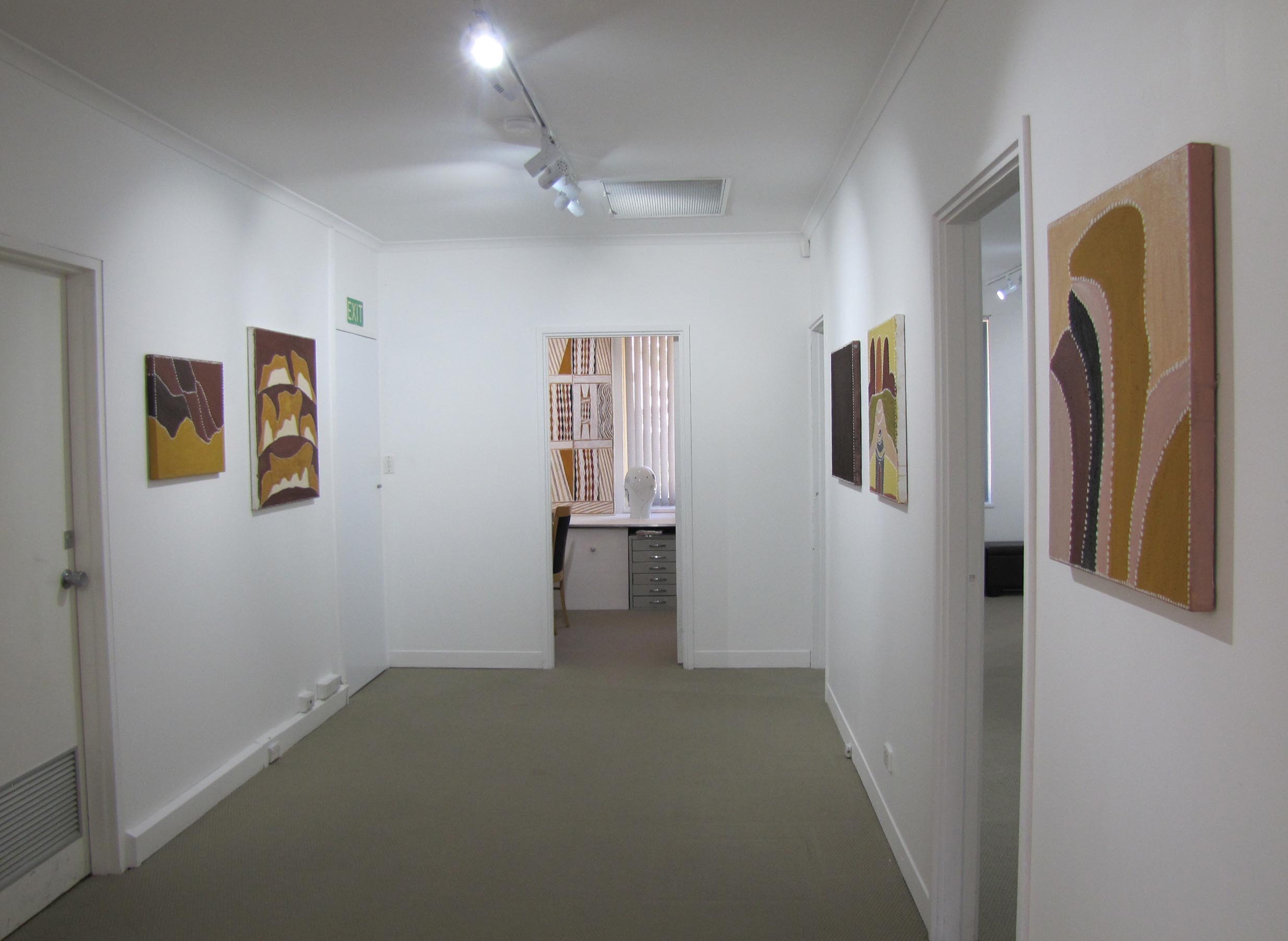
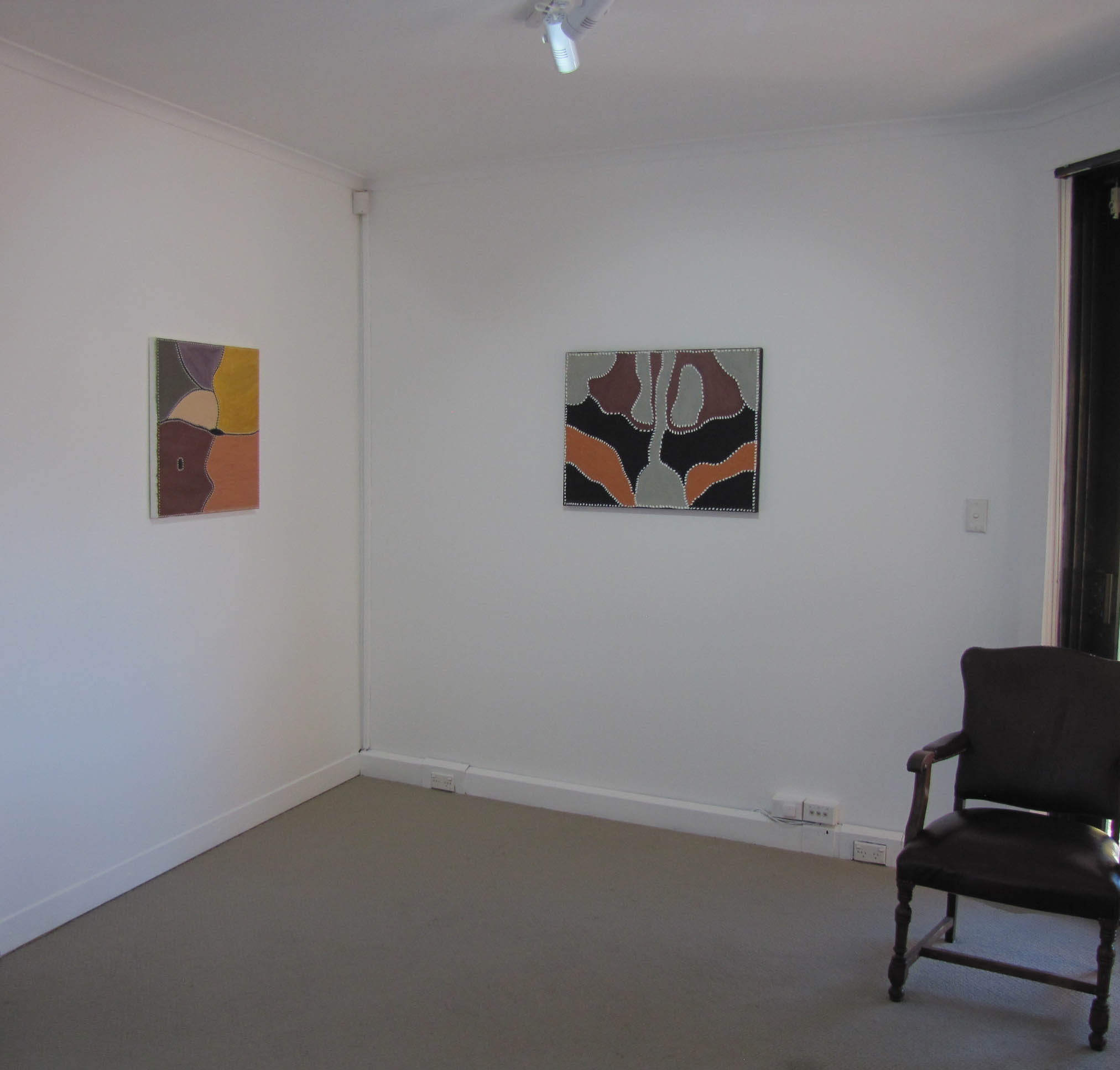

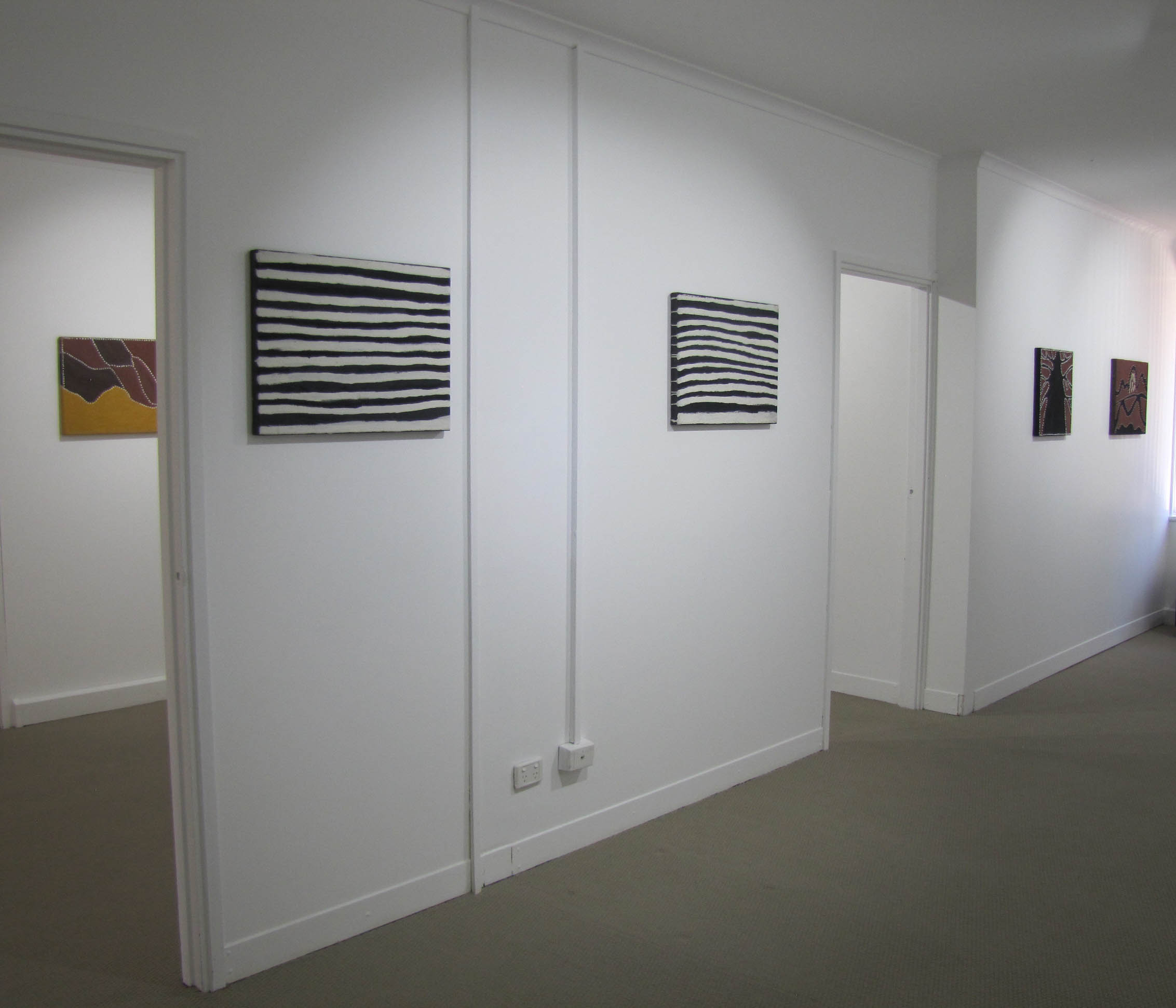
The Nancy Sever Gallery was pleased to present an exhibition of Indigenous art from the remote East Kimberley region of Western Australia. It featured the work of a group of senior Gija artists from the same community as Rover Thomas and Queenie McKenzie who have been driven to put cross-cultural communication and education into practice through art.
What connects these artists is an encyclopaedic knowledge of Gija Country, their skills as cross-cultural communicators and educators, and the desire to share their art within their own community and with audiences beyond. They use painting to depict places that are hard to access, practices that have been discontinued, and knowledge that has been shared so that it may endure. The landscape becomes the locus for a discourse that is derived from and located in memory.
The paintings are at once geographical, historical and biographical. Country is mapped with ochre to illustrate the present and the past- the artists’ personal lives and those of their ancestors. They present a rich tapestry of narratives that reveal the ngarranggarni (Dreaming). Natural forms and geographic locations articulate cultural histories. Features in the landscape such as hills, trees, rocks, waterholes and rivers appear as motifs but, in fact, represent the history of the land.
The exhibition featured the work of Rusty Peters, the late Beerbee Mungnari, Phyllis Thomas, Betty Carrington, Sade Carrington, Peggy Patrick, Kathy Ramsay, Gordon Barney, Mabel Juli, Marlene Juli, Nancy Nodea, Shirley Purdie and David Cox. It has been timed to coincide with Defying Empire: 3rd National Indigenous Art Triennial 2017, which opened at the National Gallery of Australia on 26 May 2017.
About the Artists
Rusty Peters is a senior Gija artist who was born on Springvale Station south west of Turkey Creek around 1936. Like many Kimberley artists he spent his formative years working as a stockman, boundary rider and horse breaker on various stations. After his father’s death the family relocated to Mabel Downs and later moved to Turkey Creek and then in 1989 to Kununurra, where Rusty worked at the Waringarri Aboriginal Art Centre, assisting artists, notably Rover Thomas, with whom he was to develop a life long friendship, and participating in printmaking workshops. A senior elder, formidably learned in traditional law and customs, he started painting seriously in 1997 when he joined Jirrawun Arts, the centre established by Freddie Timms, and he soon emerged as one of its leading practitioners. His intimate knowledge of the Kimberley country, gained while working in widely scattered locations, of the Ngarranggarni of Darrajayin Country, gained from his grandfather, and of the Dreamtime stories associated with these places were to form the basis of a very philosophical artistic practice, executed in a sparse mapping style and a tightly controlled narrative in traditional red and yellow ochres and black charcoal. In his recent works the artist has included non-traditional, representative elements such as a row of trees on the horizon, stockyards and a star studded night sky. This allows the viewer to consider the subject matter from two viewpoints, the pictorial with the abstract. Rusty has also participated in the Gija language maintenance program.
Phyllis Thomas is a Gija artist who was born at Riyarr on the Turner River, south east of Purnululu. When she was young, she worked on Turner Station, gardening, drawing water from the well and looking after the poultry, though she preferred to slip away occasionally into the bush, hunting and gathering with the old women. She worked on a number of cattle stations in the region before moving to Warmun where she became a Gija language and cultural teacher at the local school and art centre. Phyllis began to paint in 1998 when Freddie Timms set up the Jirrawun Aboriginal Arts group and her work achieved almost immediate success when she was represented in the National Aboriginal and Torres Strait Islander Art Awards (NATSIAA) the following year. She paints the country along the Ord and Turner rivers as well as depicting Dreaming places and bush tucker from the Roogoon (Crocodile Hole) area. A characteristic element in many of her paintings are the boab trees that grow at Crocodile Hole. She is represented in the Parliament House Collection in Canberra, the Art Gallery of Western Australia and in private and corporate collections throughout Australia and overseas.
Peggy Patrick,OAM was born in East Kimberley about 1930 and has lived through the profound social changes brought about by the first contacts between her people and Europeans. In 1924 her mother witnessed the massacre of her parents (Peggy's grandparents) and other family members by settlers bent on seizing the fertile plains of the Kimberley frontier. The stories of the 'killing times' were long hidden away but Peggy has never hesitated to confront the region's violent past. As Creative Director of the Neminuwarlin Performance Group she helped to develop and performed in Fire, Fire Burning Bright, a stage show at the Perth and Melbourne International Arts Festivals in 2002 that told the story of the Bedford Downs massacre. Despite this family tragedy, Peggy has always been a strong advocate for reconciliation, in recognition of which she was made a Member of the Order of Australia in 2010. As well as being a senior Gija artist she is respected singer, dancer and storyteller. She has also been a formidable representative of the Gija people on the Kimberley Land Council, serving for nine years as the Chairperson of the Gooda Community and negotiating for Aboriginal rights in the Argyle Diamond Mine agreement. She generally participates in group shows with other Warnum artists, rather than in solo exhibitions.
Mabel Juli was born about 1933 near Moola Boola Station south of Warmun in Western Australia. As a young woman she moved to Springvale Station. There, in the mid-1980s, Rover Thomas encouraged her to paint and Queenie McKenzie taught her. Her brother, Rusty Peters, is also an accomplished artist. Using earth pigments or acrylic on canvas Mabel mostly paints the Dreaming stories of her Darrajayin country. The stories that her parents taught her when they took her to their ancestral lands – Karnkiny, Glingennayn, Marranji and Jiyirinny – also feature in her work. She is a law and culture elder to her people and an important ceremonial singer and dancer.
Marlene Juli was taught to paint by her mother, the well known artist Mabel Juli. She paints many of the stories and landscapes of her maternal grandfather's country, Springvale Station, which lies south west of the Warmun community. For a young person who has not lived in her family's traditional lands, she has a strong knowledge of the Ngarrangkarno (Dreaming) stories of her grandfather’s country because she has visited her family's country with her mother Mabel, where she has been shown significant dreaming places and told the stories of her family's country. Marlene's style is intricate and precise, with detailed patterning and dotting in her work.
Gordon Barney was born at Birrno (Alice Downs Station) in the East Kimberley in 1944 and now lives at Norton Bore Community, via Turkey Creek. His wife, the well known senior Warmun artist, Shirley Purdie, encouraged him to take up painting in 1998 when the Warmun Art Centre commenced operation. He is well known in the Warmun community as a strong law and culture man and an important ceremonial dancer. He is a skilled horse breaker and rodeo rider and he still works as a stockman. He favours painting with natural ochres and he carries a saddlebag on his rides in which he collects the different ochres he encounters. The subject matter of his paintings is quite varied. He depicts the hills and rugged country of the cattle stations where he worked for many years. He also paints the Magoombarrany, Boorlnginy, Yarangga (Katie’s Yard), Laboony and Joorroomi country, and interprets the landforms and the ngarrangkarni (Dreaming) stories of Birrno. His style is characterised by his use of line and empty space.
Nancy Nodea began painting in 1994, guided by Rover Thomas and Queenie McKenzie. She has explored events that occurred in the East Kimberley over the past two hundred years since European settlement. She is one of the strongest historical painters in the East Kimberleys but she also paints her beloved Texas Downs Station country.
Betty Carrington uses a large range of subtle ochre colours, her delicate palette and style often describing strong and painful stories of historical events in the East Kimberley. One recurring visual reference in her paintings are the rolling hills of her father's country, Darrajayin (Springvale Station). She also paints landscapes from her mother's country, Texas Downs Station, as well as ngarranggarni (Dreaming) places.
Sade Carrington was born Texas Downs Station, East Kimberley in 1957. Her parents Betty Carrington and Beerbee Mungnari are also artists. She was sent to school at Beagle Bay when she was four, then to Perth to complete her education. She worked in the homestead at Texas Downs until 1980, when she joined her relatives at Warmun (Turkey Creek). Sade married Churchill Cann, then head stockman at Texas and now an artist with an international reputation. She has travelled extensively with her art, both throughout Australia and overseas. She has exhibited in London and the Netherlands and was invited to stay for six months at art institutions in Holland to demonstrate her technique in ochre painting. Sade's paintings pay respects to her country and to the connection she was taught primarily by her mother Betty Carrington. She brings to her work her experience and awareness of the contemporary international art world, which she combines with an intimate knowledge of Gija culture, history and language.
Kathy Ramsay is the daughter of artists Rammey and Mona Ramsay, and the granddaughter of the late Timmy Timms. Of her work she says, "I only started painting in 2013. I like to join in and to be sharing a part of my Country. My mother and my grandfather always told us what this place means, what the names are, and all those Ngarranggarni (Dreaming) stories. Now, with all this painting, I'll be the one to tell them to my kids. I just paint what my old people told me about our Country – because they are the ones who know the history of our Country, the Country we’re still connected to today. Our Country really knows us, and it owns us’. Kathy paints her ancestral Country around Bow River, incorporating rich Ngarranggarni stories with recent histories of station life.
Shirley Purdie was born in 1948 at Mabel Downs Station, in Western Australia's Kimberley region and moved to Warmun, where she now lives and paints. She is married to artist Gordon Barney. Shirley was taught to paint by her mother and by the major Kimberley indigenous artist Queenie McKenzie. She has won several awards, including the Blake Prize for Religious Art in 2007. Her works are held by major galleries, including the National Gallery of Australia.
David Cox was born in Derby, in the north west of the Kimberley region. His family is from Yiyili, between Fitzroy Crossing and Halls Creek. He came to paint at Warmun after marrying a Warmun woman. He is part of a younger group of artists at Warmun who have an intense interest in the Dreaming stories of their ancestors and who are keen to explore new ways of communicating these stories to members of their own Warmun community as well as to the wider Australian community. David learnt to paint under the instruction of Churchill Cann, whose aerial approach to viewing the landscape and use of fine sweeping strokes using natural ochres have greatly influenced David's work.
Beerbee Mungnari was born at Waterloo Station in the Northern Territory in 1933. He lived most of his life on various stations in the East Kimberley region, working as a stockman. He had many stories of the country south and east of Kununurra before the Argyle Dam was built. He started to paint in 1982, the same year that the school at Warmun was founded. His style and method were unique and immediately recognisable amongst the work of other Warmun artists. His interest in and love of country were the major influences on his landscapes. He died in 2013.
RECENT PAINTINGS BY SENIOR GIJA ARTISTS FROM WESTERN AUSTRALIA
RUSTY PETERS, PEGGY PATRICK, PHYLLIS THOMAS
From the remote East Kimberley region of Western Australia comes the art of three of Australia’s leading painters: Rusty Peters, Peggy Patrick and Phyllis Thomas. All three are senior Gija artists whose lives have been driven by the need to put cross-cultural communication and education into practice through art. The exhibition has been curated by the Nancy Sever Gallery and the Warmun Art Centre in Western Australia where the artists live and work.
What connects these artists is an encyclopaedic knowledge of Gija Country, their skills as expert cross-cultural communicators and educators, and the desire to share their art within their own community and to audiences beyond. Exploring vast areas of the spectacular Gija Country including Bow, Ord and Turner rivers, Roogoon (Crocodile Hole) and Darrajayin (Springvale Station) these works present a rich tapestry of narratives that reveal the contemporaneity of the Ngarranggarni (Dreaming) amidst the currents of colonisation.
RUSTY PETERS
Is a senior elder, incredibly learned in traditional law and customs. He started painting in 1997 with Freddie Timms and Paddy Bedford and now has a high international profile, with his works in many major collections and museums around the world. His intimate knowledge of the Ngarranggarni of Darrajayin Country, gained from his grandfather while growing up and working on Springvale station, form the basis of a very philosophical artistic practice. His recent work is characterized by an increasingly distinct and sophisticated visual language. This is evident in the subtle textures he works hard to develop in natural ochre in order to illustrate his Country in a way that merges the pictorial with the abstract.
PEGGY PATRICK
Who has an Order of Australia, is a very senior law, song and culture woman with a strong exhibition and performance history. She was central to the development of Fire Fire Burning Bright, a Gija and Worla coroborree that travelled to Perth and Melbourne International Arts Festivals. A formidable representative of the Gija people on the Kimberley Land Council, Peggy served for nine years as the Chairperson of the Gooda Gooda Community and negotiated for Aboriginal rights in the Argyle Diamond Mine agreement.
PHYLLIS THOMAS
Phyllis Thomas is also a senior Gija law woman. She began to paint in 1998 when Freddie Timms set up the Jirrawun Aboriginal Arts group and her work achieved immediate success. She paints the country along the Ord and Turner rivers as well as depicting Dreaming places and bush tucker from the Roogoon (Crocodile Hole) area and the world heritage listed Purnululu. A characteristic element in many of her paintings are the boab trees that grow across the East Kimberley and are connected to traditional birthing practices.



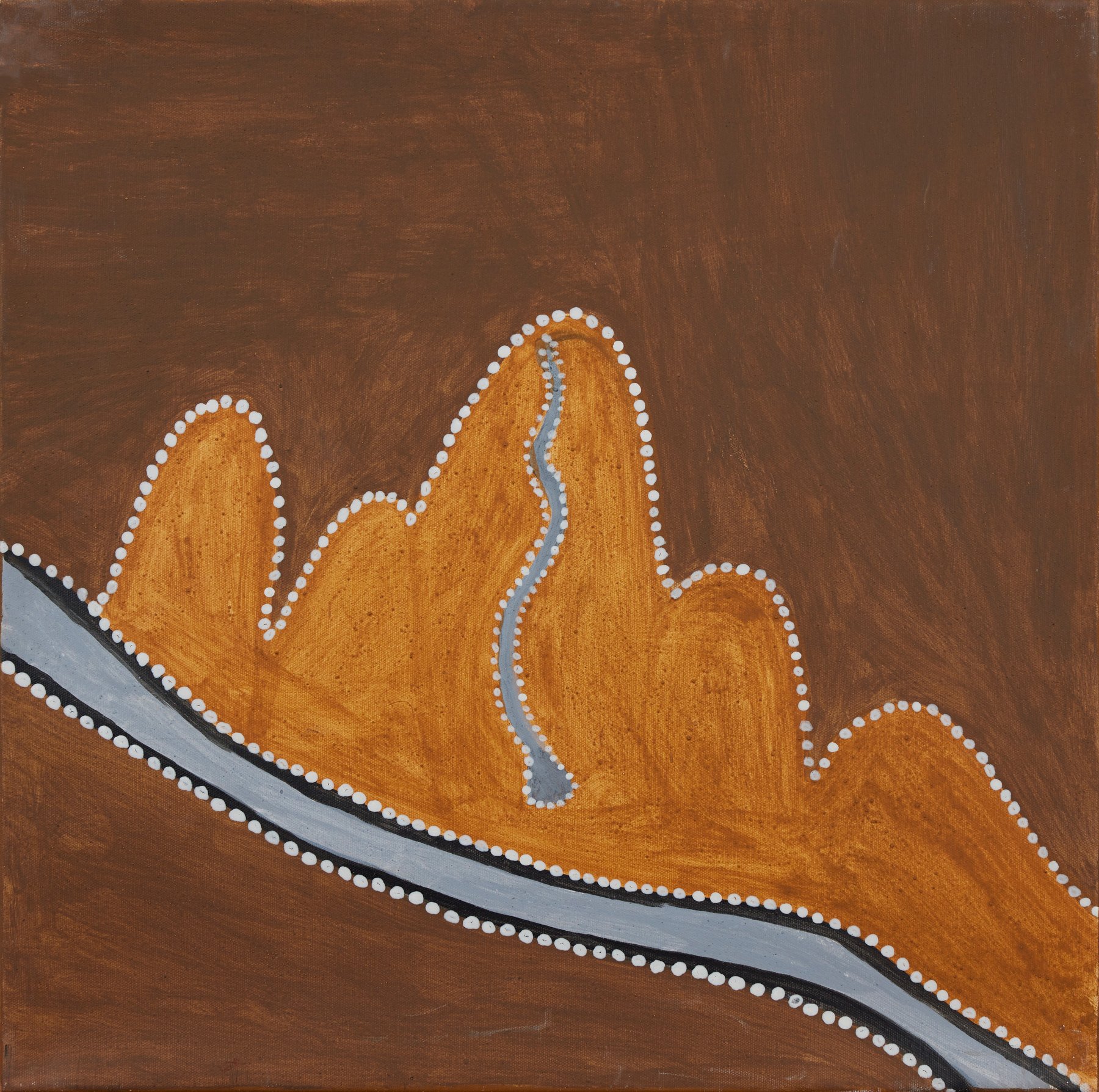












![Tommy Carroll. Nuguwarrding [Snake dreaming], 2016. Natural ochres and pigments on canvas, 80 x 100 cm. $4,000](https://images.squarespace-cdn.com/content/v1/53952921e4b048e4728469ca/1654914245780-20FB1U76CFAL97W3AA39/ART_4716.JPG)






